Joint issue Serbia – Indonesia
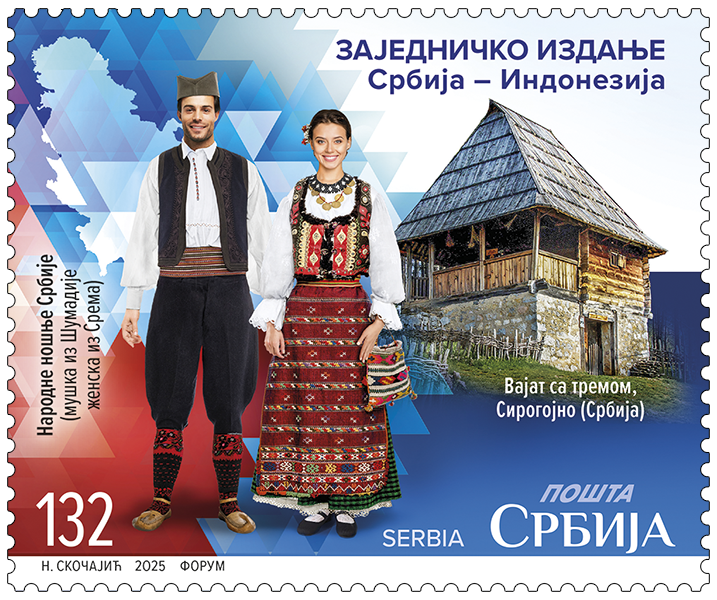
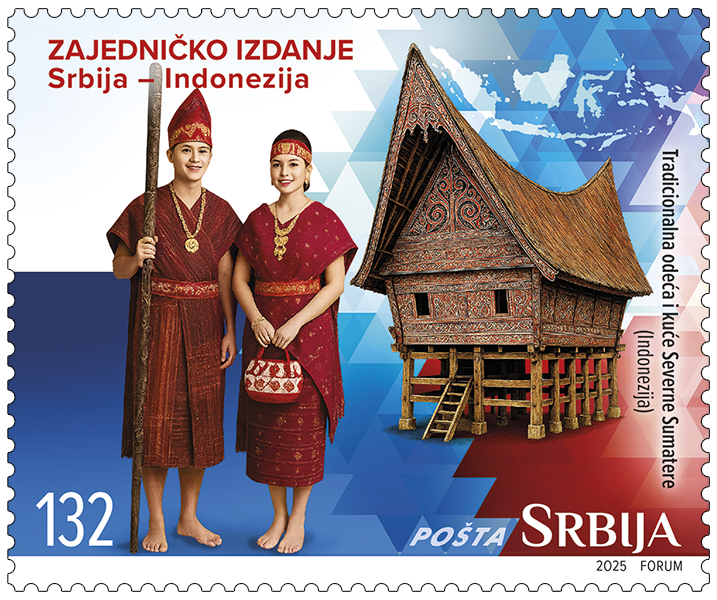
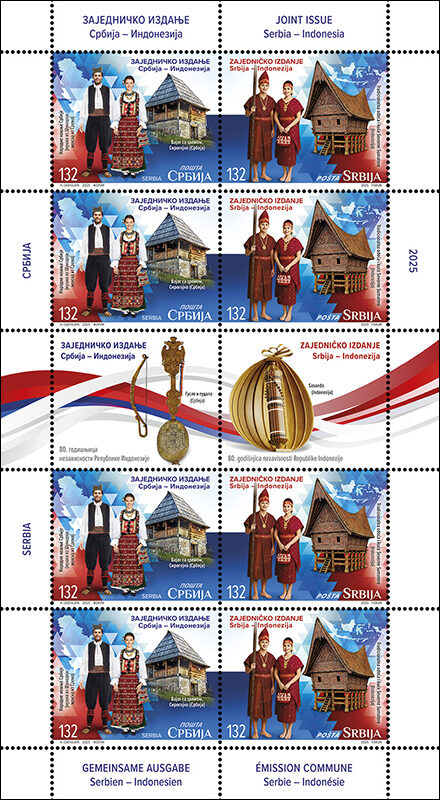
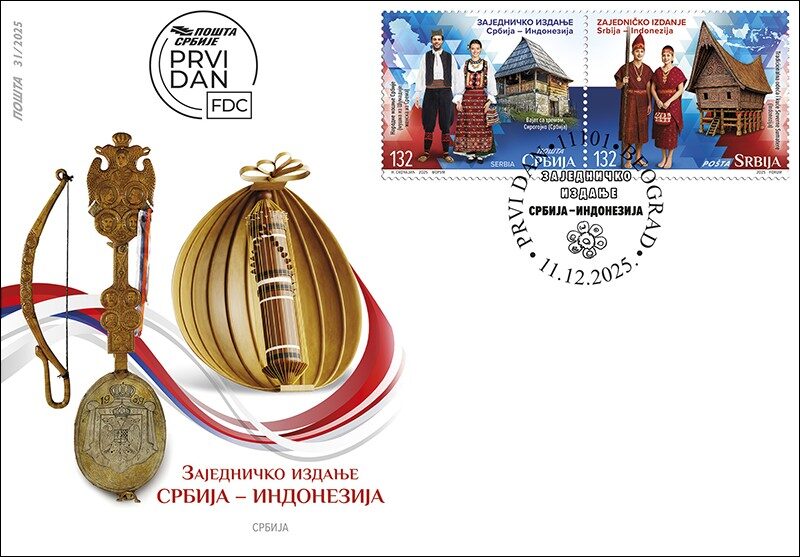
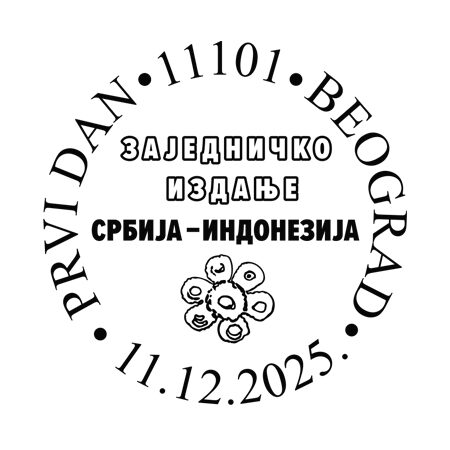
A joint stamp issue between two countries is always an exceptional opportunity to reaffirm and deepen their friendly relations. Through postage stamps, countries communicate with ease, regardless of geographic distance or differences in language. On this occasion, the connection between Serbia and Indonesia is represented through elements of the cultural heritage of both nations: traditional folk costumes and houses depicted on the stamps, as well as musical instruments featured on the vignettes and the commemorative cover.
The traditional women’s costume from Srem (Vojvodina, Serbia), dating from the late 19th century, represents a rich and functional ensemble that reflects the clothing characteristics of Slavic peoples, combined with later elements typical of the wider Pannonian cultural area. The men’s Šumadija folk costume, characteristic of the late 19th and early 20th centuries, consists of a cap (šajkača) as an essential element, breeches trousers, a shirt, a woven belt, a vest (jelek), woolen socks and leather opanci. Over time, this type of attire came to carry a strong national connotation and became a recognizable symbol of traditional Serbian dress. The costumes depicted on the stamps come from the permanent exhibition of the Ethnographic Museum in Belgrade (photo: Vuk Nenezić).
A Vajat with a porch from the village of Alin Potok (1890), is preserved at the open-air museum “Old Village” in Sirogojno (Zlatibor Mountain). Vajati are small buildings traditionally used by younger married couples within extended family households for sleeping and storing their personal belongings. The museum complex comprises 50 examples of vernacular architecture, presenting the construction style, interior organization, and family life characteristic of the hilly and mountainous regions of the Dinaric area of the Balkans. It is designated as a cultural property of exceptional importance for the Republic of Serbia (photo: Tijana Jevtić).
Traditional Batak Toba attire is made from ulos, a traditional hand-woven fabric characterized by predominantly dark colors (black and red), accented with gold or silver threads and patterns that are structurally divided into sections for the head, the body, and the border. Different types and patterns are used for different ceremonies (e.g., Ulos Ragidup for major ceremonies, Ulos Sibolangi for mourning).
Rumah Bolon (Bolon House) is the traditional house of the Batak people of North Sumatra, one of the largest ethnic groups in Indonesia. It consists of two main parts: an elevated living area and a lower section used for storing crops and livestock. The saddle-shaped roof is typically made of palm fibers or thatch, while the walls are constructed from wooden planks. The interior layout is divided into several sections without permanent partition walls, with a central hearth serving as the focal point of the household. The house holds profound symbolic meaning: the high roof represents the connection with the Creator, while the strong supporting pillars symbolize the strength and unity of the family.
Expert collaboration: Ethnographic Museum in Belgrade; Open-Air Museum “Old Village” Sirogojno; Embassy of the Republic of Indonesia in Belgrade.
Stamp design featuring motifs from Serbia: Nadežda Skočajić, academic graphic artist.
Stamp design featuring motifs from Indonesia: Siswanto.
Technical details
Date of issue: 11. 12. 2025.
Number of stamps in set: 2
Denomination:
1426: 132.00 RSD
1427: 132.00 RSD
Printrun: 15.000 x 2
FDC: 1
Sheet of: 8
Dimensions of stamp: 42 x 34,8 mm
Artistic realization: Nadežda Skočajić
Subject: Joint issue Serbia – Indonesia
1426: Traditional women’s costume from Srem and A Vajat with a porch from the village of Alin Potok
1427: Traditional Batak Toba attire and Rumah Bolon
Issue format: block
Perforations: 13 3/4
Printer: Forum Novi Sad
Female Rulers of Serbia from the Nemanjić Dynasty
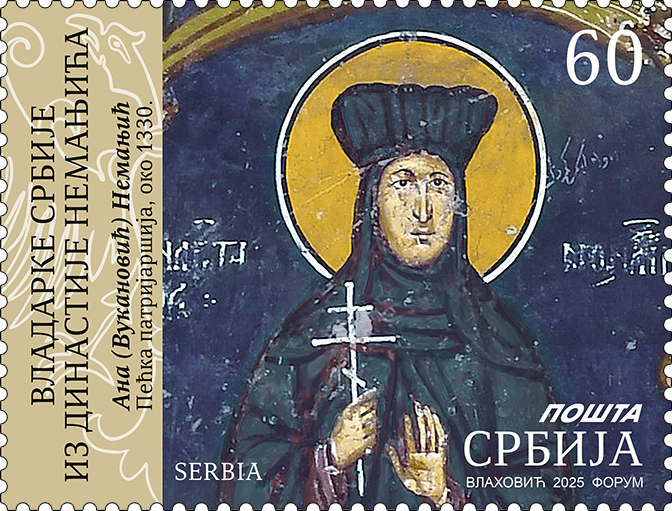
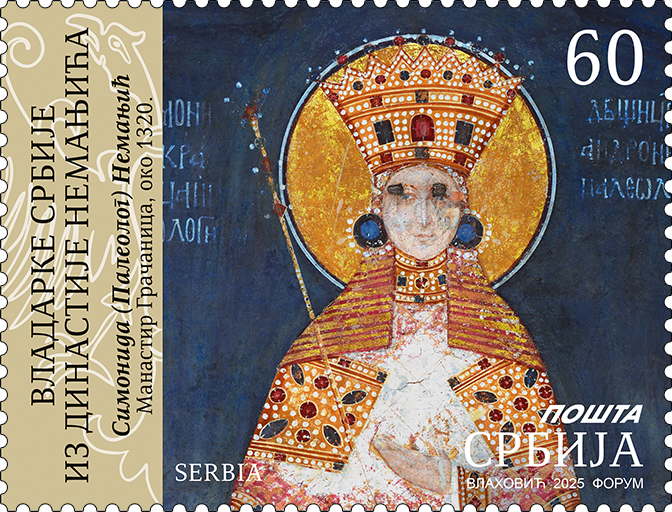
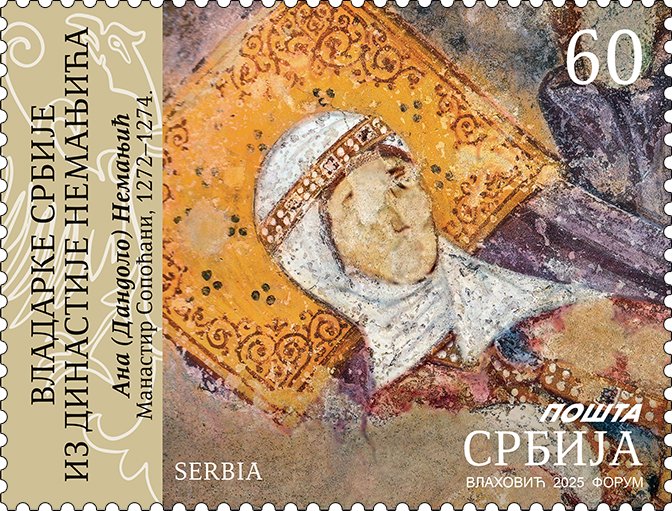
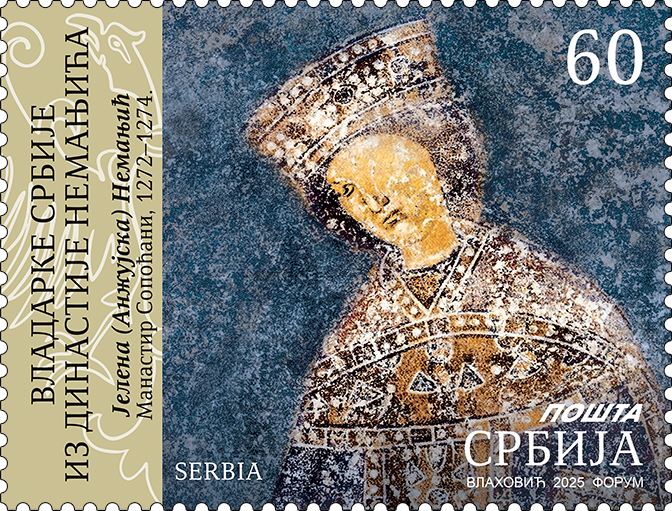
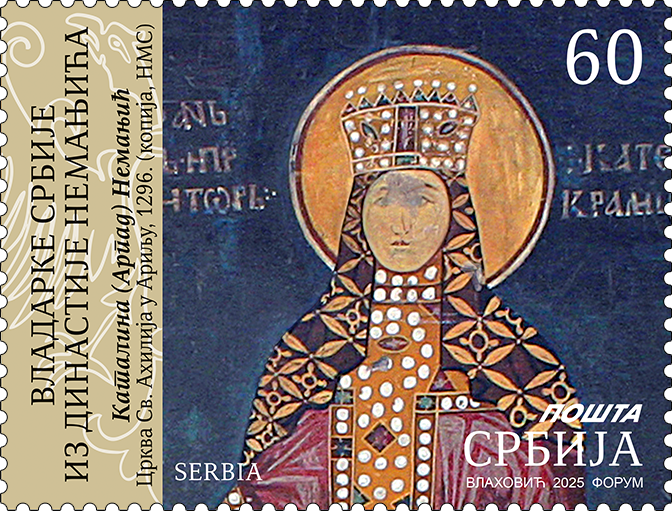
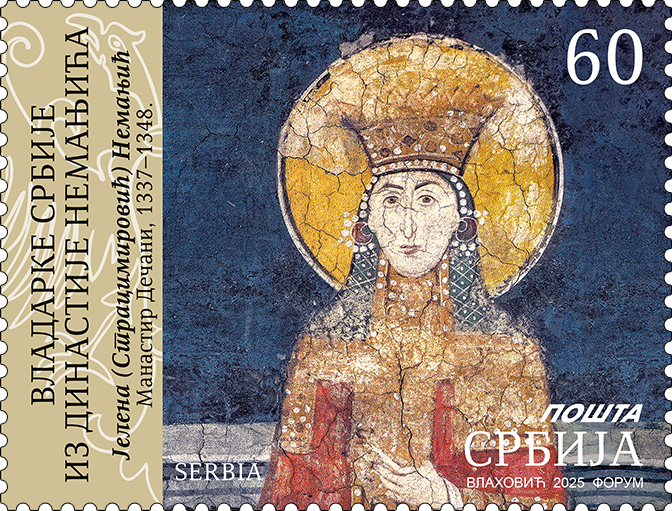

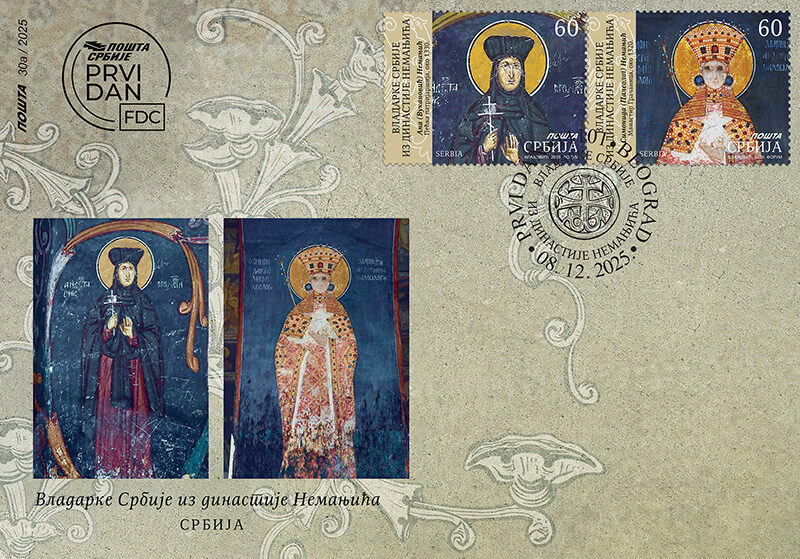
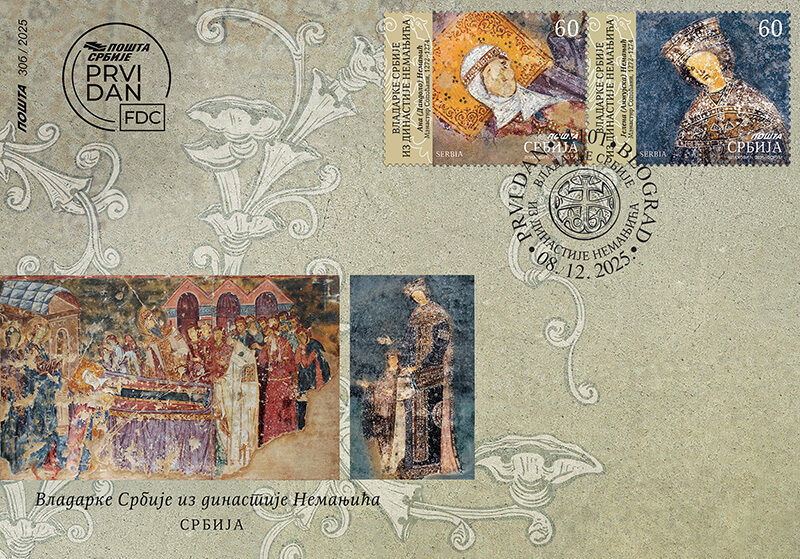
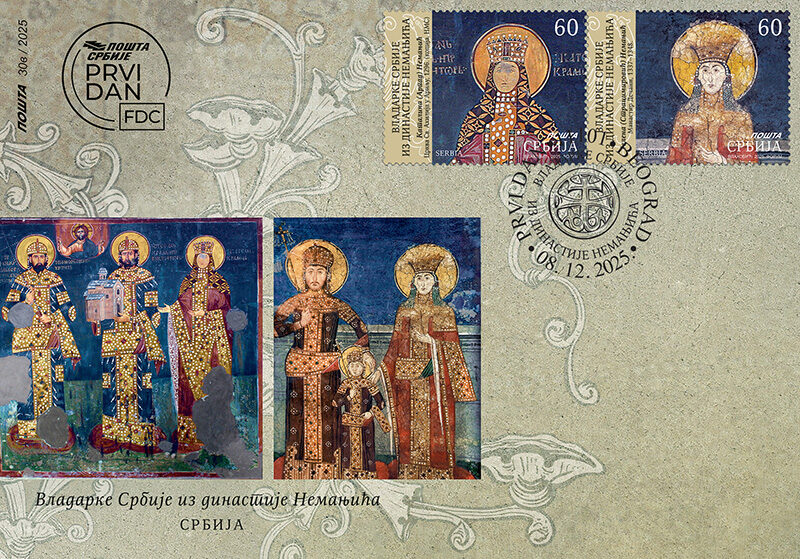
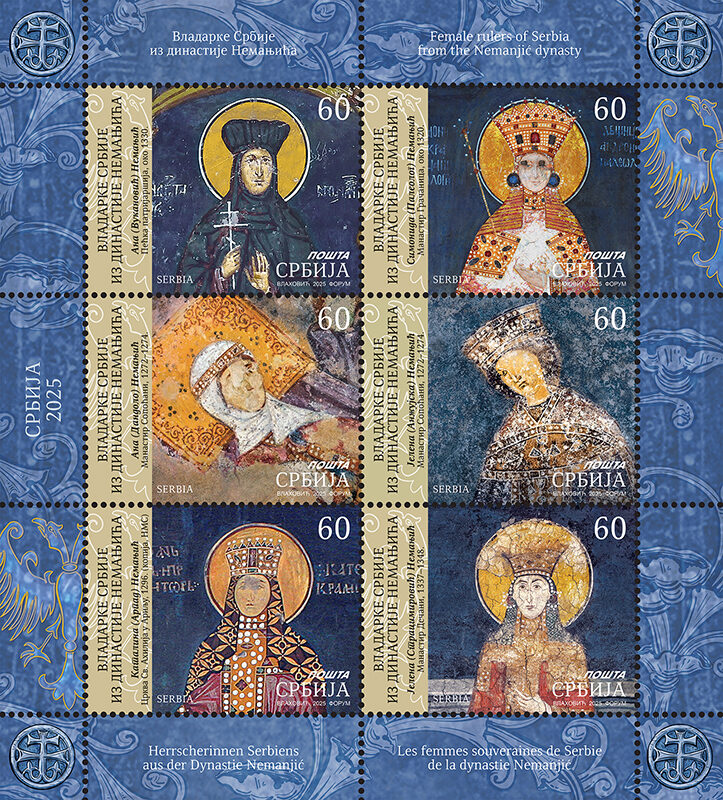
Ana (Vukanović) Nemanjić (1125 – 1200) was a Serbian Grand Princess, the wife of Stefan Nemanja, the founder of the Serbian ruling dynasty of Nemanjić, and the mother of Stefan the First-Crowned, Vukan, and Saint Sava. There is conflicting information about her origins, but what history remembers is that Ana Nemanjić, together with her husband Stefan Nemanja, was the patron of numerous monasteries. Stefan Nemanja and Ana Nemanjić took monastic vows on the Annunciation in 1196, receiving the names Simeon and Anastasija. The monk Simeon retired to Studenica, and Anastasija to their endowment, the Monastery of the Holy Mother of God in Toplica, where she died in 1200. Her holy remains were later transferred to Studenica, the endowment and burial church of her husband, where they still rest today.
Stamp motif – detail of a fresco from the Peć Patriarchate.
Simonida Nemanjić (1294 – after 1345) was the only daughter of the Byzantine Emperor Andronikos II Palaiologos and Empress Irene. The Serbian King Stefan Uroš II Milutin Nemanjić marked the beginning of his reign by conquering Skopje in 1282, and then the entire Vardar Macedonia. Emperor Andronikos II, after an attempt to regain lost territories and long peace negotiations, in 1299 offered the Serbian King Milutin the hand of his minor daughter as a guarantee of peace and friendship between Byzantium and Serbia. Her unusual fate was an inspiration to many artists, and her beauty was celebrated in songs and depicted in many frescoes and paintings. A fresco with her image in the Gračanica Monastery, in the Church of Holy Mother of God (Annunciation), painted around 1320, is considered one of the most valuable frescoes of Serbian medieval painting. After Milutin’s death in 1321, Queen Simonida took monastic vows. She died after 1345.
Stamp motif – detail of a fresco from the Gračanica Monastery.
Anna (Dandolo) Nemanjić (year of birth unknown – around 1265) was a Serbian queen, wife of King Stefan the First-Crowned and mother of the future King Stefan Uroš I. The daughter of Raniero Dandolo, Vice-Doge of Venice and Procurator of San Marco, she married Stefan Nemanjić in 1217, when they were crowned together, in the Church of St. Apostles Peter and Paul in Ras. The famous fresco “The Death of Queen Anna Dandolo”, which is painted on the north wall of the narthex of the Church of the Holy Trinity in Sopoćani, is dedicated to Queen Anna. The fresco depicts Queen Anna on a deathbed at the moment when an angel receives her soul, and Christ and the Mother of God appear at her headboard. The Serbian court is gathered around her deathbed. Her son and King Uroš I is depicted in royal robes with a crown on his head, with Princes Dragutin and Milutin standing behind him, and Princess Brnča behind them, while the Queen’s left hand is held and kissed by her daughter-in-law Queen Jelena. Archbishop Sava II is also depicted in the fresco.
Stamp motif – detail of a fresco from the Sopoćani Monastery.
Jelena Nemanjić (c. 1236 – 1314), also known in history as Helen of Anjou, was a Serbian queen, the wife of Serbian King Stefan Uroš I and the mother of Kings Dragutin and Milutin. She was a descendant of royal and noble families originating from the Byzantine and Hungarian regions, and was active and influential in all spheres of government, politics and diplomacy, but no less in construction and spiritual spheres. Along with Empress Jelena, wife of Dušan the Mighty, Helen of Anjou is the most frequently depicted woman in Serbian medieval painting. She took monastic vows in the Church of Saint Nicholas in Skadar. She died at the court in Brnjaci in 1314, and according to her own wishes she was buried in her endowment, the Gradac Monastery. She was canonized three years after her death.
Stamp motif – detail of a fresco from the Sopoćani Monastery.
Кatalina/Katarina (Arpad) Nemanjić (mid-13th century – after 1316) Hungarian princess from the Arpad dynasty, was the wife of King Stefan Dragutin Nemanjić, whom she married in 1268. The marriage was concluded as part of a peace treaty between Hungary and Serbia. Katalina became the Serbian queen, and Belgrade was part of the territory that King Dragutin received “as a dowry”. Helena of Anjou, Dragutin’s mother, was her mother-in-law and role model. She had numerous offspring, sons Vladislav and Urošic who are depicted as princes in artistic representations of the Nemanjić dynasty. She also had daughters Jelisaveta, Margarita and Ursa (Ursula). Jelisaveta’s descendant was Tvrtko, the first ruler of Bosnia and part of Serbia, who bore the title of King of Serbia and Bosnia. Katalina is the patron of the Tronoša Monastery near Loznica, from 1317.
Stamp motif – detail of a fresco from the Church of Saint Achilles in Arilje (copy from National museum of Serbia, copyist Rajko Nikolić).
Jelena (Stracimirović) Nemanjić (c. 1310 – 1376) was a Bulgarian noble woman and Serbian queen, and later empress, wife of Stefan Dušan and mother of Emperor Uroš V. The daughter of Despot Stracimir, she married Dušan on Easter, 1332. This marriage confirmed the alliance between Dušan and Jelena’s brother Jovan Aleksandar, who, in 1331, at the same time when the later Emperor Dušan overthrew his father Stefan of Dečani, overthrew Tsar Michael III Shishman, from the Bulgarian throne and proclaimed himself Emperor of Bulgaria. In her marriage to Dušan, she gave birth to a son, Uroš, who succeeded his father on the throne. Empress Jelena was of exceptional abilities, a skilled diplomat, a lover of good books, an intellectual, a pious and philanthropic woman. After the death of Emperor Dušan, Jelena took monastic vows, received the monastic name of Jelisaveta, and with her son Uroš she completed the construction of the Matejča Monastery near Kumanovo. She died in 1376 and, according to her own wishes, was buried next to Emperor Dušan.
Stamp motif – detail of a fresco from the Dečani Monastery.
Professional cooperation on the issue: Museum of the Serbian Orthodox Church except stamp and text for Кatalina/Katarina (Arpad) Nemanjić – National Museum of Serbia, Phd Bojan Popović, Museum Advisor
Artistic realization: Marija and Jakša Vlahović, MA academic graphic artists
Technical details
Date of issue: 08. 12. 2025.
Number of stamps in set: 6
Denomination:
1420: 60.00 RSD
1421: 60.00 RSD
1422: 60.00 RSD
1423: 60.00 RSD
1424: 60.00 RSD
1425: 60.00 RSD
Printrun: 15.000
FDC: 3
Sheet of: 6
Dimensions of stamp: 42 x 31,9 mm
Artistic realization: Marija Vlahović, Jakša Vlahović
Subject: Female Rulers of Serbia from the Nemanjić Dynasty
1420: Ana (Vukanović) Nemanjić
1421: Simonida Nemanjić
1422: Anna (Dandolo) Nemanjić
1423: Jelena Nemanjić
1424: Кatalina/Katarina (Arpad) Nemanjić
1425: Jelena (Stracimirović) Nemanjić
Perforations: 13 3/4
Printer: Forum Novi Sad
Christmas
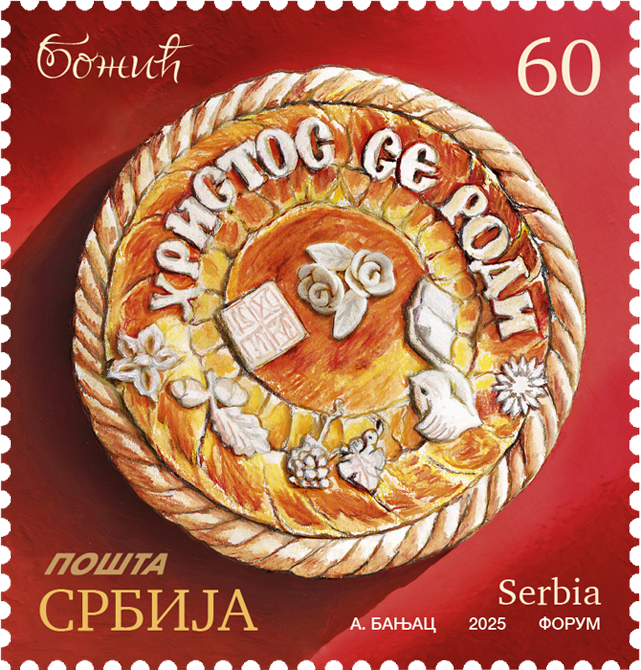
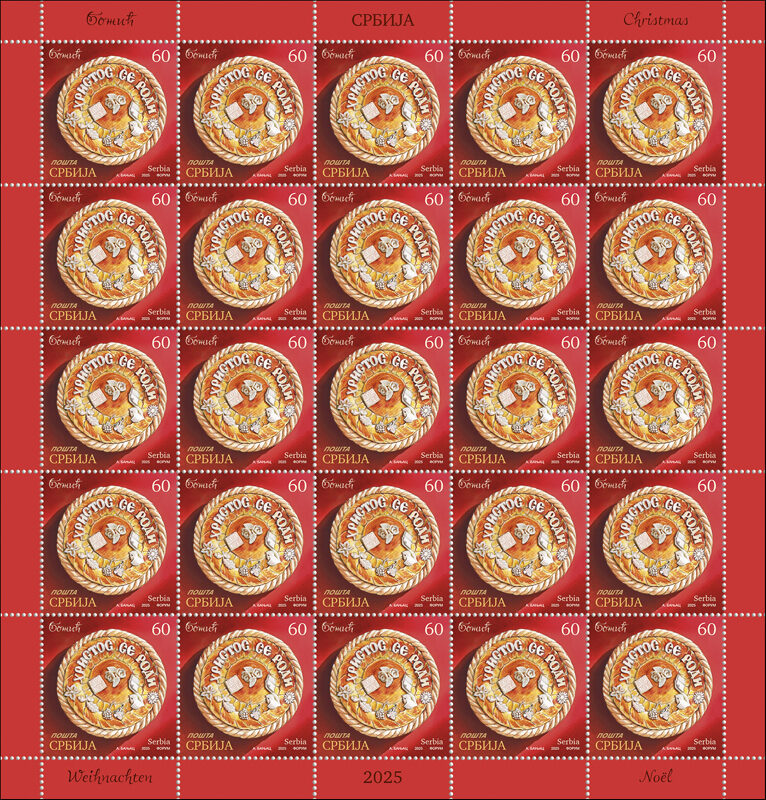
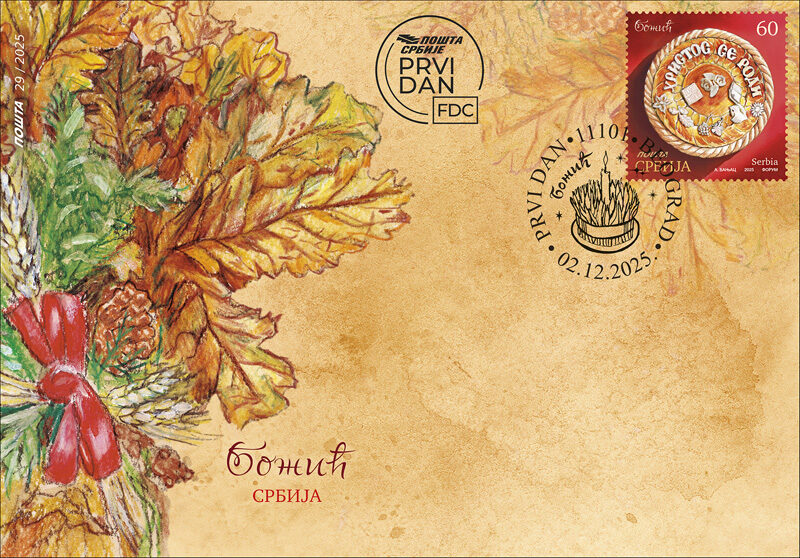
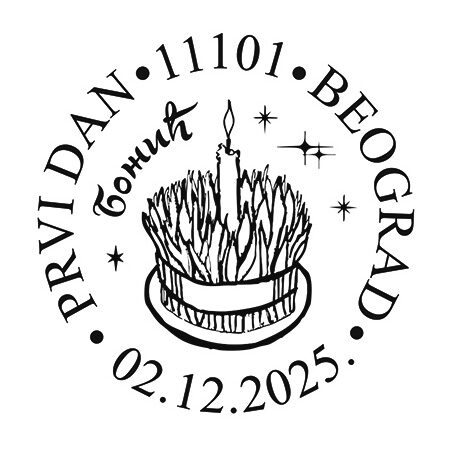
Christmas is one of the most important and one of the most joyous Christian holidays, that is celebrated both by the Orthodox and Catholic believers. The difference is only in the date of the celebration; the Orthodox celebrate it on January 7th, and the Catholic on December 25th, but its message remains the same – the message of peace and love.
We celebrate Christmas for three days. It is primarily family holiday, and there are numerous traditions and customs regarding Christmas. On the day before Christmas and Christmas Eve, the yule log is being brought into house, cresset lit and hay with hidden candies, prunes, walnuts, sugar and coins, spread all over the house. The hay is a symbol of the manger in which Christ was born. The yule log represents longevity and substance of Christianity, as well as of the warmth of the love Christ brought to us when he was born and arrived to the Earth.
An important element of the Christmas tradition is the “Česnica” (Serbian Christmas bread), a ceremonial bread usually made from wheat flour, symbolizing blessings and abundance. According to traditional customs, a coin is placed in the Česnica before baking, and the bread is then broken during the central Christmas meal. It is believed that the family member who finds the coin from the Česnica bread will be followed by good luck and money throughout the year to come.
On the very day of the Christmas, early in the morning the church bells of all Orthodox temples are ringing, announcing the nativity of Christ. People go to church to attend Christmas liturgy and they all greet each other by “Christ has been born” and “Indeed he has”.
Artistic realization of the issue: MA Anamari Banjac, academic painter
Technical details
Date of issue: 02. 12. 2025.
Number of stamps in set: 1
Denomination:
1419: 60.00 RSD
Printrun: 25.000
FDC: 1
Sheet of: 25
Dimensions of stamp: 33,5 x 35 mm
Artistic realization: Anamari Banjac
Subject: Christmas
1419: Česnica (Serbian Christmas bread)
Printer: Forum Novi Sad
ART
100th anniversary of the birth of Zuzana Chalupová
100 years since the birth of Janika Balázs
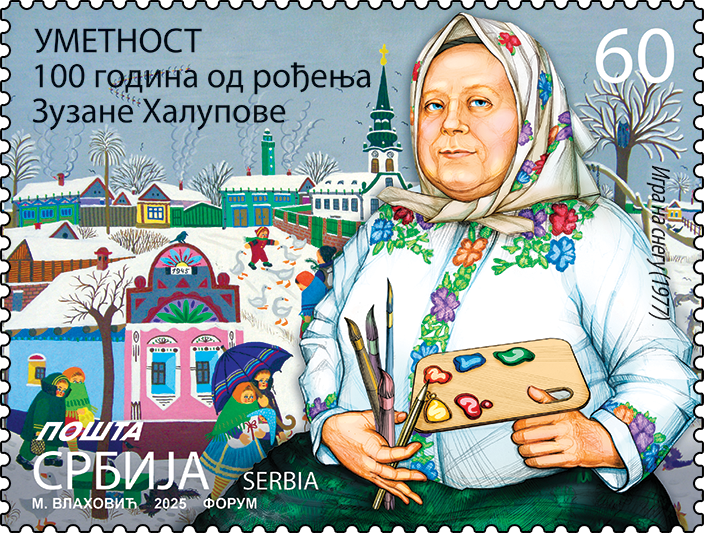
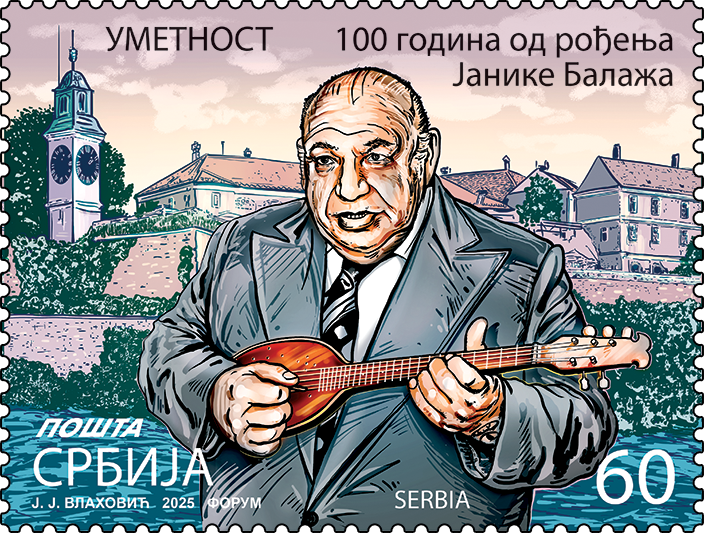
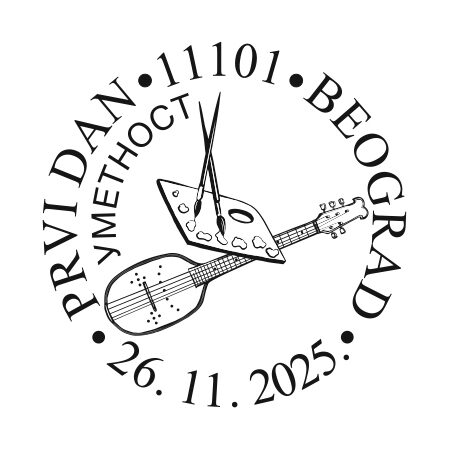
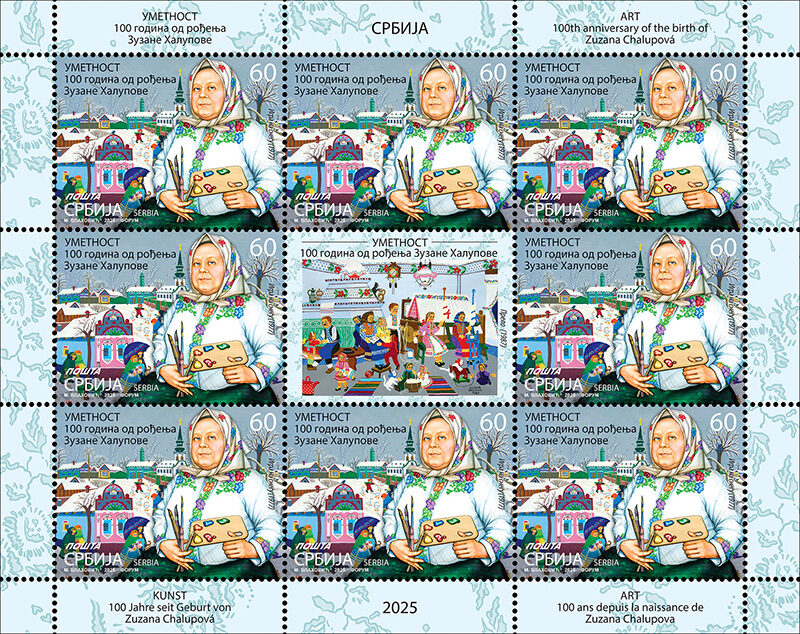

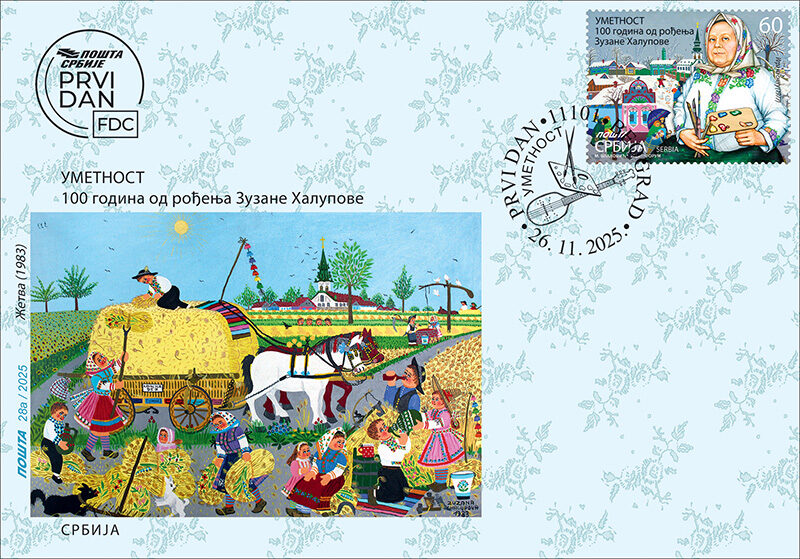
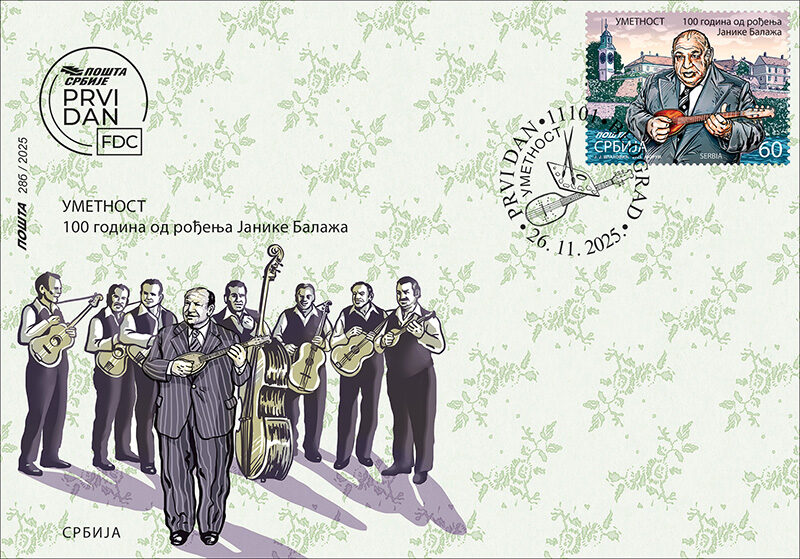
100th anniversary of the birth of Zuzana Chalupová
Zuzana Chalupová (Kovačica, February 5, 1925 – Belgrade, August 1, 2001) dedicated her entire life to art. She lived and created in her hometown, and found inspiration for her works in her surroundings and everyday life. She only completed five grades of elementary school, but her passion for painting and her inspiration transcended the boundaries of education, making her one of the most significant protagonists of the Kovačica naive art. The leitmotif of Zuzana Chalupová’s work is the children, who made her famous and after whom she was named “Mama Zuzana”. Her compositions, oil paintings and drawings, with genre motifs, biblical themes and themes from everyday life, abound in warm and emotional depictions. Well-known are her paintings of winter, which fascinate with their captivating colours and perfect compositions. Her works today adorn many galleries and museums around the world. She has exhibited, individually and in groups, at numerous exhibitions throughout the country and the world, including in Paris, New York, Rome, Vienna, Bonn, Zurich, Copenhagen, Geneva.
Although she began painting relatively late, she was an extremely prolific artist. Zuzana was a member of the Gallery of Naive Art since 1964. Her works brought fame to this institution, representing her in all meridians. The collection of the Gallery of Naive Art contains 31 of her paintings, which testify to the artistic power and emotional depth of Zuzana Chalupová’s authorial work. Zuzana Chalupová, an artist who wrote stories through colour, touched the hearts of many with her work and left a strong mark on the world of fine art. She died in 2001, leaving behind a rich legacy that will live on forever through her paintings.
Professional cooperation: Kovačica Gallery of Naive Art
Artistic realization: Marija Vlahović, Academic Graphic Artist
100 years since the birth of Janika Balázs
In Lukino Selo near Zrenjanin, the most eminent prim-tambura artist from these areas, the world famous Janika – Jovan Janika Balázs (December 23, 1925 – November 10, 1988), was born 100 years ago. He spent most of his life and work in Novi Sad and Petrovaradin. He inherited a love of music from his ancestors. Janika chose the prim-tambura (bisernica), which he raised to the pedestal of art with his spirit, mastery and style.
He started playing at the age of six, and had his first klapa at the age of ten. He performed in the Tambura Orchestra of Radio Titograd, and joined Radio Novi Sad in 1951. In the Great Tambura Orchestra of RTV NS, he achieved complete recognition and became concertmaster.
He would gain worldwide fame with the “Small Tambura Orchestra” (Mali tamburaški sastav) and his role in the film “I Even Met Happy Gipsies” (Skupljači perja), which led to a concert at the famous Olympia in Paris, as well as other performances throughout Europe and the world. In addition to playing, he also wrote arrangements, lyrics, and music. Ratko Šoć dedicated the song “Eight Tambura Players” (Osam tamburaša) to him, after which the orchestra would be named.
Professional cooperation: Museum of the City of Novi Sad, Dušanka Marković, curator – museum advisor
Artistic realization: MA Jakša Vlahović, academic graphic artist
Technical details
Date of issue: 26. 11. 2025.
Number of stamps in set: 2
Denomination:
1417: 60.00 RSD
1418: 60.00 RSD
Printrun: 15.000
FDC: 2
Sheet of: 8
Dimensions of stamp: 42 x 31,9 mm
Artistic realization: Marija Vlahović, Jakša Vlahović
Subject: Art
1417: Janika Balázs, Petrovaradin fortress
1418: Zuzana Chalupová, painting “Play on snow” (1977)
Perforations: 13 3/4
Printer: Forum Novi Sad
PATRON SAINT’S DAY
Day of St. Michael the Archangel
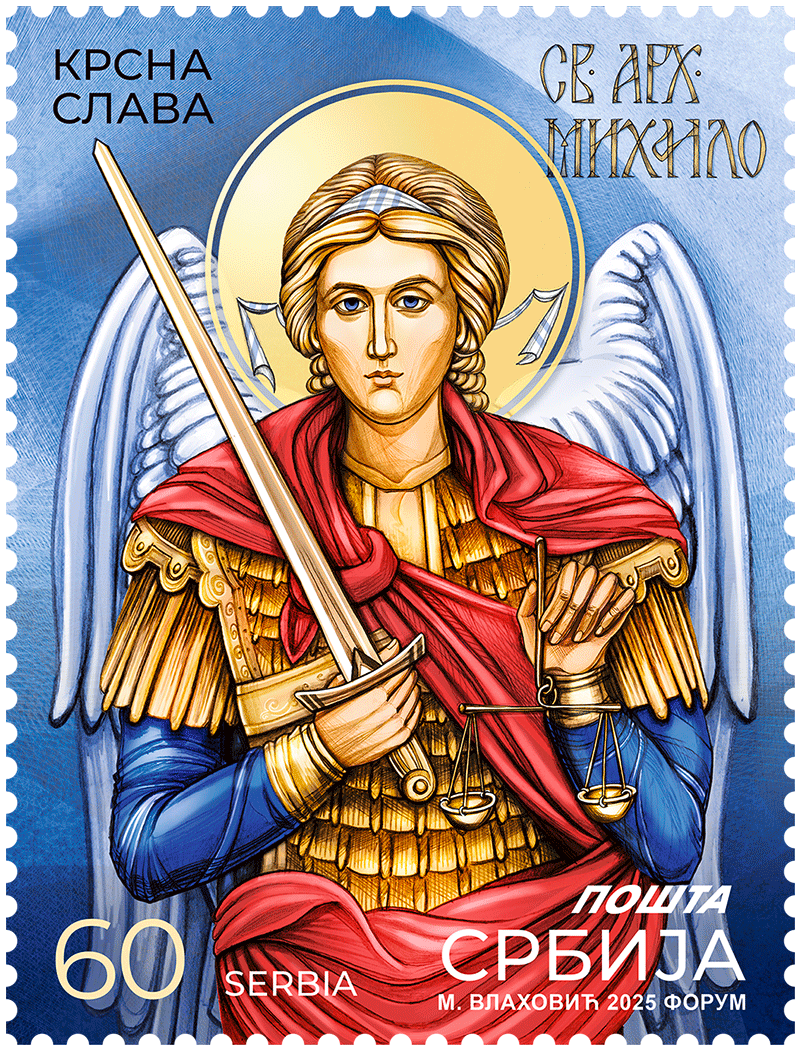
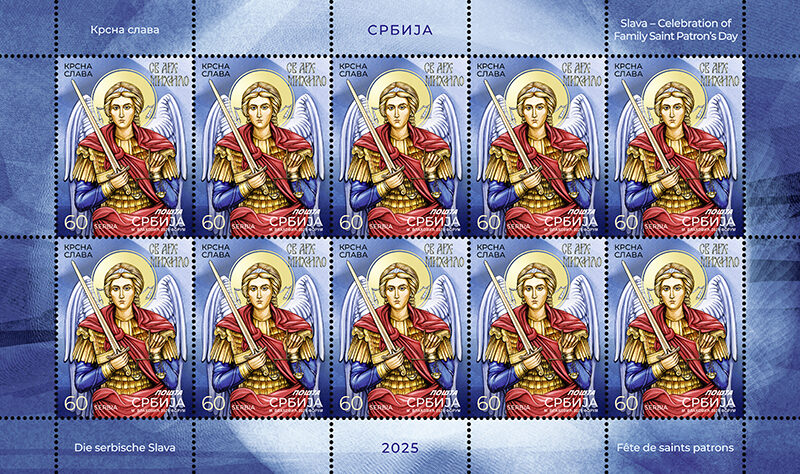
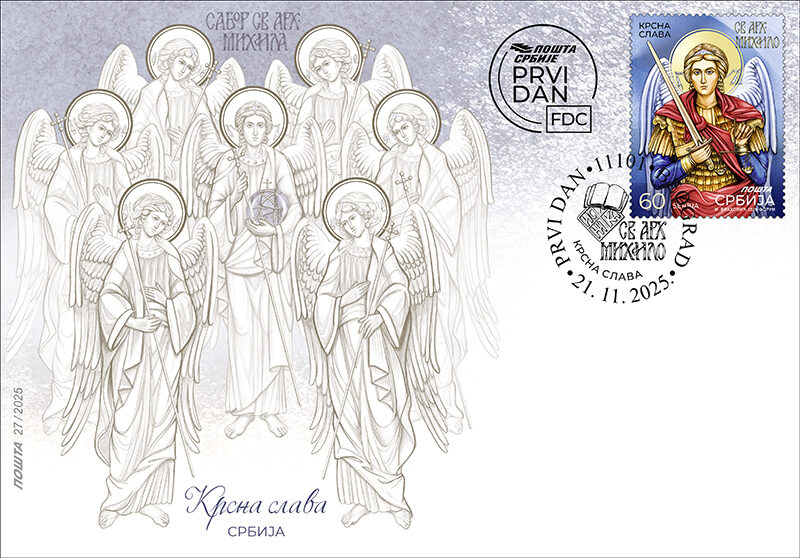
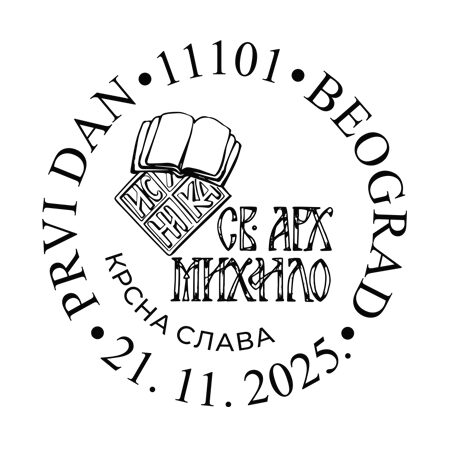
Patron Saint’s Day (Slava) is a traditional and religious custom, the most important family holiday among Serbian people after Christmas and Easter. Traditionally, this holiday is always associated with the day of a specific Christian saint whom the family celebrates as its patron. The celebration of the Patron Saint’s Day among Serbs dates back to the time of Saint Sava and is a unique custom of the Serbian people, deeply rooted in tradition and faith. Patron Saint’s Day is also a symbol of family unity and spiritual connection with ancestors that is maintained and passed down from generation to generation.
Since 2014, Slava has been on the UNESCO Representative List of the Intangible Cultural Heritage of Humanity.
Archangel Michael’s Day, the holiday of the Prince of Heaven, Saint Michael the Archangel, leader of the Powers of Heaven and protector of justice and faith, is one of the greatest Orthodox holidays and one of the most commonly celebrated Slavas in Serbia.
In Christian tradition, Archistrategos (Chief Commander) Michael is the first among the seven archangels, who gathered a heavenly army – an army of angels, to oppose the forces of evil of the fallen angel Lucifer (Satan). Therefore, in iconography, he is depicted with a sword or spear, in Roman armour, defeating a dragon.
This holiday was included in the calendar of the Church of Christ in the 4th century, and the Serbian Orthodox Church celebrates it every year on November 21, according to the new calendar. It is believed among the people that the autumn and winter seasons belong to Saint Michael the Archangel.
Artistic realization: Marija Vlahović, Academic Graphic Artist
Technical details
Date of issue: 21. 11. 2025.
Number of stamps in set: 1
Denomination:
1414: 60.00 RSD
Printrun: 25.000
FDC: 1
Sheet of: 10
Dimensions of stamp: 31,9 x 42 mm
Artistic realization: Marija Vlahović
Subject: Patron saint’s day
1414: St. Michael the Archangel
Perforations: 13 3/4
Printer: Forum Novi Sad
Institutions of Serbia
75 years of the Institute for Mother and Child Health Care of Serbia “Dr. Vukan Čupić”
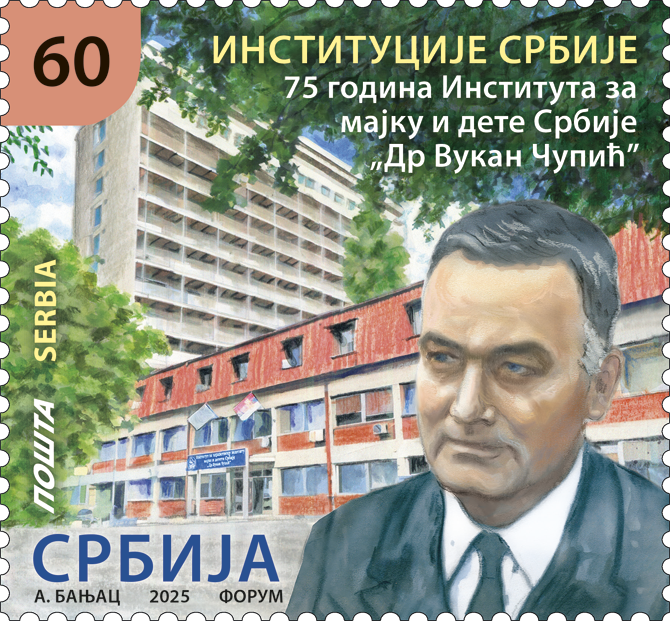
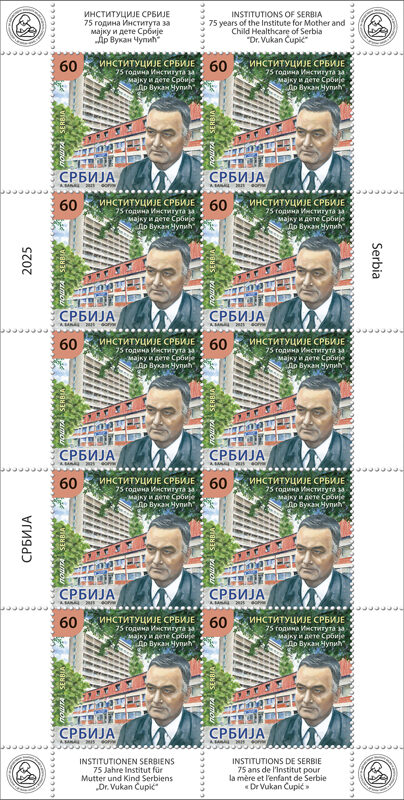
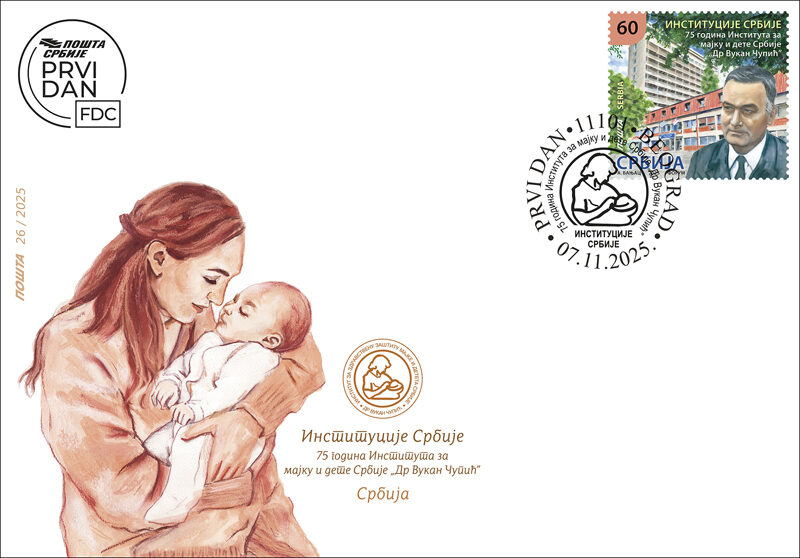

By a decree of the Government of the People’s Republic of Serbia of 25 April 1950, Institute for Mother and Child Health Care was established, originally under the name Institute for Health Care of the National Youth, with the aim of organizing and developing a national network of health institutions intended for women of reproductive age, preschool and school children. The first director was Dr. Vlastimir Ivković, then Dr. Miloš Bajšanski, and from 1953 until his retirement, the director’s duties were performed by Dr. Vukan Čupić (1920–1981).
Vukan Čupić began his medical studies in Marseille, France, in 1938 and graduated in Lausanne in 1944, where, as an outstanding student, he immediately became an assistant at the Pediatric Clinic. Right after the war, in 1945, he returned to our country and began working at a children’s clinic. He was an expert with exceptional, broad education, with a clear vision in the field of maternal and child health care, and under his leadership the Institute quickly became a reference institution in the field of youth health care, not only in the then Yugoslavia, but also beyond. A world-renowned expert in the field of maternal and child health care, a participant in numerous UNICEF missions, Dr. Vukan Čupić was also a full professor at the Faculty of Medicine in Belgrade and a member of the Medical Academy of Sciences.
Today, the Institute for Mother and Child Health Care of Serbia, named after Dr. Vukan Čupić, is a highly specialized institution that provides comprehensive health care to children, youth and women of reproductive age, using the most modern scientific, technological and biomedical achievements, integrating health, educational, scientific research and professional and methodological activities with the aim of improving the quality of health care. The Institute for Mother and Child Health Care is an institution that, in addition to direct health care for children, promotes health, humanity and provides support to children and their families.
Professional cooperation on the issue: Dr. Vladislav Vukomanović, Director of the Institute for Mother and Child Health Care “Dr. Vukan Čupić”
Artistic realization of the issue: MA Anamari Banjac, academic painter
Technical details
Date of issue: 07. 11. 2025.
Number of stamps in set: 5
Denomination:
1413: 60.00 RSD
Printrun: 25.000
FDC: 1
Sheet of: 10
Dimensions of stamp: 37,7 x 35 mm
Artistic realization: Anamari Banjac
Subject: Institutions of Serbia
1413: Building of the Institute for Mother and Child Health Care of Serbia and portrait of Dr. Vukan Čupić
Printer: Forum Novi Sad
FRIENDS OF SERBIA
Greece, Slovakia, Cyprus, Spain, Romania
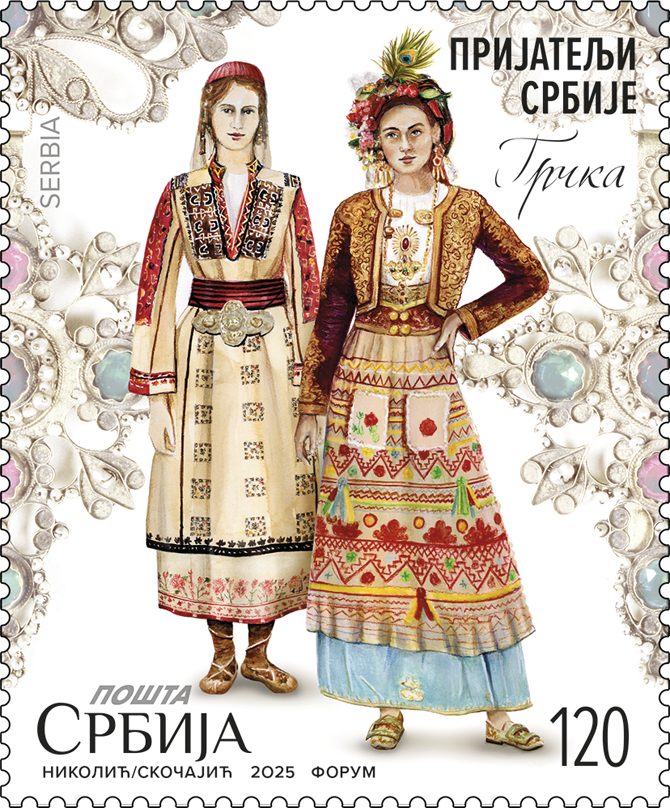
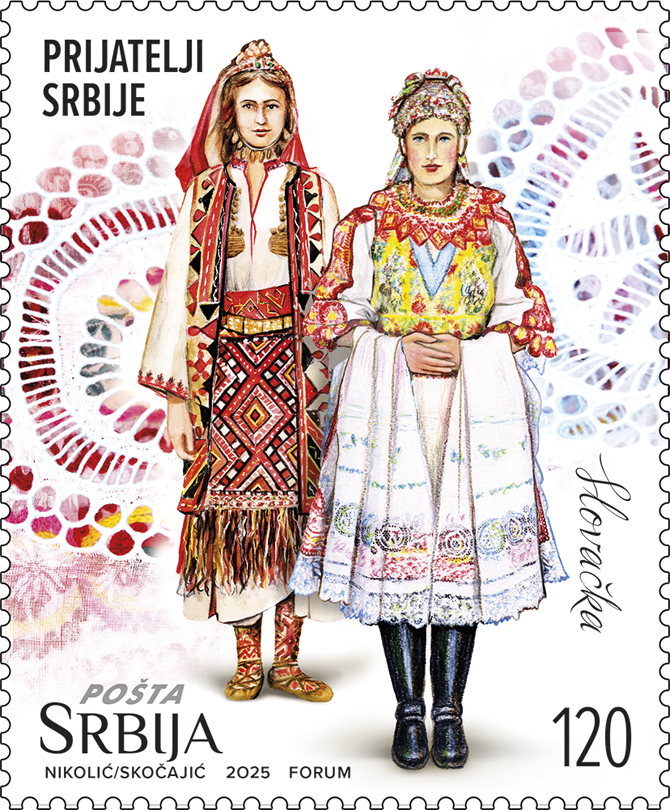
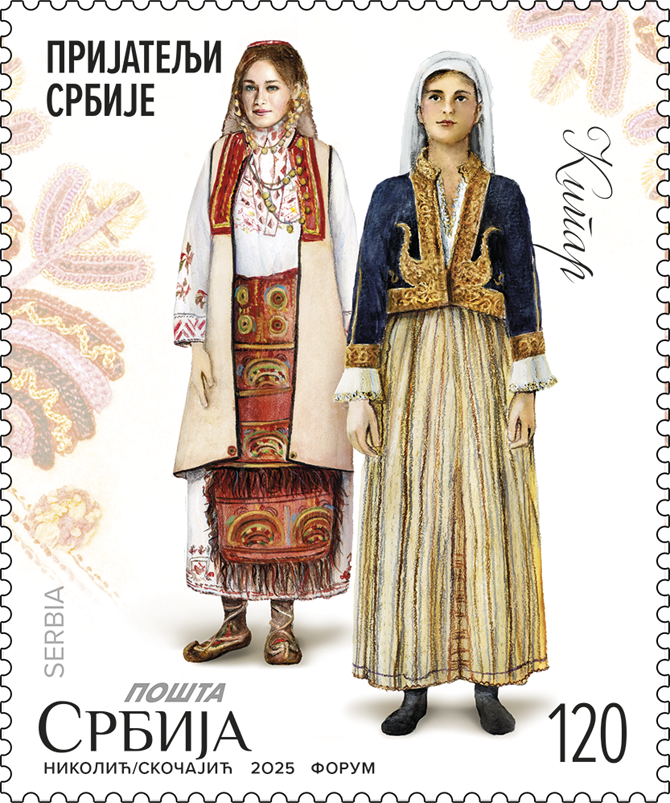



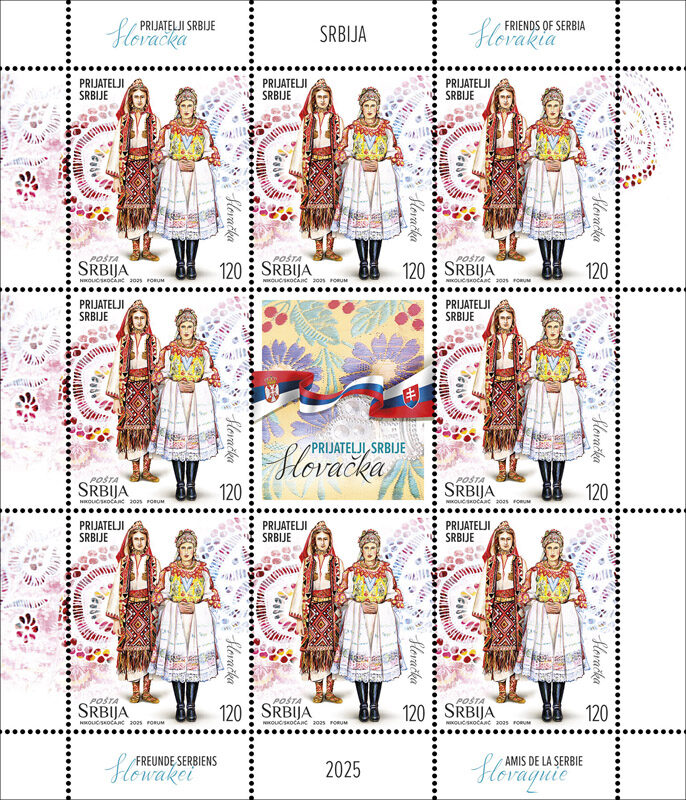

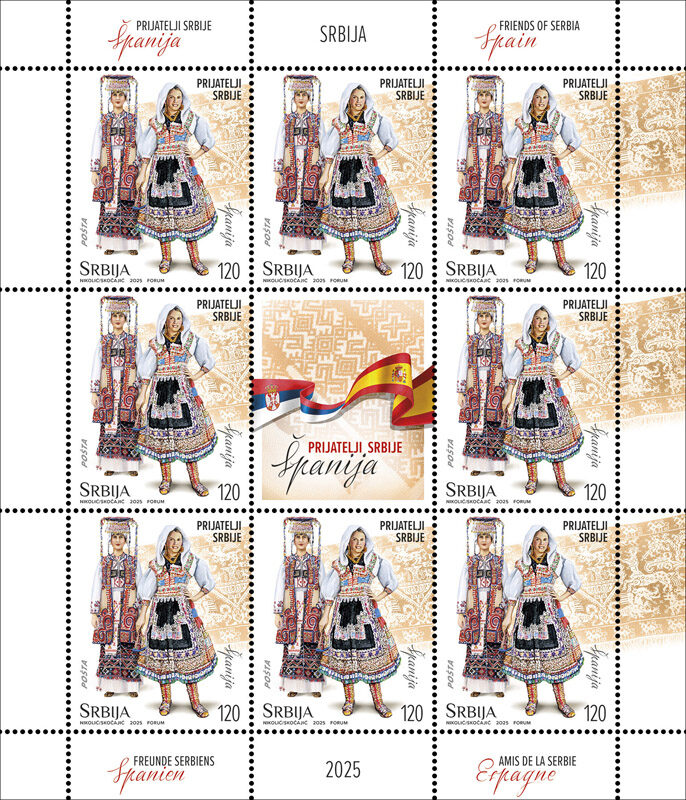
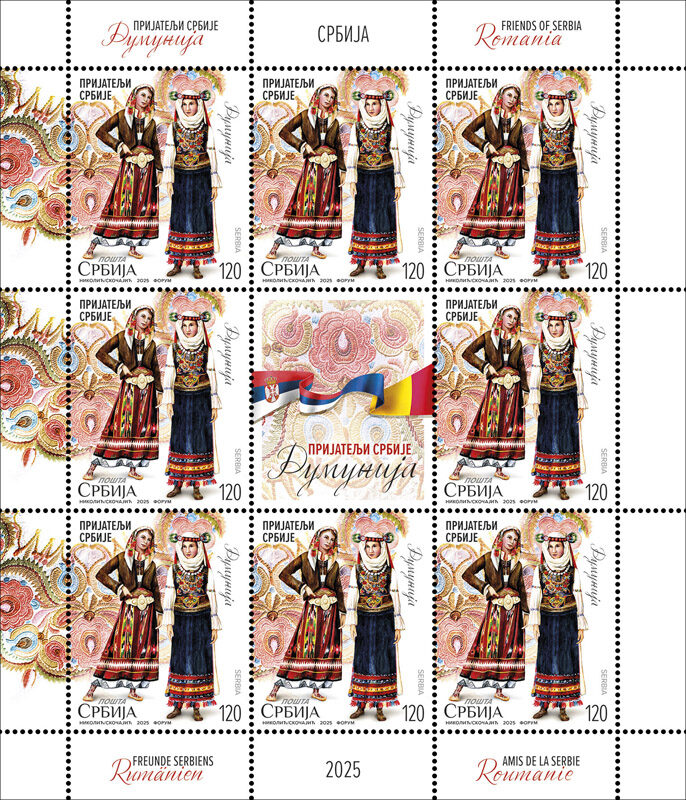
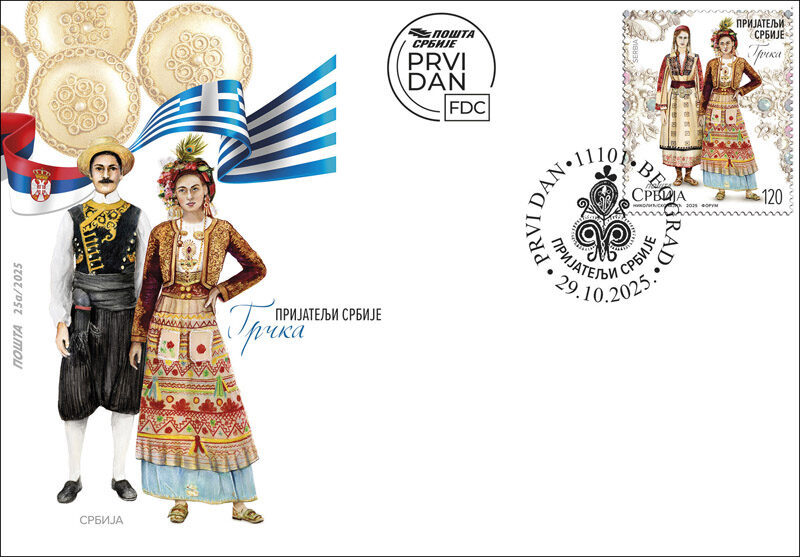
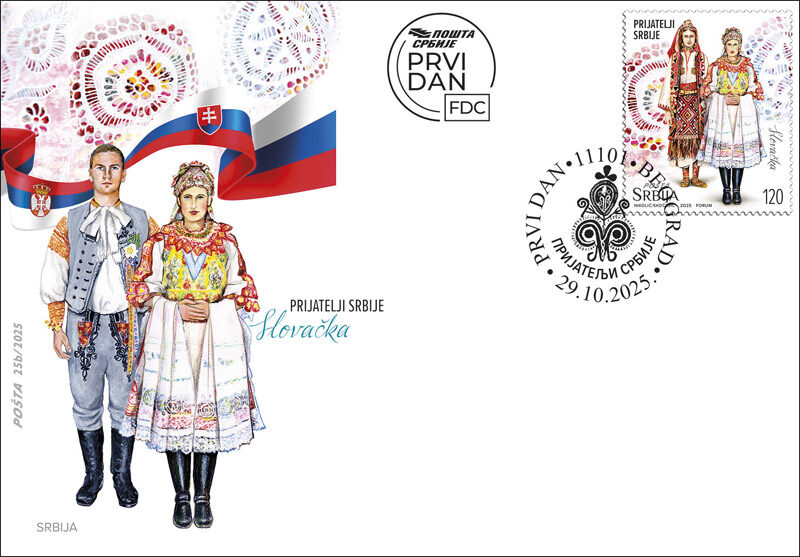
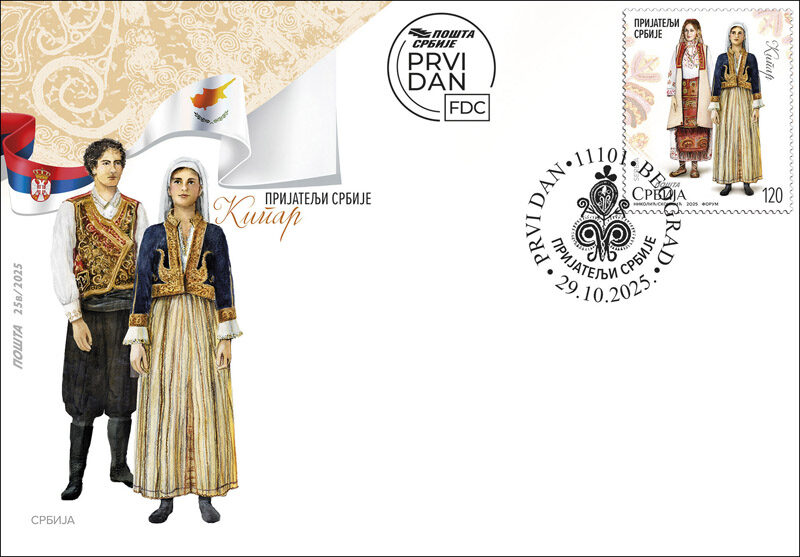
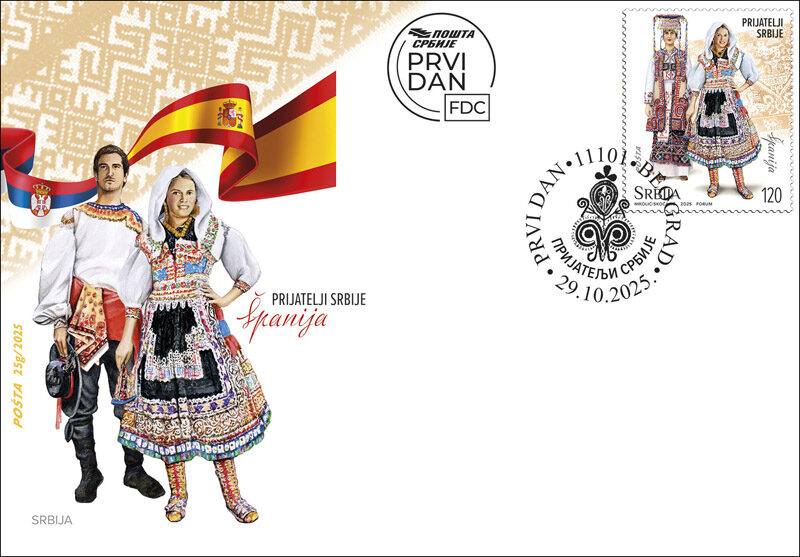

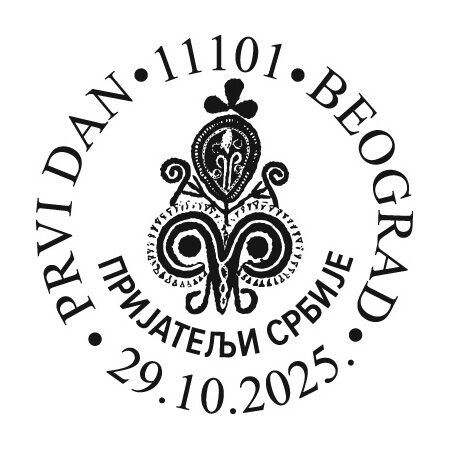
FRIENDS OF SERBIA
With this commemorative stamp issue, we show our respect and gratitude to the countries of Europe with which Serbia fosters deep friendly relations based on mutual trust and support. The motifs on the stamps depict an example of the rich cultural and historical heritage of our own and our friendly nations, depicted in folk attire that testify to the preservation of tradition and underline the closeness that connects and unites us with our friends.
Friends of Serbia – GREECE
Women’s costume from Corfu, Ionian Islands, early 20th century
The bridal and festive costume of Corfu includes as undergarments a white bodice and the “rokéto” a fine calico petticoat. The skirt, “velesi” or “ambito”, is made of blue taffeta with gold embroidery on the hem. The bosom is covered with the “boustína” (a white dickey), and the waist is tightened with the “chrysózoni” or “chrysokímero” (gold belt), over which a short sleeveless waistcoat, “zipouni”, is worn, which is fastened with “fioúmbes” (gold cufflinks). The outer sleeved jacket (the ”pesselí” or “krémezo”) is made of garnet-red velvet adorned with gold embroidery. The bridal apron is made of white tulle and is completely embroidered with multi-coloured wool, and decorated with small bows and rosettes made of coloured ribbons. The headdress (“yiádema” or “stólos”) is worn for the first time by a girl on her wedding day after which she continues to wear it throughout her life. The old hairstyle has been replaced by the “torkós”, which is formed from four long black coils of hair (“boumbária”) bound with red ribbons (“staftádes”). It is adorned with flowers, mirrors, thin metal spirals, feathers, peacock feathers and a starched “ bólia” (a type of veil). The earrings are “verges” and “kambánes”, and round the neck is a chain fastened to a filigree brooch on the bosom called the ílios (sun). She has three more gold brooches of different sizes and a gold cross with a crown.
Collection of the Basil Papantoniou Foundation, Nafplion.
Female folk attire, Vlasina, southeastern Serbia, 19th century
So-called “Shopi attire” are widespread in the regions of southeastern Serbia, and its content and appearance show significant individuality in the overall corpus of Serbian folk attires. Certain elements of the attire intended for the bride, such as a long, uncut, sleeveless dress, “manovil”, a shirt “alenica” and a cap “kaica”, of specific craftsmanship and predominantly red in colour, with their archaic, Old Slavic origin, still attract the attention of museum experts and ethnologists today.
Professional cooperation on the issue: Embassy of Greece in Belgrade; Basil Papantoniou Foundation, Nafplion Greece – Angeliki Roumelioti, Head of Collection Department.
Friends of Serbia – SLOVAKIA
Bridal attire from Krakovany, Trnava region, Slovak Republic, first half of the 20th century
Krakovany belongs to the Trnava region and is a typical representative of the traditional clothing of western Slovakia. What is characteristic of traditional folk attire from Krakovany is that it is very richly decorated with various types of embroidery, using yellow-orange, red, yellow and gold thread. The decoration of female clothing is dominated by bobbin lace (spools) with geometric patterns, which in 2022 was entered on the Representative List of Intangible Cultural Heritage of Slovakia.
The traditional folk attire shown on the issue is the property of Daniela Piscova.
Female attire, Raška
Serbian female attire from the Raška region was made mainly of wool and hemp cloth (rarely of cotton and linen) and dyed with natural vegetable dyes. It consisted of an embroidered hemp shirt and a woollen skirt, with a colourful woollen apron over which the woven belt was tied. Over everything, a “zubun” was worn – one of the oldest pieces of clothing in the southern Balkans, sleeveless, cut in front, length from mid-thigh to below the knee. It is made mostly of white rolled woollen cloth and lavishly decorated with colourful embroidery with wool cords and thread. Geometric and stylized plant ornamentation was most commonly used.
All pieces of clothing were made and decorated by hand, using local craftsmanship.
Professional cooperation on the issue: Embassy of the Slovak Republic in Belgrade, Slovak Intangible Heritage Centre of Slovak State Traditional Dance Company (SĽUK), state-funded organization established by the Ministry of Culture of the Slovak Republic.
Friends of Serbia – CYPRUS
Traditional attire from Cyprus
Cypriot folk attire is characterized by simplicity and relative uniformity, with regional variations in ornamentation, the combination of individual garments, and the use of colour. The four traditional types of attire – urban, mountain, Karpasia, and Paphos – were made of wool, linen, cotton, or silk, often hand-woven, and enriched with embroidery or printed patterns.
Female clothing usually consisted of an inner and outer headscarf, a cotton shirt with wide sleeves, over which a long “sagia” of woven cotton was worn; open in front, with slits on the sides and narrow black sleeves. Over the “sagia”, women wore a white cotton tunic (“tupletti”) or a short cloak with wide sleeves (“sarka”). Footwear consisted of leather knee-high boots (“podines”) with heels, or low flat shoes. The attire was completed by an embroidered belt on the hips and jewellery that decorated the chest, neck and arms.
Female attire, Niš area, Serbia, 19th century
Female attire from the Niš area was created in the mid-19th century, with still visible influences from the clothing styles of the upper social classes of medieval Serbia. With the numerous migration movements of the Serbian people towards the northern and western regions, this type of attire spread and adapted to different local traditions and ways of making clothing ensembles. The main elements are as follows: a long open dress, “zubun” or “ćurdija”, a large presence of gold thread in the decoration, such as on the apron “pregača” and a specific headdress “ručnik” over a specially curled hairstyle “trvelji”, which gives this attire unique artistic quality in the context of Serbian history and culture.
Professional cooperation on the issue: Embassy of the Republic of Cyprus in Belgrade; Charalampos Chotzakoglou, PhD, Cyprus Folk Art Museum of the Society of Cypriot Studies.
Friends of Serbia – SPAIN
Bridal attire, Lagartera, Province of Toledo, Castilla–La Mancha, 16th –17th century
In the heart of Castilla–La Mancha, one of the most impressive and complex items of clothing has been preserved – the bridal attire, which is associated with the story of centuries of embroidery, made with patience, dedication and high artistic and symbolic value. This attire comes from the 16th and 17th centuries, when Lagartera was already known for its textile industry. Over time, this incredibly rich embroidery became an element of collective identity, surviving to this day as a cultural symbol that can be seen at festivals, in museums, in the press and in photographic records.
Bridal attire with a plumed cap, Raška, southwestern Serbia, 19th century
The rich bridal clothing consisted of a long linen shirt, a waistcoat, a woollen sleeveless dress “zubun”, a woven woollen apron, and a belt. All pieces of clothing were made and decorated by hand, from local materials, using local craftsmanship. The most impressive element of the bride’s attire is the cap, which had a strong symbolic role because, according to belief, it protected the bride from evil forces and curses. It was richly decorated with beads, bells, buttons, mirrors, horse hair accessories. It was believed that the bride is most vulnerable on her wedding day, so by wearing a hat that made a sound when the bride moved, demons were chased away. This kind of headpiece was worn by the bride not only on her wedding day, but also later, until the birth of her first child.
Professional cooperation on the issue: Embassy of Spain in Belgrade.
Friends of Serbia – ROMANIA
Traditional folk attire from the Bistrița area, Romania
The folk attire from the Bistrița area clearly differs from the attire in neighbouring areas, both in terms of elements and in how it changed over time, with each community having a well-defined dress code, in accordance with social and marital status.
The bride from Bistrița wears colourful attire with various decorations, consisting of a shirt made of handmade textile, decorated above the elbow with embroidery of colourful glass beads, with pleats around the neck.
Male folk attire consists of a plain shirt, sewn from handmade cotton fabric, decorated around the collar, front and sleeves with embroidery made of multi-coloured beads with plant motifs.
Female folk attire with a woollen robe and silver buckles, Vranjska Pčinja, southern Serbia, late 19tth century
Specific forms of certain clothing elements such as the open-type skirt, the so-called “futa” and the extensive use of brown woollen cloth “klašnja”, as a reflection of the economic activity, predominantly livestock farming in these regions, are characteristic elements of the Serbian folk attire of the Central Balkan type. We find them in two different variants, depending on the length and openness in the front, from Kosovo and Metohija, Macedonia, Pomoravlje, through Resava and Svrljig all the way to the Timok regions in northeastern Serbia.
Professional cooperation on the issue: dr. Virgil Ștefan Nițulescu – manager of the National Museum of the Romanian Peasant; Embassy of the Republic of Romania in Belgrade, Vlad Nicoară.
Professional cooperation on the entire issue (motifs from Serbia): Ethnographic Museum, Belgrade, Tatjana Mikulić, PhD, Museum Advisor; Vjera Medić, Museum Advisor, Ivan Maksimović, Curator. Vuk Nenezić, Photographer.
Artistic realization of the issue: Miroslav Nikolić, MA Nadežda Skočajić, Academic Graphic Artist.
Technical details
Датум издања: 29. 10. 2025.
Број марака: 5
1408: 120.00 дин
1409: 120.00 дин
1410: 120.00 дин
1411: 120.00 дин
1412: 120.00 дин
Tираж: 15.000 x 5
Коверат првог дана (FDC) са жигом: 5
Табак: 8
Димензија марке: 34,8 x 42 mm
Штампа: вишебојни офсет
Зупчање: чешљасто 13 3/4
Штампарија: Форум Нови Сад
Artistic realization: Miroslav Nikolić, Nadežda Skočajić
Subject: 110 years of the Australian medical mission in Serbia
1408 – Женска народна ношња са Крфа, Јонска острва, почетак XX века, Женска ношња, Власина, југоисточна Србија, XIX век
1409 – Одећа младе из Кракована, Трнавски крај, Словачка Република, прва половина XX века, Женска ношња, Рашка
1410 – Традиционална ношња са Кипра, Женска ношња, околина Ниша, Србија, XIX век
1411 – Ношња младе, Лагартера, провинција Толедо, Кастиља–Ла Манћа, XVI–XVII век, Ношња младе са капом перјаницом, Рашка, југозападна Србија, XIX век
1412 – Традиционална ношња из подручја Бистрице, Румунија, Женска ношња са сукненим гуњићем и сребрним копчама пафтама, Врањска Пчиња, јужна Србија, крај XIX века
80 years of the United Nations
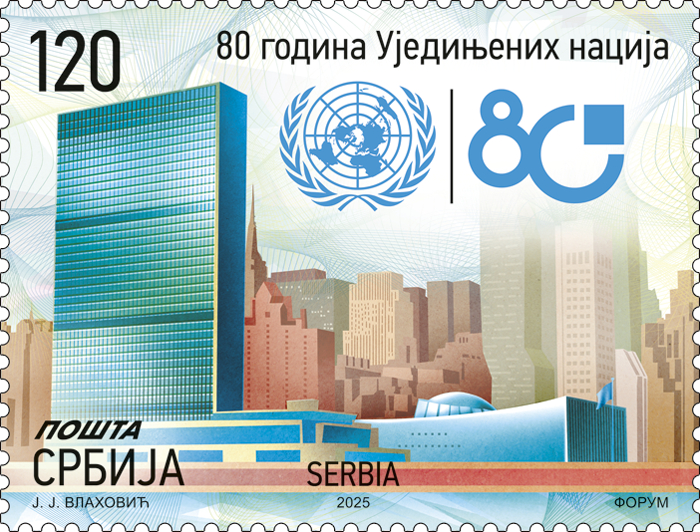
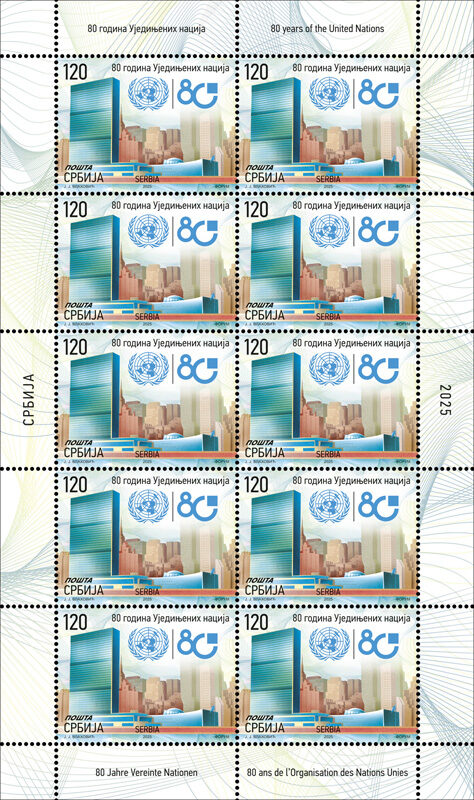
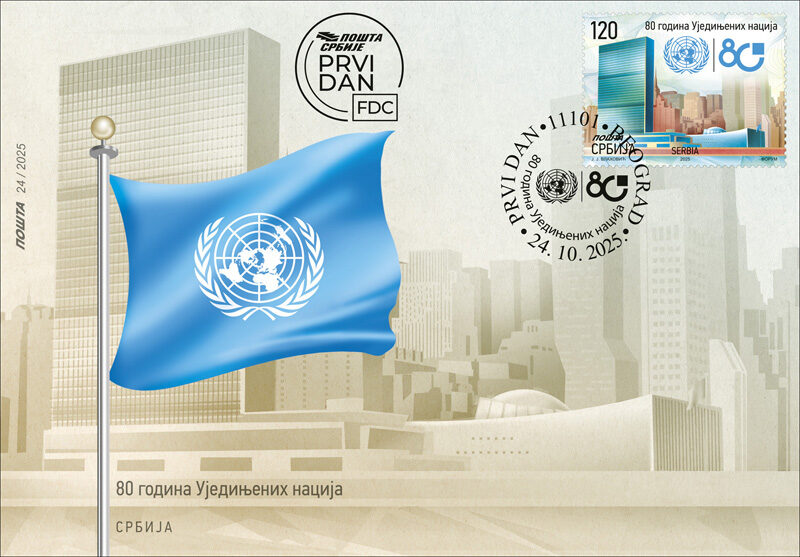
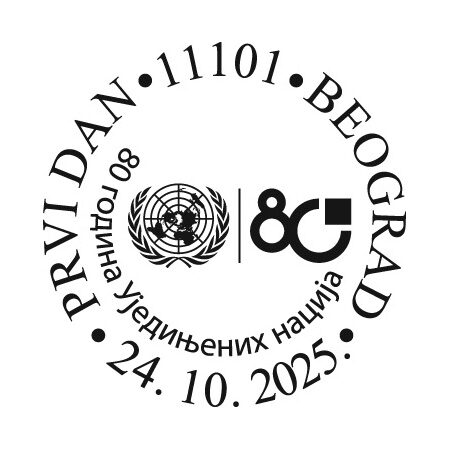
The United Nations celebrates its day on 24 October, as the date of entry into force of the UN Charter, signed after World War II in 1945, with the aim of preserving peace and security in the world, promoting human rights, and supporting economic and social development.
This year marks the 80th anniversary of the founding of the organization, which, despite challenges and limitations, has remained the key and irreplaceable platform for multilateral cooperation for eight decades.
Today, in a world facing growing geopolitical tensions and numerous global challenges – from conflict and instability, through climate change, to poverty alleviation and global health threats – the role of the United Nations as a unique forum for dialogue and cooperation has never been more important. It is therefore necessary to restore the full significance of this organization and to renew trust in multilateralism as the foundation of a just and stable international order.
The United Nations remains a symbol of the shared commitment of states to building peace, protecting human rights, and supporting sustainable development. By strengthening its role and consistently upholding the principles of the UN Charter, we can create a more stable, secure, and just world for future generations.
To mark the 80th anniversary of the organization, under the slogan “Building Our Future Together”, the United Nations has also created a jubilee logo. The Republic of Serbia, as a UN member state, joined the marking of this significant anniversary by issuing a commemorative postage stamp issue, with this jubilee logo as part of the postage stamp motif.
Professional cooperation on the issue: Ministry of Foreign Affairs of the Republic of Serbia
Artistic realization of the issue: MA Jakša Vlahović, academic graphic artist
Technical details
Date of issue: 24. 10. 2025.
Number of stamps in set: 1
Denomination:
1407: 120.00 RSD
Printrun: 15.000
FDC: 1
Sheet of: 10
Dimensions of stamp: 42 x 31,9 mm
Artistic realization: Jakša Vlahović
Subject: 80 years of the United Nations
1407: United nations general assembly building in New York and jubilee logo
Printer: Forum Novi Sad
Museum exhibits
75 years of the Museum of Applied Art
75 years of the Railway Museum
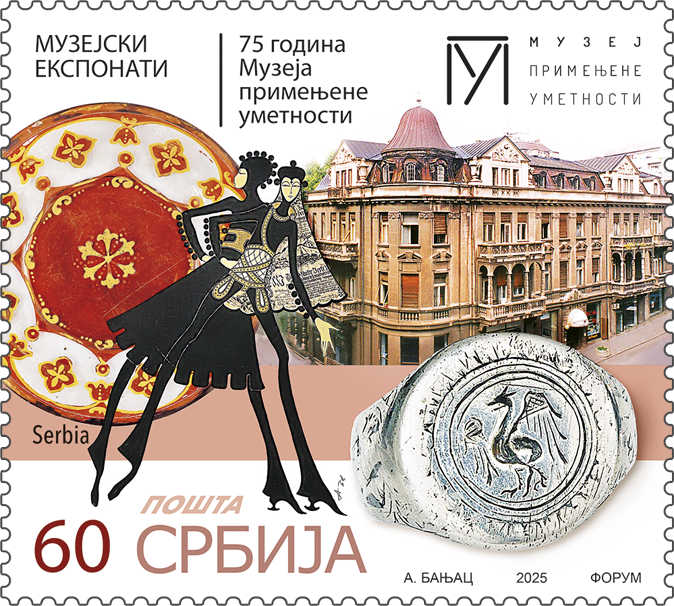
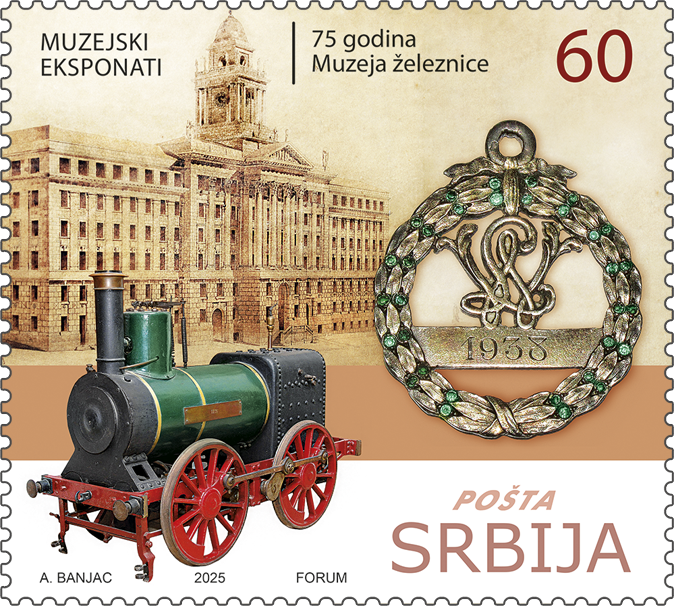
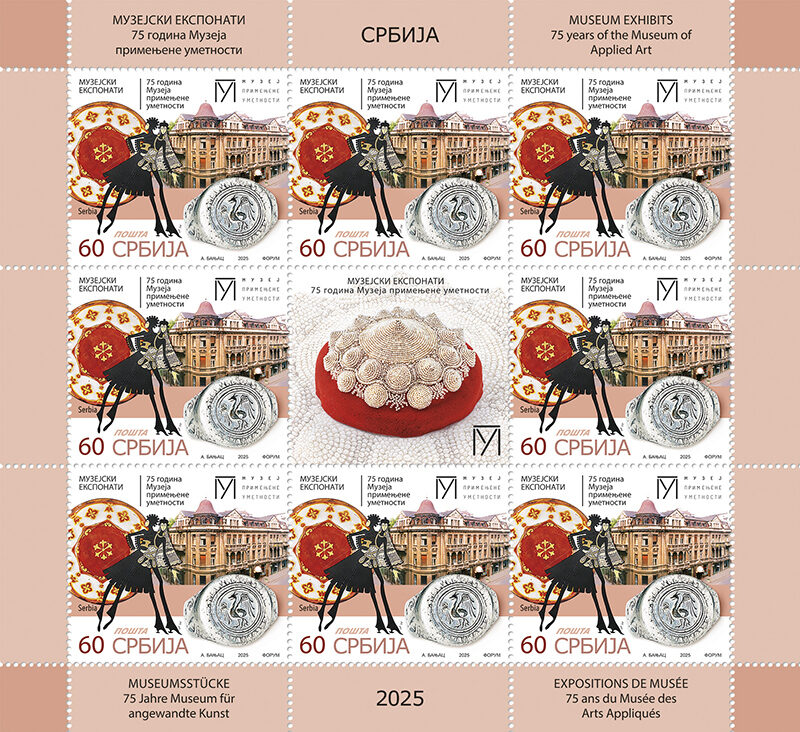

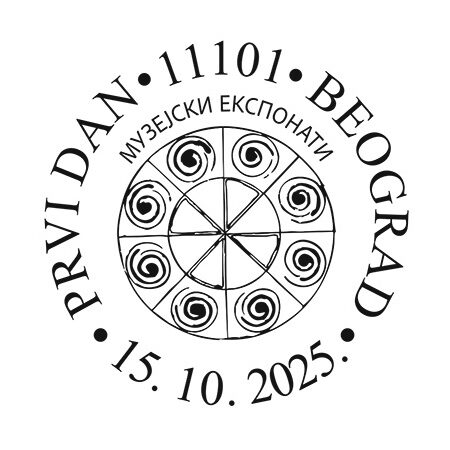
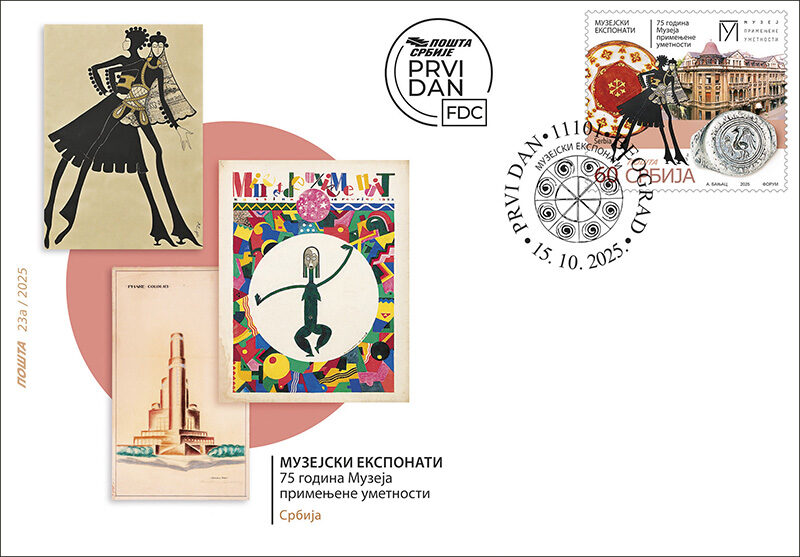
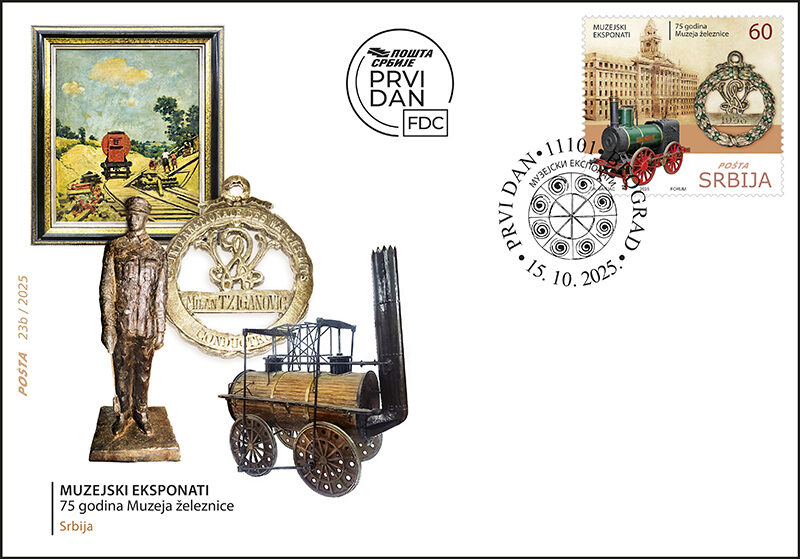
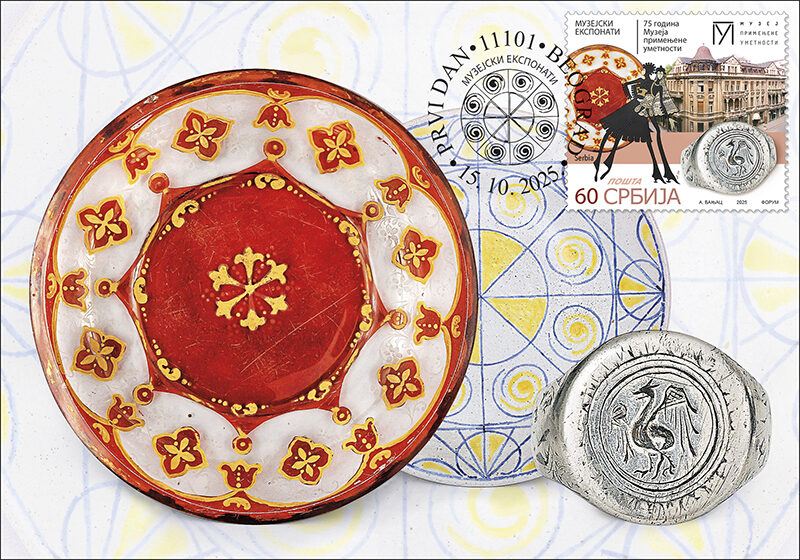
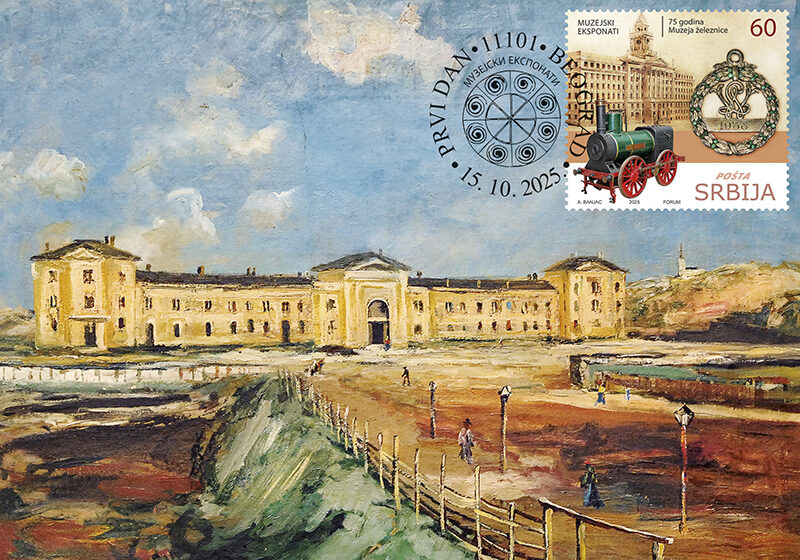
75 years of the Museum of Applied Art
The Museum of Applied Arts (MAA) in Belgrade was founded on November 6, 1950, as the main institution for applied arts in the territory of the Republic of Serbia. In its seven current art collections, the heritage of national and international applied art and design is preserved, tradition is nurtured, and an active attitude towards contemporary artistic practices is fostered. The museum is located in the Čelebonović Palace, at 18 Vuka Karadžića Street, which is one of the most representative examples of Belgrade architecture from the 1920s. The Museum owns around 45,000 objects of applied art, including works of exceptional artistic and cultural significance. The Museum’s collections include the following: Metal and Jewellery; Furniture; Ceramics; Glass and Porcelain; Textiles and Costumes; Architecture and Urbanism; Photography; Applied Graphics and Artistic Book Processing; Contemporary Applied Art and Design. Overall, the collections trace the development of applied art over a period of almost 2,500 years.
In addition to the basic museum activities of research, collection and preservation, the MAA organizes appearances of the Republic of Serbia at international events and festivals. The Museum’s activities also include documentation, wood and textile conservation, and a library. The Museum’s exhibition activities take place in as many as four active gallery spaces, including traditional events such as the Architecture Salon, the Contemporary Applied Arts Salon and the Children’s October Salon, studio exhibitions that open every year on the Day of the Museum of Applied Arts, as well as numerous program and visiting exhibitions. On the occasion of the anniversary in 2025, the Museum of Applied Arts will present a selection of the most representative objects from its collections as part of the new Permanent Exhibition.
Stamp motifs: Dessert tray, Principality of Serbia, around 1850 Crni Vrh, Glass Factory of Avram Petronijević, cast glass, red glaze, enamel, gold paint.
Aleksandar Joksimović, illustration for the collection Prokleta Jerina, Belgrade, 1968, paper, ink, printed fragment of a reproduction of baroque graphics.
Signet ring, silver, niello, second half of the 14th century.
Vignette motif: Head-ornament – tepeluk, Principality / Kingdom of Serbia, second half of the 19th century, wool, pearl; baize, embroidery.
Envelope motifs: Aleksandar Joksimović, illustration for the collection Prokleta Jerina, Belgrade, 1968, paper, ink, printed fragment of a reproduction of baroque graphics.
Dušan Janković, Draft for a poster for the One Thousand and Second Night ball, Belgrade, 1923, paper, tempera, ink.
Milan Zloković, Lighthouse Tower in San Domingo – Columbus Tower, combination of ink on paper with watercolour technique and wax paints.
Maximum Card motifs: Dessert tray, Principality of Serbia, around 1850 Crni Vrh, Glass Factory of Avram Petronijević, cast glass, red glaze, enamel, gold paint.
Ivan Tabaković, Plate, Belgrade, 1965, maiolica.
Signet ring, silver, niello, second half of the 14th century.
Expert cooperation on the issue: Museum of Applied Arts
Artistic realization of the issue: MA Anamari Banjac, Academic Painter
75 years of the Railway Museum
The Railway Museum, part of Serbian Railways JSC, guardian of the rich and colourful history of railways in this region, is located in the monumental building of the former Ministry of Transport, in Nemanja Street. The building was built in 1931 according to the project of architect Svetozar Jovanović.
The Museum was founded on February 1, 1950 and is a living monument to the time when the railway was the main driver of development, a symbol of progress and connectivity. It preserves the memory of the people who built the railways, operated the trains and took care of their maintenance. The Railway Museum was founded as the only museum of its kind in the then FNR Yugoslavia. The founder’s idea was to collect, preserve and exhibit materials that testify to the development of the railway.
The museum collections are as follows: Technical, Historical, Applied Art Collection and Art Collection. Through its collections, Library and Archives, the Museum allows visitors to enter the world of railways.
Stamp motifs: Stefan Rafaj, New building of the Ministry of Transport and General Directorate Belgrade, drawing, exhibit of permanent exhibition;
The medal encrusted with emeralds (obverse), awarded by the Wagons-Lits company to its employee Milan Ciganović in 1938;
George Stevenson’s 1875 steam locomotive model.
Envelope motifs: Vasa Pomorišac, Tank on the Doboj – Banja Luka railway, oil on hardboard;
The medal encrusted with emeralds (reverse), awarded by the Wagons-Lits company to its employee Milan Ciganović in 1938;
Stanoje Cvetković, Train dispatcher with a baton, plaster cast;
Locomotive model No. 1 – George Stevenson.
Maximum card motif: Belgrade Railway Station in 1884 by Nikola Graovac (1907–2000), a painting that is part of the Art Collection, represents a valuable testimony of the appearance of Belgrade and the station in the 19th century. The railway station was built between 1882 and 1885. Its architect was Dragutin Milutinović, and today it has the status of a cultural monument of great importance. At the time of its construction, the building was one of the most monumental buildings and symbols of the then royal capital.
Professional cooperation on the issue: Railway Museum, part of Serbian Railways JSC
Artistic realization of the issue: MA Anamari Banjac, academic painter
Technical details
Date of issue: 15. 10. 2025.
Number of stamps in set: 2
Denomination:
1405: 60.00 RSD
1406: 60.00 RSD
Printrun: 15.000
FDC: 2
Maximum card: 2
Sheet of: 8
Dimensions of stamp: 42 x 37,7 mm
Artistic realization: Anamari Banjac
Subject: Museum exhibits
1405: Exhibits from the Museum of Applied Art
1406: Exhibits from the Railway Museum
Printer: Forum Novi Sad
Joy of Europe
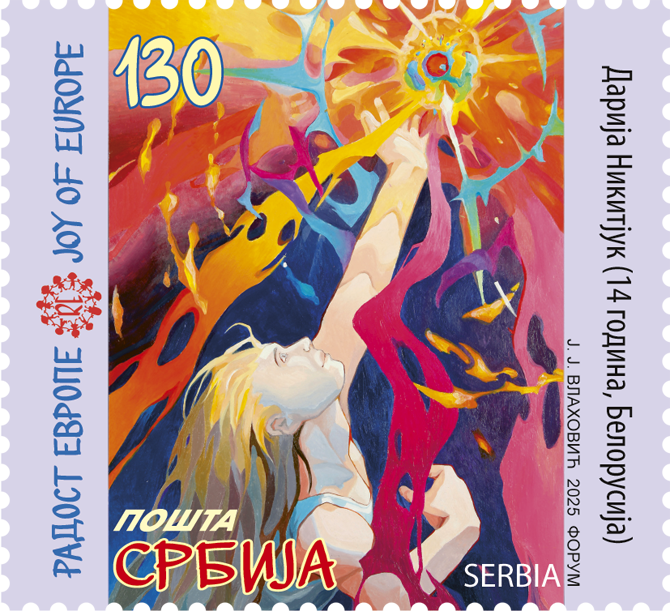
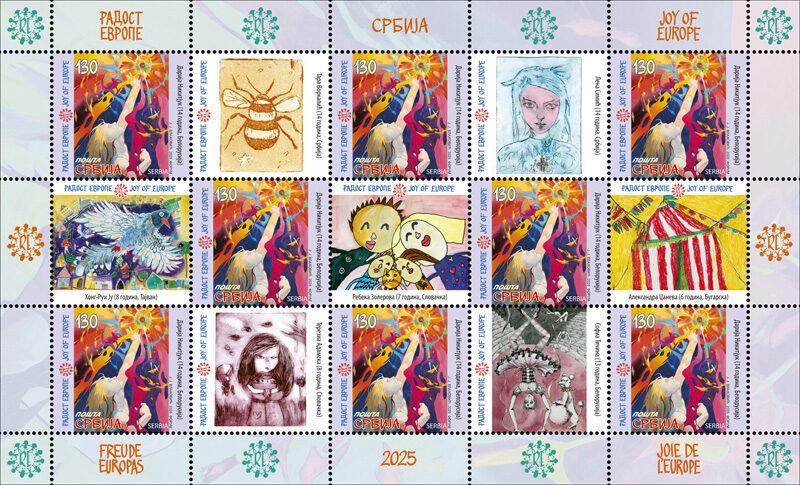
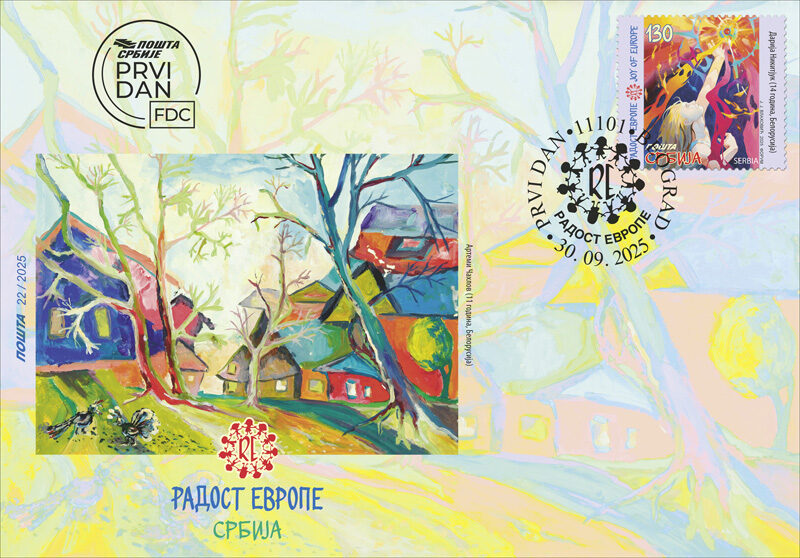
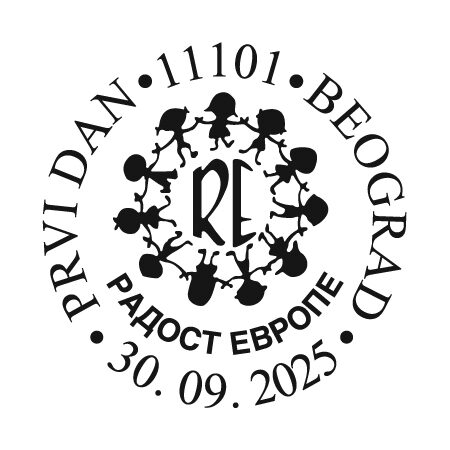
In 1969, on the occasion of the World Children’s Day, the first international festival of children’s songs and dances “Joy of Europe” was held in Belgrade with the support of the city authorities, President Tito, UNICEF and the United Nations General Assembly. More than half a century has passed since then and over 20,000 children have visited Belgrade. In 1998, the 25th jubilee meeting “Joy of Europe” received a new significant programme content – the International Art Competition, in which individuals, preschool institutions, schools, children’s art studios, children’s cultural centres and similar institutions and associations from all over the world have participated since its establishment (children and the youth aged 4 to 18). Artworks created in the pencil, tempera, gouache, watercolour, pastel, ink, collage or graphics techniques have been making up the rich palette of the traditional manifestation for 27 years.
The slogan of the 56th International Gathering of Children of Europe “Joy of Europe” is EVERYTHING IS POSSIBLE IF YOU BELIEVE IN IMPOSSIBLE! Inspired by Lewis Carroll’s masterpiece “Alice’s Adventures in Wonderland”, it was chosen to encourage both children and adults to dream without limits, explore a world full of wonders and believe even when things they dream about seem impossible.
This year, 2,610 works were submitted to the 27th International Art Competition “Joy of Europe”, from cities across Serbia, as well as cities from: Belarus, Bosnia and Herzegovina, Bulgaria, Egypt, India, Italy, Armenia, Lithuania, Macedonia, Namibia, Poland, Romania, Russia, Slovakia, Slovenia, Thailand, Taiwan, Croatia, Czech Republic, Montenegro, Finland and Hong Kong. Professionally selected artworks represent, on the one hand, a significant document of the visual culture of childhood, and on the other hand, a great incentive for young creators, as well as for art pedagogues and all those who support the purity of children’s expression, thoughts and creation.
The selected artworks, which arrived at the International Art Competition, traditionally find their place on the commemorative postage stamp “Joy of Europe” issued by the Public Enterprise “Post of Serbia” every year at the end of September.
The motif on the stamp is the work of Darija Nikitjuk (age 14, Belarus). The authors of the works on the vignettes are as follows: Tara Vorkapić (age 14, Serbia), Lena Simić (age 14, Serbia), Hong-Rui Yu (age 8, Taiwan), Rebeka Zollerova (age 7, Slovakia), Aleksandra Tsaneva (age 6, Bulgaria), Terezia Adamska (age 8, Slovakia), Sofia Tychyna (age 13, Belarus). The author of the work on the envelope is Artemy Schahlov (age 11, Belarus).
Expert collaboration: Lidija Seničar, editor of the International Art Competition “Joy of Europe”, Children’s Cultural Centre Belgrade.
Graphic realisation of the issue: MA Jakša Vlahović, academic graphic artist
Technical details
Date of issue: 30. 09. 2025.
Number of stamps in set: 1
Denomination:
1404: 130.00 RSD
Printrun: 15.000
FDC: 1
Sheet of: 8
Dimensions of stamp: 35 x 31,9 mm
Artistic realization: Jakša Vlahović
Subject: Joy of Europe
1404: Drawing by Darija Nikitjuk (age 14, Belarus)
Printer: Forum Novi Sad
Notable Serbs
200th anniversary of the birth of Đura Daničić
150th anniversary of the birth of Mileva Marić Einstein
100th anniversary of the birth of Stojan Ćelić
100th anniversary of the birth of Mihailo Đurić
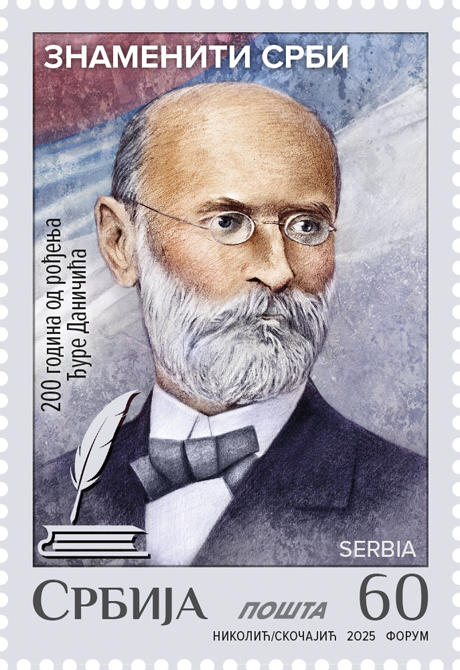
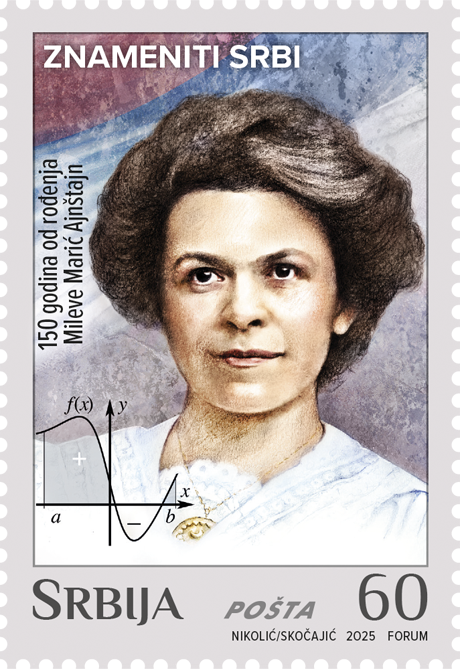

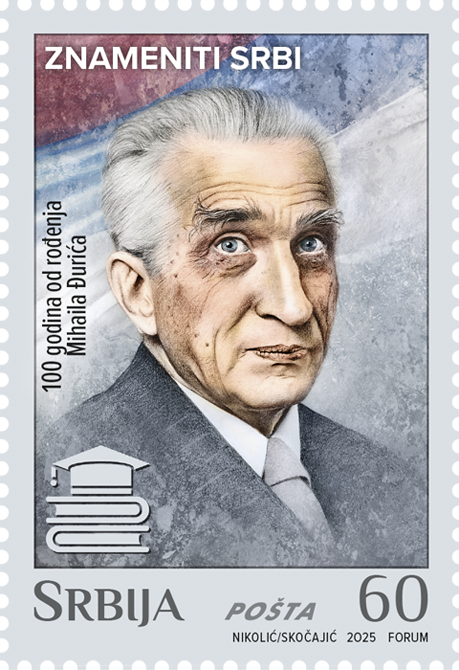
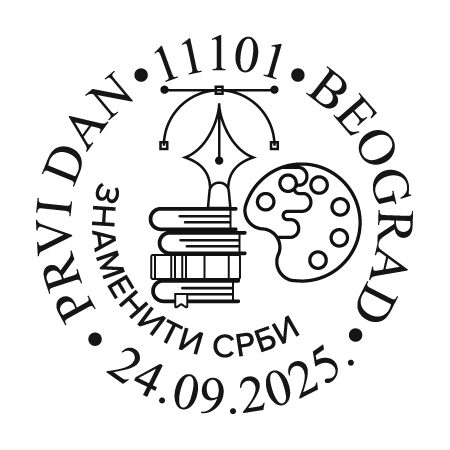
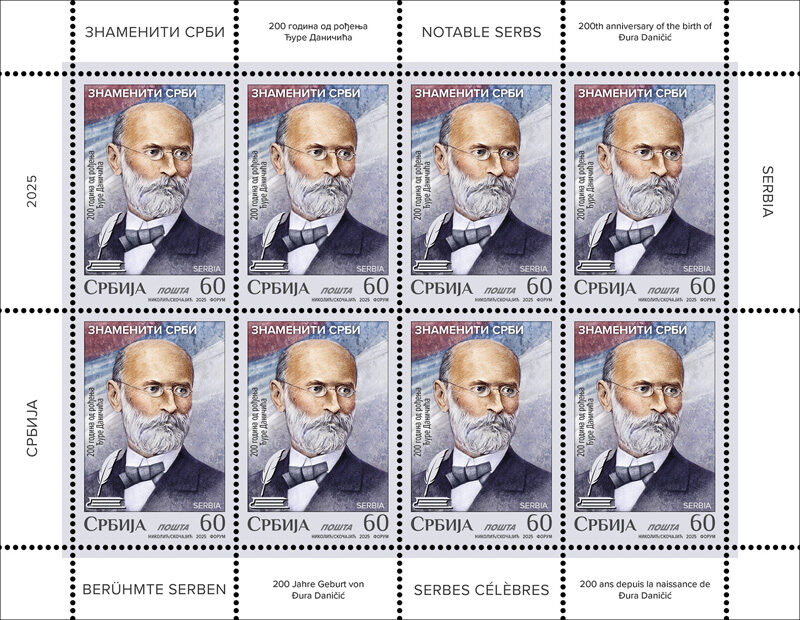
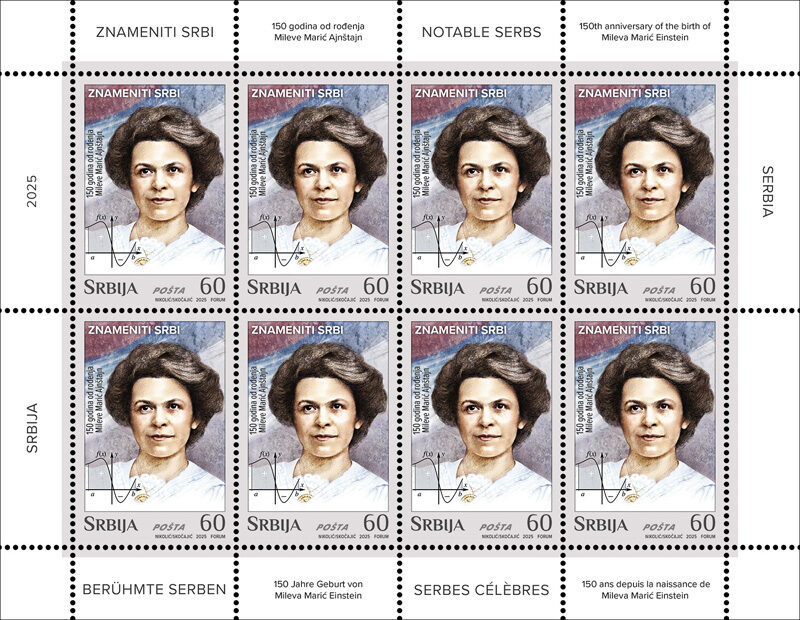
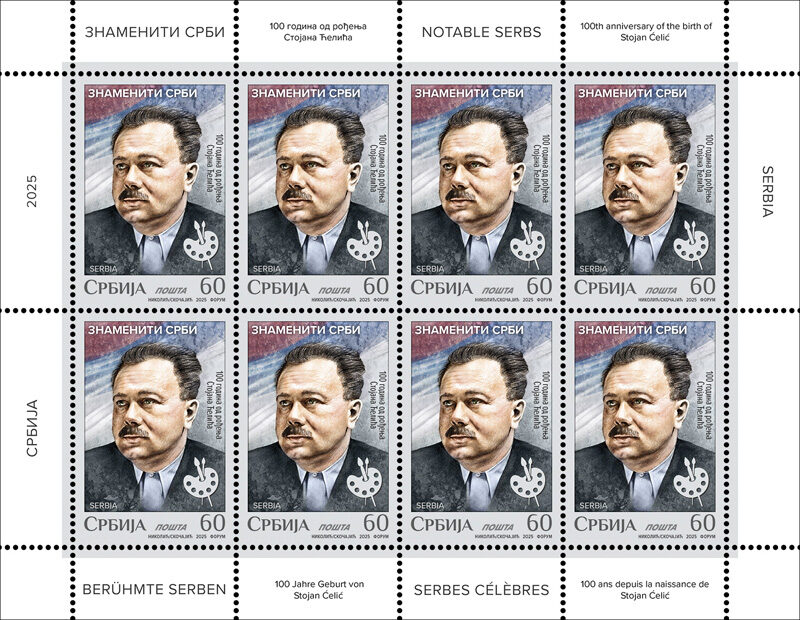

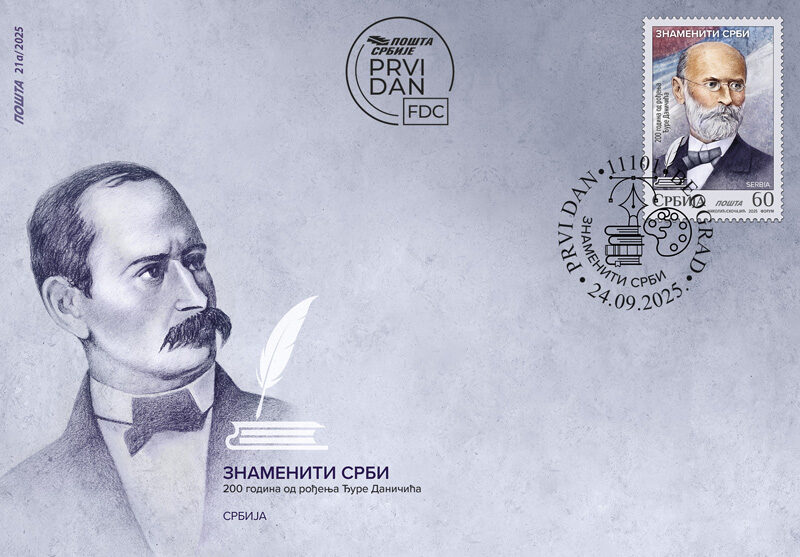
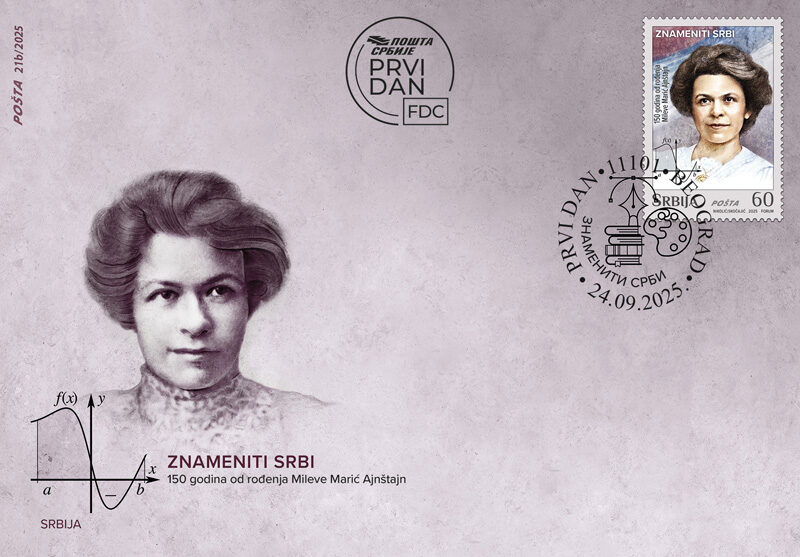
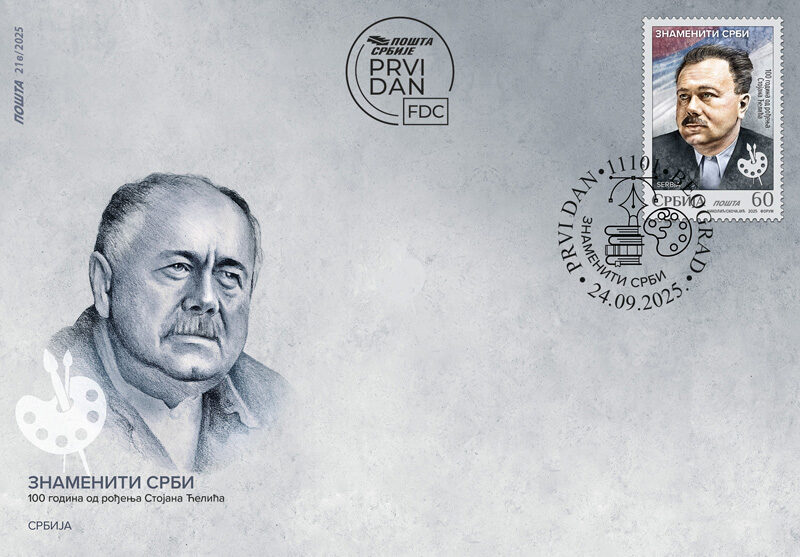
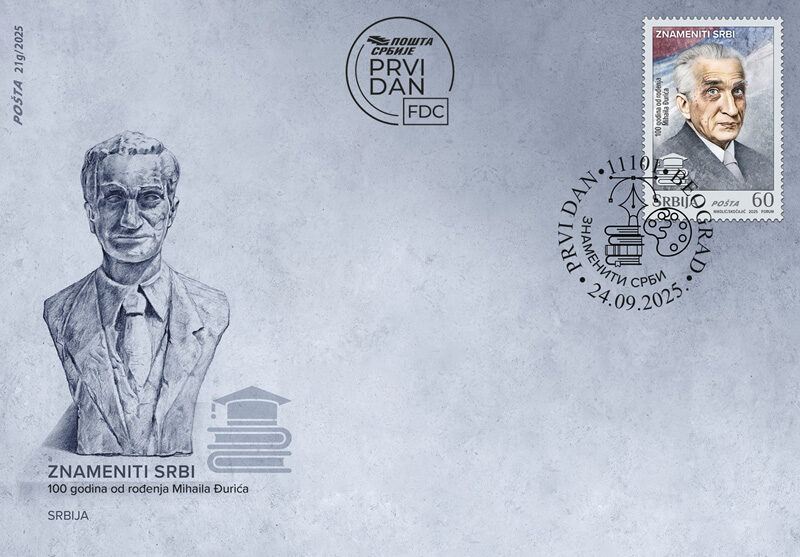
200th anniversary of the birth of Đura Daničić
Đura Daničić (April 6, 1825 – November 17, 1882), a Serbian philologist, member of the Society of Serbian Letters and the Serbian Learned Society, marked Serbian linguistics in the second half of the 19th century. An agile supporter of Vuk Karadžić›s reform, with his commitment and work he made an immeasurable contribution to the constitution of the Serbian literary language, describing and prescribing its morphological, syntactic and accentual system. He published the Little Serbian Grammar and Forms of the Serbian Language. He collaborated with Vuk on the second edition of the Serbian Dictionary, in which, owing to him, the marking of the four-accentual system was consistently implemented, and he also wrote several studies on Serbian accents. In the work Serbian Syntax, Daničić thoroughly described the case system of the Serbian language. His translations, the most famous of which is the translation of the Old Testament, are also of great importance for the codification of the Vuk type of literary language.
Daničić devoted himself to the study of Serbian linguistic and literary heritage and lexicographic work. The book History of Forms of the Serbian or Croatian Language until the End of the 17th Century is unsurpassed to this day. He compiled the Dictionary of Serbian Literary Antiquities, the first historical dictionary of the Serbian language. He was the initiator and first editor of the Dictionary of the Croatian or Serbian Language (YASA). He also published old Serbian manuscripts.
A versatile and tireless researcher in the field of synchrony and diachrony of the Serbian language and the founder of several scientific disciplines in Serbian philology, Daničić left a permanent mark on the history of our science and culture with his work.
Expert cooperation on the issue: Serbian Academy of Sciences and Arts, Department of Language and Literature.
150th anniversary of the birth of Mileva Marić Einstein
Mileva Marić Einstein (Titel 1875 – Zurich 1948), mathematician and physicist, scientific associate and wife of Nobel laureate Albert Einstein.
After completing elementary school in Ruma, in order to obtain secondary (grammar school) education, which was difficult for girls at the time, Mileva continued her education in Novi Sad, Sremska Mitrovica, Šabac and Zagreb. As one of the few Serbian women who dared to pursue a university education, in 1896 she went to Zurich, where she enrolled in physics and mathematics studies at the State Polytechnic School. Here she met Albert Einstein, with whom she began a scientific collaboration and emotional relationship, which was formalized in 1903 by marriage. In the following years, she continued to provide wholehearted scientific support to her husband, whose career was rapidly advancing. Particularly notable was the year 1905 (“The Year of Miracles”), when Albert published revolutionary works in the field of physics. Unfortunately, Mileva was not signed as a collaborator in these works, which places her among the female scientists who suffered great injustice by remaining anonymous and in the shadow of their partners. The Einstein couple separated in 1914, when Mileva began an independent life with her sons Hans Albert and Eduard. She was completely dedicated to raising, educating and caring for her children, continuing to struggle with social prejudices and numerous life challenges. When Albert Einstein received the Nobel Prize in 1921, he gave the entire amount of money to Mileva, as a kind of compensation for their joint scientific work, as well as for the needs of raising their children.
Expert cooperation on the issue: Ivana Jovanović Gudurić, Museum Advisor, City Museum of Novi Sad.
100th anniversary of the birth of Stojan Ćelić
Academician Stojan Ćelić (1925 – 1992) was one of the most significant representatives of Serbian contemporary art in the second half of the 20th century. As a painter, art theorist, essayist and professor, he left a deep and multifaceted mark on the cultural life of the country. His work developed from art informel to personal expression based on lyricism, structural balance and spiritual expression, thereby shaping an authentic visual language.
He was a full member of the Serbian Academy of Sciences and Arts and a long-time professor at the Faculty of Fine Arts in Belgrade, where his pedagogical and intellectual work shaped entire generations of artists. Ćelić was also a thoughtful writer on art – his texts and essays represent a significant contribution to the theory and understanding of contemporary art in the Serbian and Yugoslav context.
On the occasion of the centenary of his birth, the work and personality of Stojan Ćelić once again remind us of the enduring value of artistic authenticity, intellectual rigor, and an ethical approach to art. His oeuvre remains the foundation of contemporary Serbian visual culture.
Expert cooperation on the issue: Academician Branislav Mitrović.
100th anniversary of the birth of Mihailo Đurić
Mihailo Đurić (Šabac, August 22, 1925 – Belgrade, November 25, 2011) was a philosopher, legal professional and sociologist, full professor at the Faculty of Law, University of Belgrade, scientific advisor at the Institute of Social Sciences and full member of the Serbian Academy of Sciences and Arts. He graduated from the Faculty of Law in Belgrade (1949), where he also received his doctorate with the thesis “The Idea of Natural Law in the Greek Sophists” (1954). In the same year, he was elected assistant professor at the Faculty of Law in Belgrade, where he completed all university, i.e. academic titles (becoming full professor in 1969). He taught History of Political Theories, General Sociology and Methodology of Social Sciences.
During a debate on constitutional amendments, he warned of the dangers to the future of Yugoslavia and the Serbian people (1971), for which he was expelled from the University and sentenced to nine months in prison (1973). After serving his sentence, he worked at the Institute of Social Sciences in Belgrade (1974–1989). He was a visiting professor at the universities of Vienna, West Berlin and Augsburg. He returned to the Faculty of Law in 1989. He was judicially rehabilitated in 2009. He was the president of the Scientific Council of the Institute of Philosophy of the Faculty of Philosophy in Belgrade (1986–1997). He was elected a corresponding member of the Serbian Academy of Sciences and Arts in 1994, and a full member in 2000.
He published his collected works in 12 volumes (2009). His works dedicated to ancient philosophy (Humanism as a Political Ideal), sociology (Sociology of Max Weber, etc.), Nietzsche’s philosophy (The Challenge of Nihilism, Nietzsche and Metaphysics, Paths to Nietzsche) and Serbian philosophy are especially well known.
Expert cooperation on the issue: Serbian Academy of Sciences and Arts, Department of Social Sciences.
Artistic realization of the issue: Miroslav Nikolić and MA Nadežda Skočajić, Academic Graphic Artist.
Technical details
Date of issue: 24. 09. 2025.
Number of stamps in set: 4
Denomination:
1400: 60.00 RSD
1401: 60.00 RSD
1402: 60.00 RSD
1403: 60.00 RSD
Printrun: 15.000
FDC: 4
Sheet of: 8
Dimensions of stamp: 29 x 42 mm
Artistic realization: Miroslav Nikolić, Nadežda Skočajić
Subject: Notable Serbs
1400: Đura Daničić
1401: Mileva Marić Einstein
1402: Stojan Ćelić
1403: Mihailo Đurić
Printer: Forum Novi Sad
1700 years since the First Ecumenical Council of Nicaea
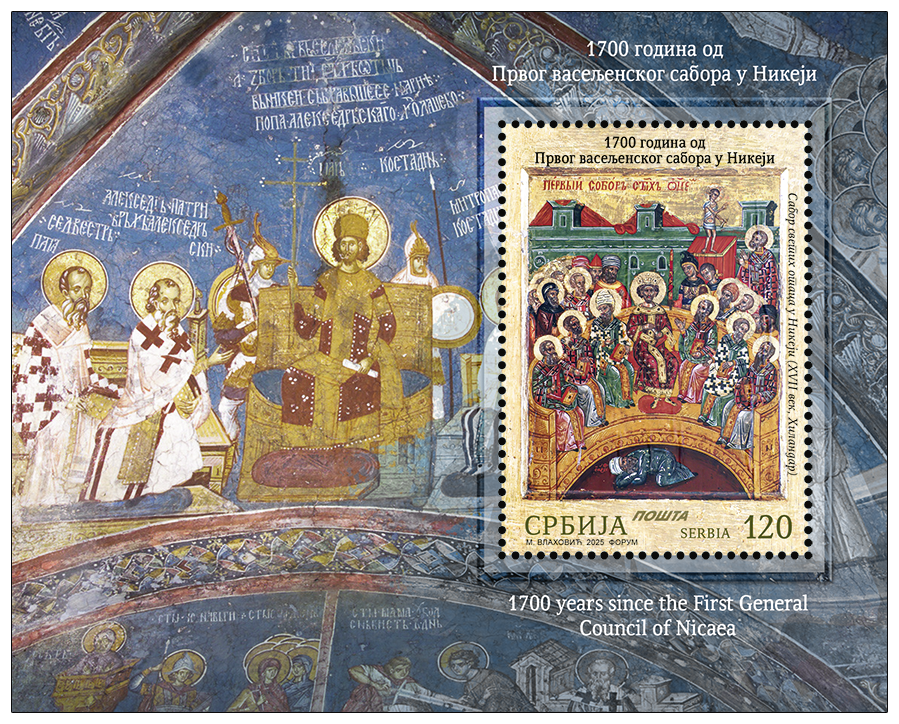
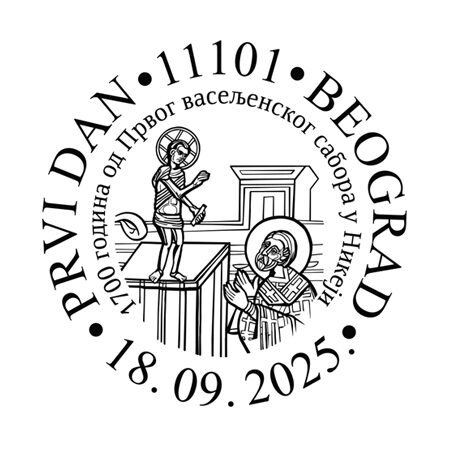
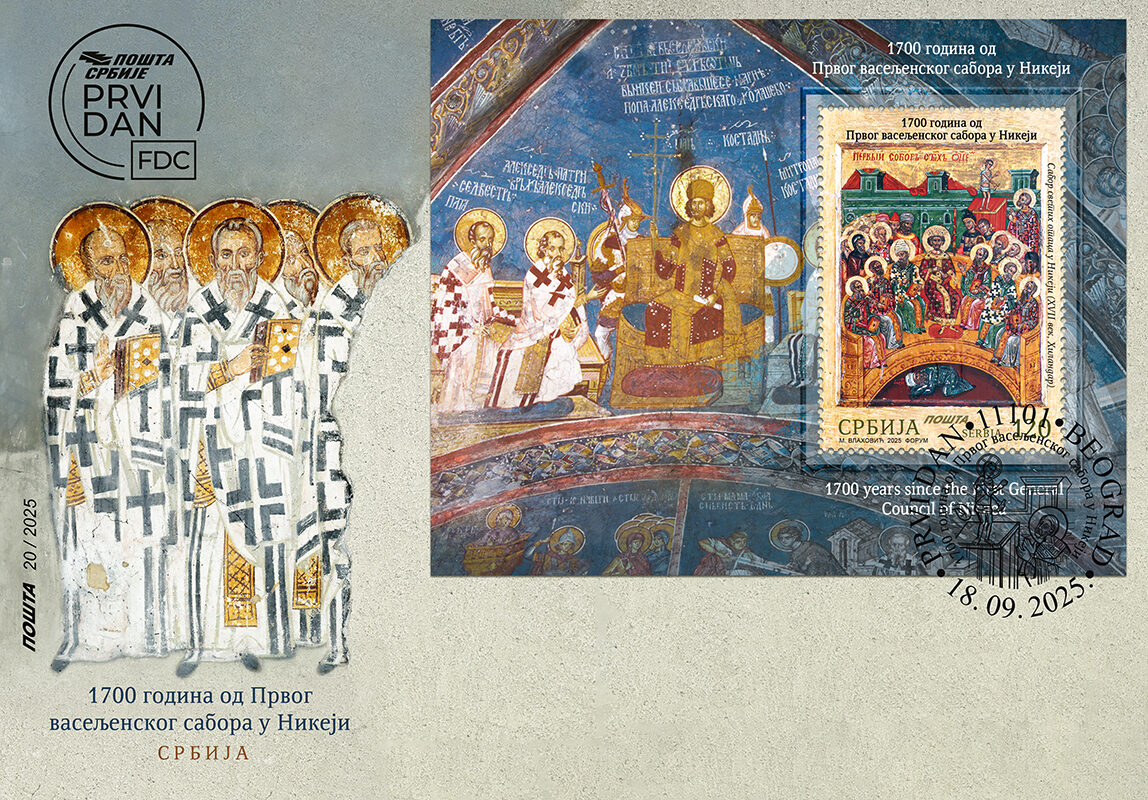
After the great persecution of Christians at the beginning of the 4th century, followed by the adoption of the Edict of Milan (313) and several local councils in the east and west of the Roman Empire, during the reign of Emperor Constantine the Great (306–337), conditions were created for resolving key church issues at the ecumenical level. The First Ecumenical Council was convened at the initiative of Emperor Constantine and was held in Nicaea (today the town of Iznik in Turkey), from May 20 to August 25, 325. The Council was convened by the Emperor, and the immediate cause was the heresy of Arius in Alexandria. About 300 bishops participated in the work of the Council. The vast majority of bishops represented Christian communities from the east of the Roman Empire: Alexander of Alexandria, Eustathius of Antioch, Macarius of Jerusalem, St. Nicholas, St. Paphnutius, St. Hypatius, St. Spyridon, Jacob the Persian, Eusebius of Caesarea, etc. Pope Sylvester I sent two priests, Vitus and Vincentius, to represent the Church of Rome.
The Council was opened by Emperor Constantine with an occasional speech. The initial topic of the Council was the Arian heresy, which the participants immediately condemned, and Arius was exiled to Illyricum. After great debate, the majority of the bishops adopted a confession of faith – the Nicene Creed. The Melitian schism in the Church of Alexandria was also resolved at this Council, because Melitius’ unseemly ecclesiastical actions violated the rights and customs of the church order and the apostolic canons. At the end of the Council’s work, it was decided that all Christians would celebrate Easter together on the same day. The Council fathers compiled 20 canons in order to regulate the internal church life and discipline of Christians.
The entire period between the First (325) and Second (381) Ecumenical Councils was characterized by the struggle with heretics for the intact Orthodox confession and the final definition of the Nicene-Constantinopolitan Creed (381), which is still being read at services in the Christian church today.
Professional cooperation on the issue: Museum of the Serbian Orthodox Church, Deacon Ivica Čairović, PhD
Artistic realisation of the issue: MA Marija Vlahovic, academic graphic artist
Technical details
Date of issue: 18. 09. 2025.
Number of stamps in set: block with 1 stamp
Denomination and printrun:
Block 116: 120.00 RSD, 10.000
FDC: 1
Artistic realization: Marija Vlahović, Academic Graphic Artist
Subject: 1700 years since the First Ecumenical Council of Nicaea
Block116: on the stamp is the icon Council of the Holy Fathers in Nicaea (17th century, Hilandar Monastery); on the block is a fresco of the First Ecumenical Council in Nicaea, Dečani Monastery
Issue format: block
Dimensions of the block: 100 x 80mm
Dimensions of the stamp in block: 35 x 49,3 mm
Perforations: 13 3/4
Printer: Forum Novi Sad
EXPO 2025 Osaka Kansai
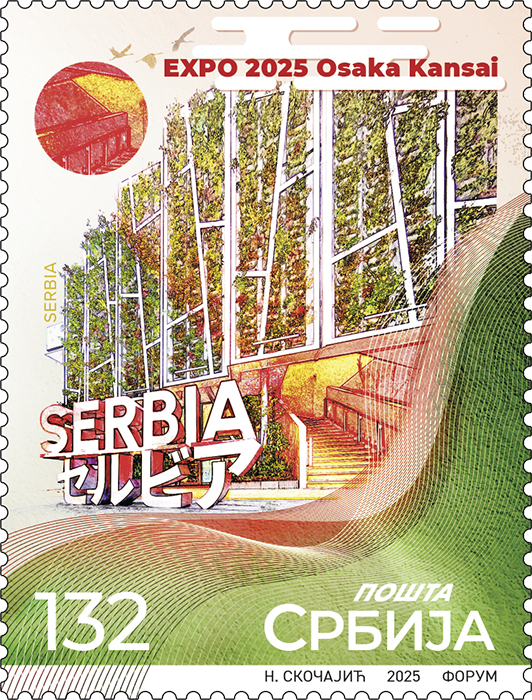
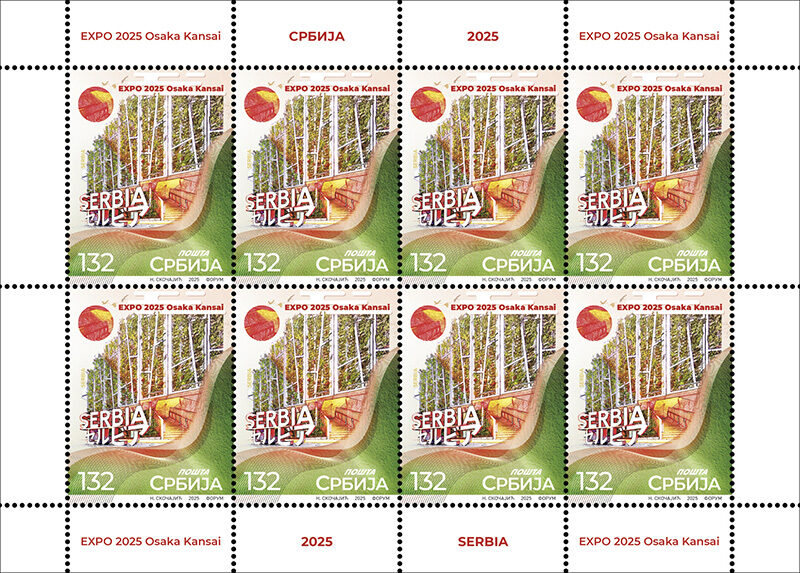
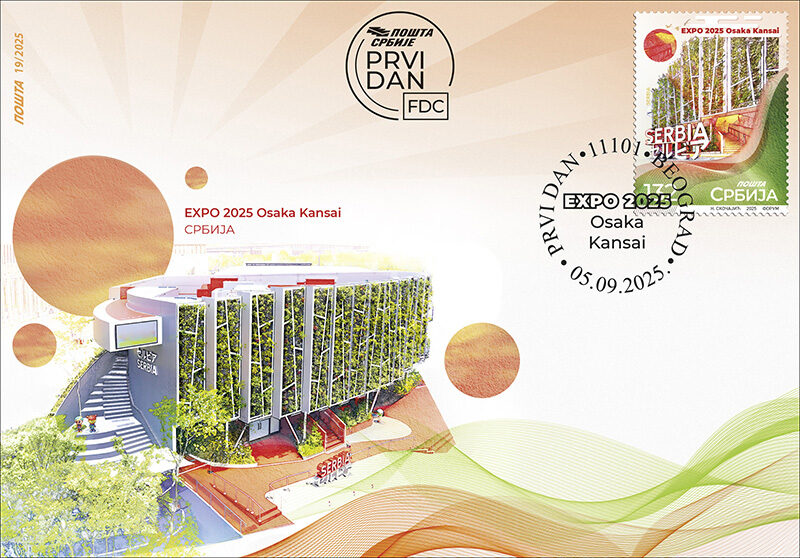
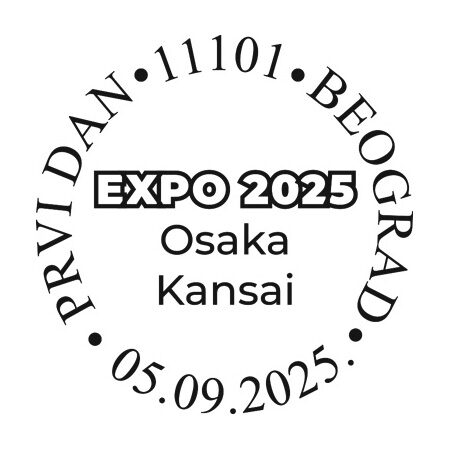
The Pavilion of the Republic of Serbia at the World Exhibition Expo 2025 in Osaka is a symbol of sustainable architecture, imbued with cultural content that combines technological vision and emotional narrative. Inspired by Belgrade’s Great War Island, which is a protected natural resource, the National Pavilion of Serbia is the only pavilion at the Osaka World Expo with a natural, green facade.
During the design and construction, special attention has been paid to sustainability, therefore 95% of the materials from which the Pavilion has been built are recyclable, and 80% are reusable. The dynamic design of the Pavilion of the Republic of Serbia exhibition represents a distinctive bridge that connects the theme of the World Exhibition Expo 2025 Osaka – “Society 5.0” with the theme of the Specialized World Exhibition Expo 2027 Belgrade – “Play for Humanity”.
The pavilion of the Republic of Serbia has been ranked among the most interesting ones by the most influential Japanese and world portals as it offers visitors the opportunity to discover the importance of play in all aspects of life through music, dance, sports, science and technology.
Expert cooperation on the issue: Ministry of Domestic and Foreign Trade; Chamber of Commerce and Industry of Serbia; Photographer Dragan Kujundžić; “EXPO 2027 d.o.o.”.
Artistic realization of the issue: MA Nadežda Skočajić, Academic Graphic Artist.
Technical details
Date of issue: 05. 09. 2025.
Number of stamps in set: 1
Denomination:
1398: 132.00 RSD
Printrun: 15.000
FDC: 1
Sheet of: 8
Dimensions of stamp: 31,9 x 42 mm
Artistic realization: Nadežda Skočajić
Subject: EXPO 2025 Osaka Kansai
1398 – The Pavilion of the Republic of Serbia at the World Exhibition Expo 2025 in Osaka
Printer: Forum Novi Sad
Serbia – Switzerland
150th anniversary of the birth of Rodolphe Archibald Reiss
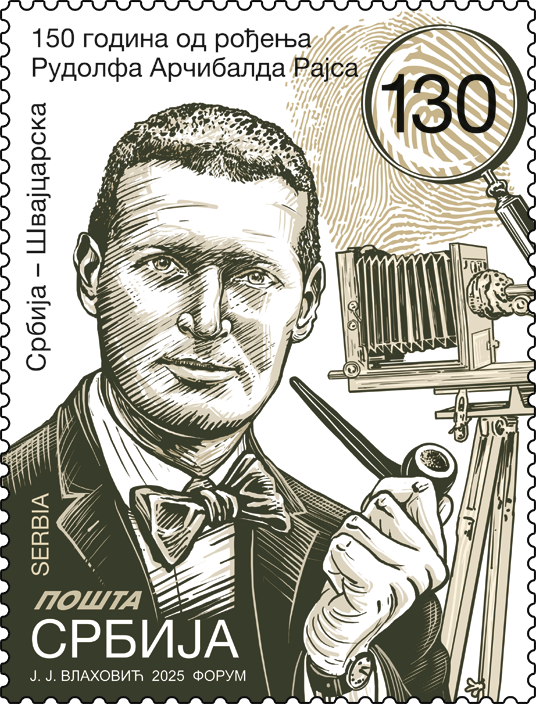
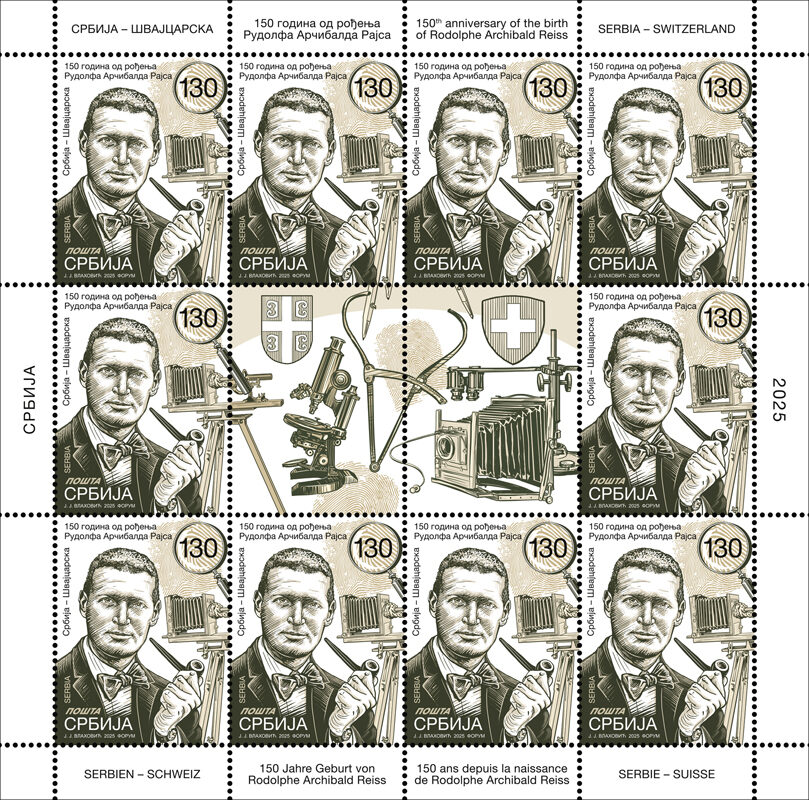
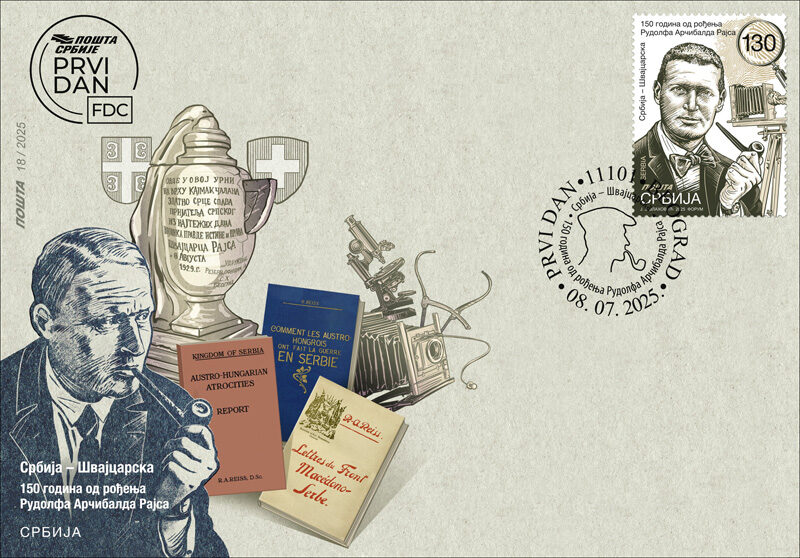
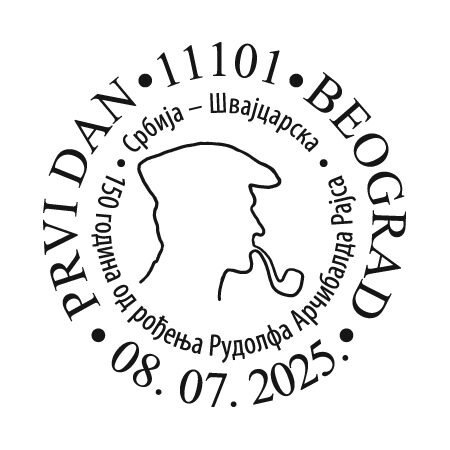
Rodolphe Archibald Reiss (Hechtsberg, Hausach, July 8, 1875 – Belgrade, August 8, 1929) was a Swiss forensic scientist, criminal expert, university professor, publicist, and a great friend of the Serbian people.
He received a doctorate in chemistry and became an assistant professor at the University of Lausanne, dealing with photography and forensics, and in 1902 he began teaching forensic medicine, becoming a full professor in 1906.
After the outbreak of World War I in 1914, Archibald Reiss came to Serbia, at the invitation of the Serbian government, to investigate the crimes of the Austro-Hungarian army against the civilian population. His newspaper reports on the suffering of Serbs issued during 1914 were published in Paris in 1915 in a separate book “Comment les Austro–Hongrois ont fait la guerre en Serbie”, and then in London, in 1916, in English (How Austria-Hungary Waged War in Serbia: Personal Investigations of a Neutral).
Reiss later went through the Albanian Golgotha, Corfu and the Salonika Front with the Serbian army, documenting the wartime suffering and the lives of Serbian soldiers, which he published after the war in the piece “Letters of a Criminologist on the Serbian Macedonian Front” and his war diary “What I have Seen and Lived in Great Days”.
He was a staunch supporter of the creation of the Yugoslav state and a member of the Yugoslav government delegation at the Paris Peace Conference in 1919. After the war, he settled in Serbia and received citizenship. Known for his dedication to truth, justice, and love for Serbia, he wrote about social problems, disappointed with the conditions in the new state. His most famous work, “Listen, Serbs!”, was published after his death, according to his order.
He died on August 8, 1929 in Belgrade. According to his express wish, his heart was buried in Kajmakčalan, next to the fallen Serbian soldiers. Honorary Captain of the Serbian Army Archibald Reiss, the recipient of the World War I medal, was awarded the Order of the White Eagle with swords and two medals for bravery. History remembers him as one of the most sincere friends of Serbia and a symbol of honesty, humanity and sacrifice.
Professional cooperation: Prof. Milan Radovanović, PhD, Embassy of Switzerland in Belgrade and University Library “Svetozar Marković” Belgrade
Artistic realization of the issue: MA Jakša Vlahović, academic graphic artist
Technical details
Date of issue: 08. 07. 2025.
Number of stamps in set: 1
Denomination:
1392: 130.00 RSD
Printrun: 15.000
FDC: 1
Sheet of: 10
Dimensions of stamp: 31,9 x 42 mm
Artistic realization: Jakša Vlahović
Subject: 150th anniversary of the birth of Rodolphe Archibald Reiss
1392 – Portrait of Archibald Reiss, his fingerprint and forensic apperature
Printer: Forum Novi Sad
Serbia – United States of America
100th anniversary of the birth of Douglas Engelbart
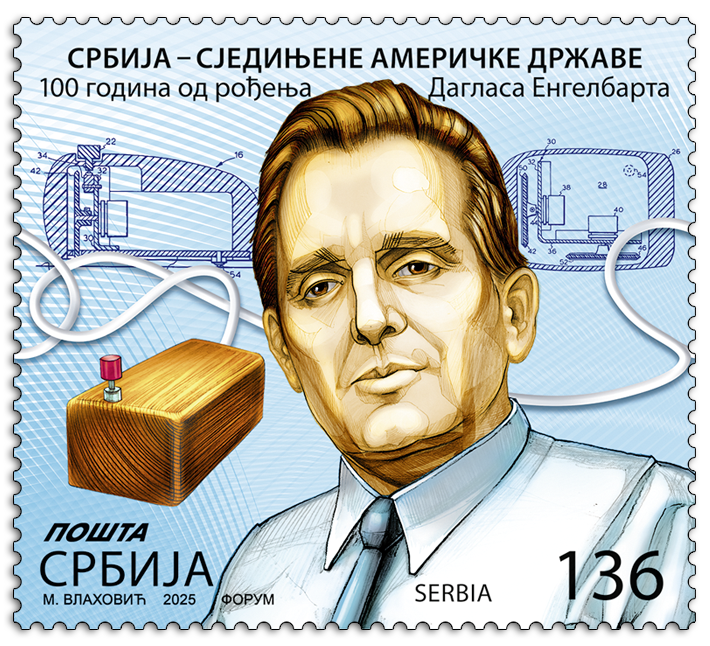
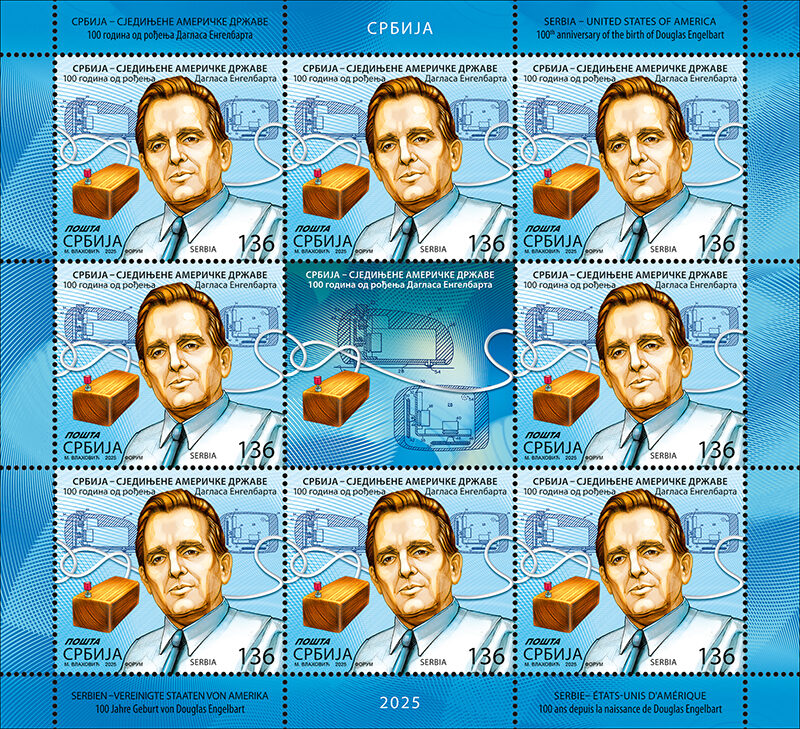
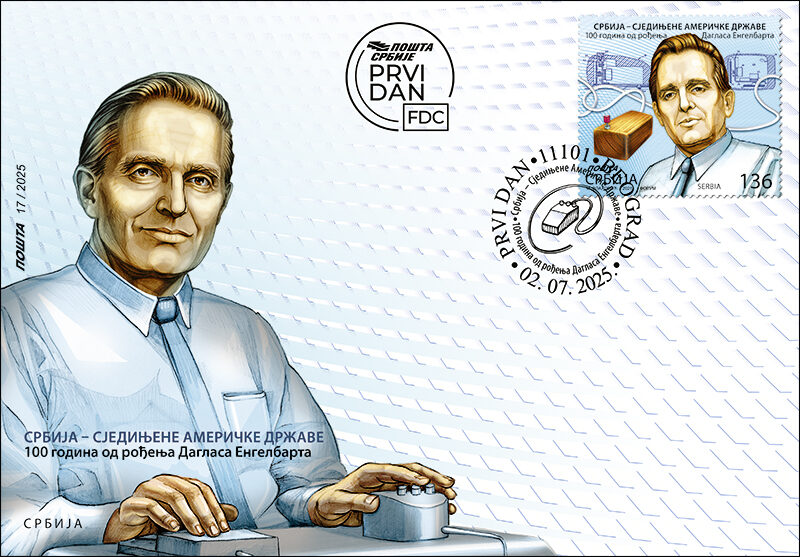
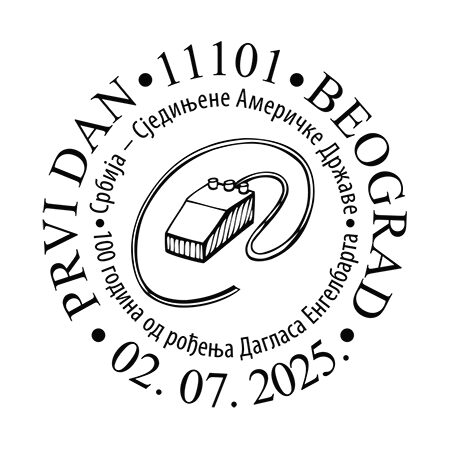
Douglas Carl Engelbart (January 30, 1925 – July 2, 2013), an engineer and inventor, was one of the key figures in the history of computer technology development. He studied electrical engineering at the University of Oregon and received his doctorate from the University of California, Berkeley, in 1955.
Engelbart believed that computers should not only serve to automate tasks, but above all, to help people solve complex problems more easily. His vision of making the world a better place was based on the concept of collective intelligence and the improvement of human capabilities through computer technology. While conducting research in the field of computer science and developing technologies and concepts of human-computer interaction at the Stanford University Research Institute in California, he and his collaborators developed the user-friendly “oN-Line System“ (NLS), and he also participated in the development of the computer network “ARPANET”, a national network for connecting scientific researchers, which was the basis for the emergence of the Internet.
He will be remembered in the history of computer science for his demonstration on December 9, 1968, later called the “Mother of All Demos”, which, in addition to the prototype of the computer mouse, also demonstrated for the first time in the history of computer science an interactive interface with structural links, working in multiple text panels on the same screen (the precursor to “windows”), as well as video calls and online communication in real time – today the basic elements of everyday computer use.
For his visionary work and ideas that paved the way for the digital age, Douglas Engelbart, a computer scientist pioneer and inventor, was awarded the National Medal of Technology by the President of the United States. He was inducted into the American Academy of Arts and Sciences in 1994.
Professional cooperation: Saša Šepec, Museum of Science and Technology, Belgrade
Artistic realisation of the issue: MA Marija Vlahovic, academic graphic artist
Technical details
Date of issue: 02. 07. 2025.
Number of stamps in set: 1
Denomination:
1391: 136.00 RSD
Printrun: 15.000
FDC: 1
Sheet of: 8
Dimensions of stamp: 42 x 37,7 mm
Artistic realization: Marija Vlahović, Academic Graphic Artist
Subject: Serbia – United States of America: 100th anniversary of the birth of Douglas Engelbart
1391: portrait of Douglas Carl Engelbart in the moment of demonstration on December 9, 1968; the prototype of the first computer mouse
Perforations: 13 3/4
Printer: Forum Novi Sad
Danube Day
200th anniversary of the birth of Johann Strauss II
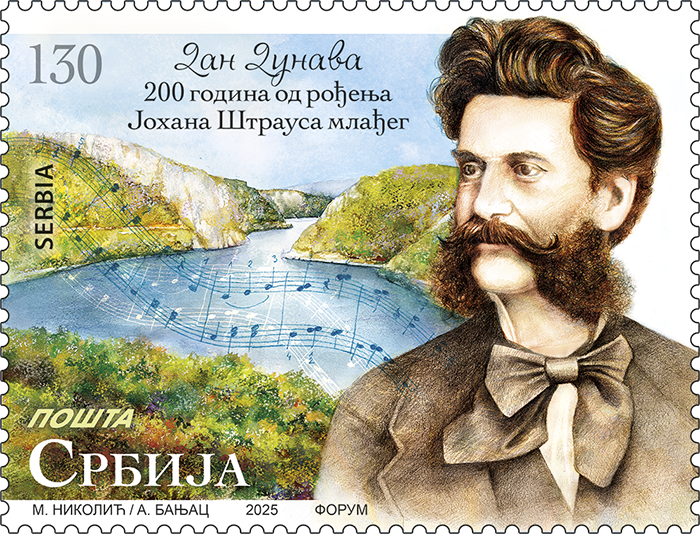
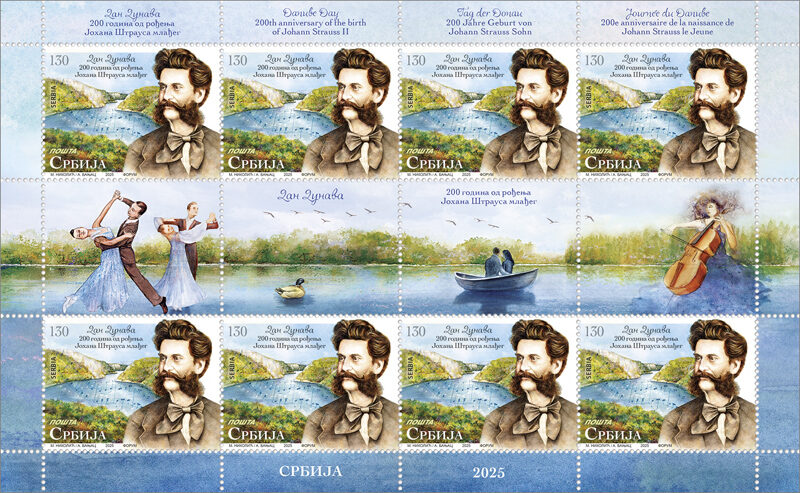

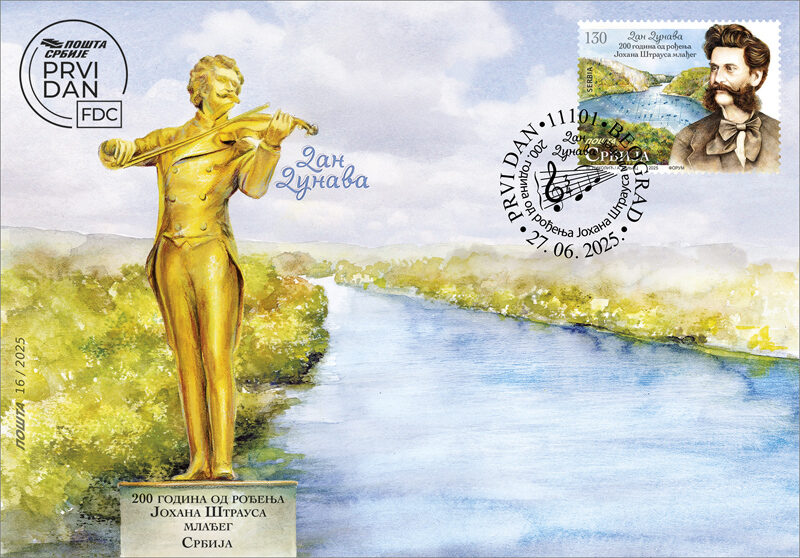
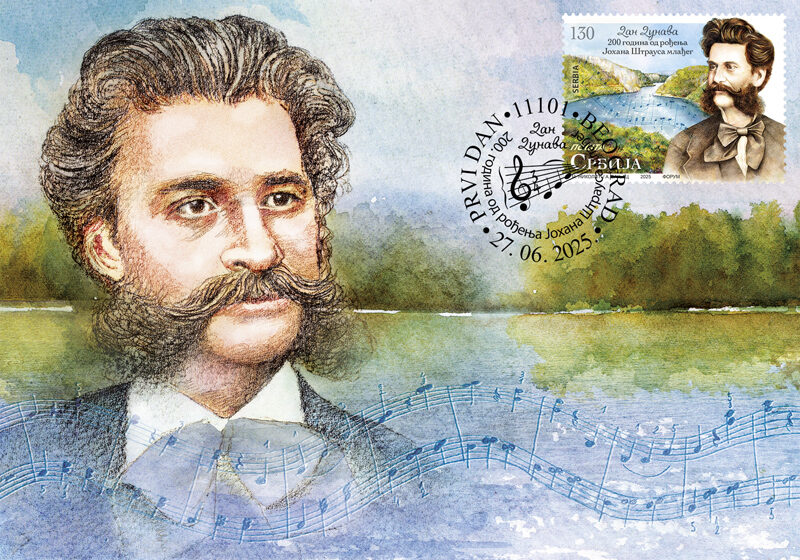
Danube Day was established on 29 June 1994, when the Convention on Cooperation for the Protection and Sustainable Use of the Danube River was signed in Sofia. This, the second longest river in Europe, with a flow of approximately 2,850 km from its source in the Black Forest Mountains in Germany to its drainage basin in the Black Sea in Romania and Ukraine, forms the most diverse ecosystems and a wealth of biodiversity, the preservation of which is the focus of Danube Day.
The Danube flows through ten countries: Germany, Austria, Slovakia, Hungary, Croatia, Serbia, Romania, Bulgaria, Moldova and Ukraine and connects millions of people living in its basin. For many cities, above all Vienna, Budapest and Belgrade, the Danube is also an important historical, economic and cultural symbol, immortalized in many works of art, of which the most famous musical composition is certainly the waltz “The Blue Danube”, composed by Johann Strauss the Younger (October 25, 1825 – June 3, 1899).
This native of Vienna is the author of more than 500 compositions – waltzes, polkas, mazurkas and operettas such as “The Bat” and “The Gypsy Baron”, which have placed him among the most popular, most beloved and most performed composers in the history of classical music. The music of Johann Strauss the Younger, whose 200th anniversary of birth we are celebrating this year, exudes elegance, rhythm and cheerfulness, and the waltz “The Blue Danube”, a symbol of the Vienna of his time, has long since transcended the boundaries of Austrian musical tradition and become a sort of anthem of the Danube.
The celebration of Danube Day not only reminds us of the importance of this river in the lives of millions of people, but also inspires joint efforts to preserve the natural resources of the Danube, preserve water quality, protect Danube ecosystems, and preserve its nature for generations to come.
The Danube is a river that connects people, cultures and nature and deserves our care and respect.
Artistic realization of the issue: Miroslav Nikolić and Anamari Banjac, Academic Painter
Technical details
Date of issue: 27. 06. 2025.
Number of stamps in set: 1
Denomination:
1390: 130.00 RSD
Printrun: 15.000
FDC: 1
Maximum card: 1
Sheet of: 8
Dimensions of stamp: 42 x 31,9 mm
Artistic realization: Miroslav Nikolić, Anamari Banjac
Subject: Danube Day
1390 – Portrait of Johann Strauss II, Iron gate of Danube and “The Blue Danube” partiture
Printer: Forum Novi Sad
150 years of the Nevesinje Rifle
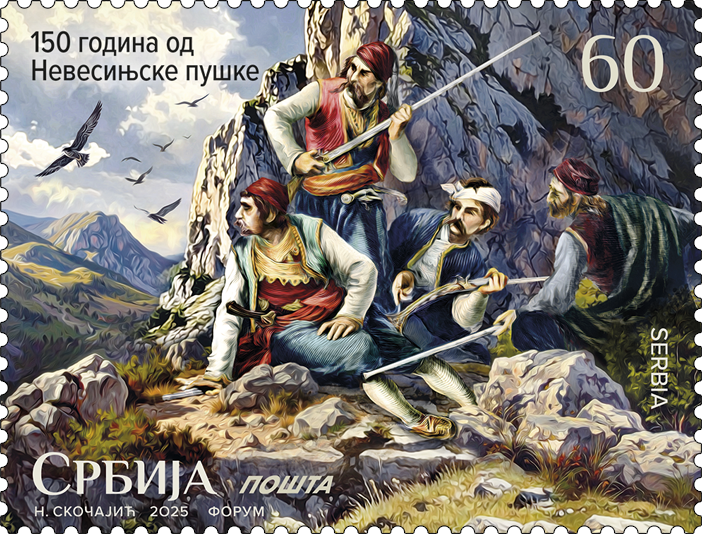
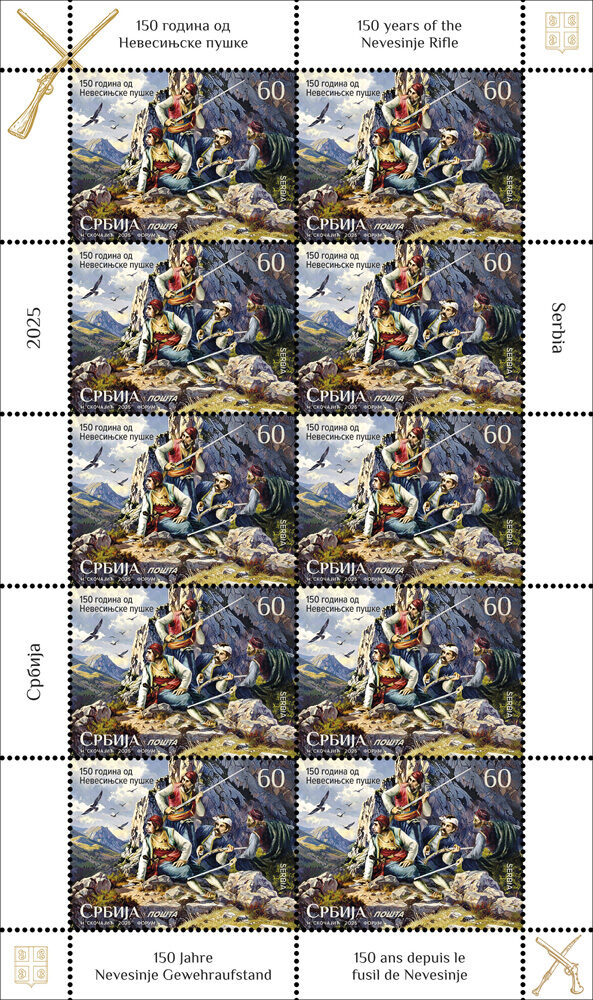
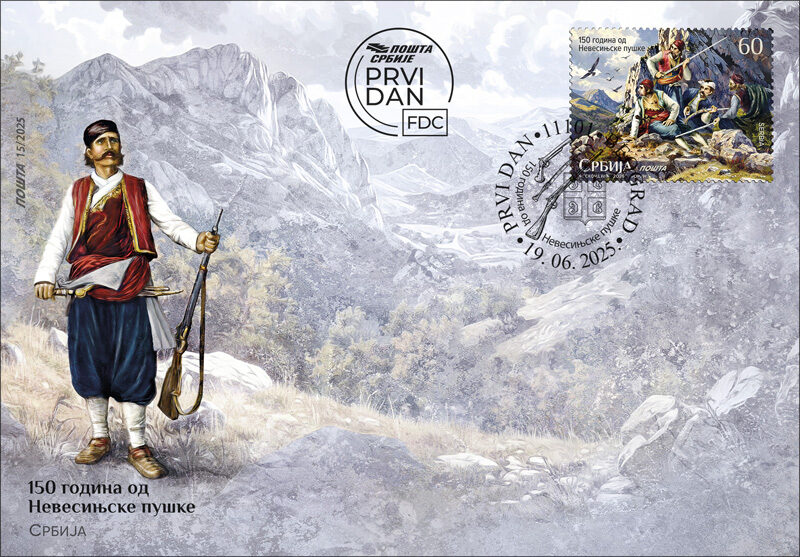
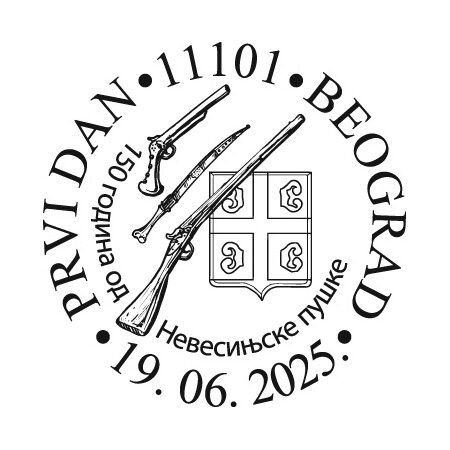
July 9, 2025 marks the 150th anniversary of the first organized struggle of the Nevesinje insurgents for liberation from centuries of Ottoman rule.
The flames of uprising spread to all of Herzegovina and Bosnia, and Montenegro, Serbia, and Russia also entered the war against Turkey. The three-year war ended with the Congress of Berlin, at which Serbia and Montenegro gained internationally recognized independence and territorial expansion, while Herzegovina and Bosnia, instead of the freedom they had earned through struggle and unification with Montenegro and Serbia, were united into one entity by the will of the great powers and occupied by the Austro-Hungarian monarchy.
The uprising is known in historical science as the Nevesinje Rifle and it had an extremely large resonance, not only in the Balkan Peninsula where the Serbian people lived, but also among other freedom-loving peoples throughout Europe. The uprising initiated unprecedented diplomatic activity by the great European powers. The most important Serbian and world media reported on the insurgents, the goals of their struggle, and their brilliant victories against the many times more numerous and better equipped units of the regular Turkish army and the local Bashibozuk, and folk artists sang numerous songs that became an integral part of the collective memory of the Serbian people.
The Nevesinje Rifle is also the first event in recent Serbian history that had a direct impact on European and world politics and international relations. The armed uprising of the Serbian people in Herzegovina and Bosnia, started on July 9, 1875 in the vicinity of Nevesinje, was one of the events that influenced all subsequent events in Serbian, European and world history from the late 19th and early 20th centuries. The uprising subsequently led to the largest conflict in the history of mankind at that time, World War I, which resulted in the collapse of monarchical Europe and the emergence of new states, as well as the final liberation and unification of the Serbs.
Professional cooperation: Association of the People of Nevesinje in Belgrade
Artistic realization: Nadežda Skočajić, Academic Graphic Artist
Technical details
Date of issue: 19. 06. 2025.
Number of stamps in set: 1
Denomination:
1389: 60.00 RSD
Printrun: 25.000
FDC: 1
Sheet of: 10
Dimensions of stamp: 42 x 31,9 mm
Artistic realization: Nadežda Skočajić
Subject: 150 years of the Nevesinje Rifle
1389 – Freedom fighters in the Herzegovina hills
Printer: Forum Novi Sad
125 years since Serbia’s participation in the World Expo
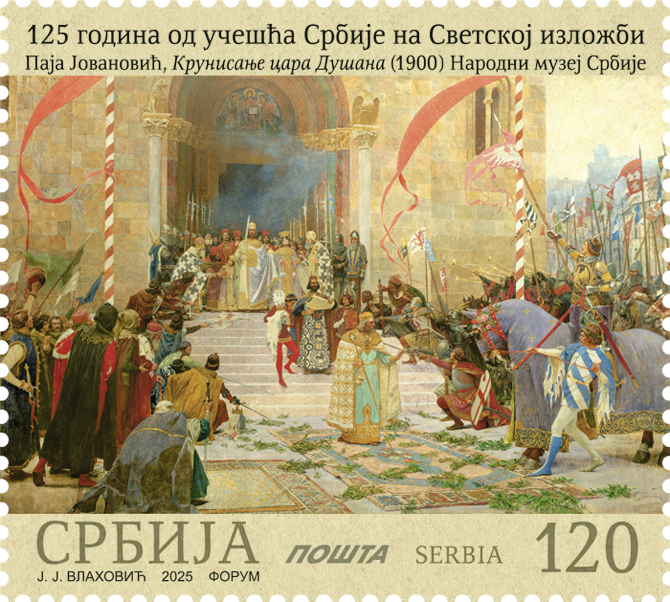

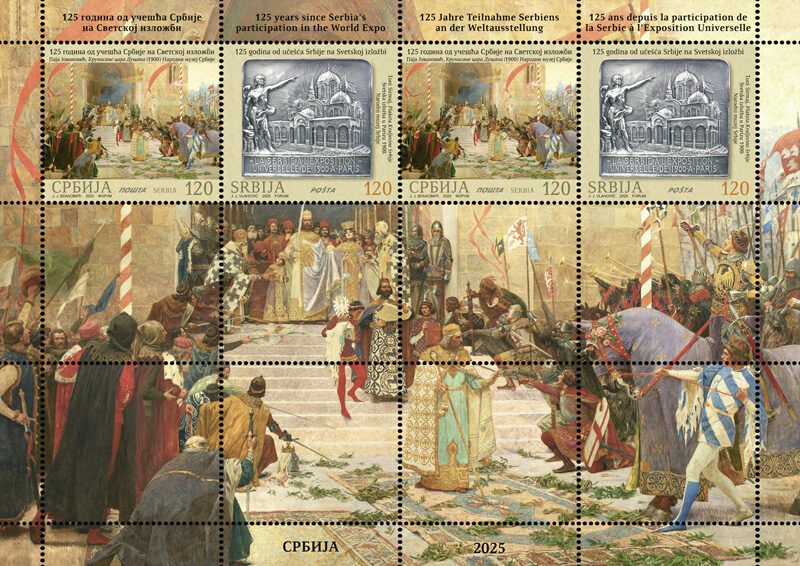


One of the most important World Expos at the turn of the century was held in Paris in 1900, under the name Exposition Universelle 1900. It lasted from April to November and had over 50 million visitors. The exhibition presented numerous scientific and technological achievements of the time. The first modern Olympic Games outside of Greece were also held as part of the Exposition Universelle 1900.
The pavilion of the Kingdom of Serbia, resembling Serbian monasteries in the Serbian-Byzantine style, covering an area of 550m2, was erected on the banks of the Seine. It was designed by the professor of the Great School Milan Kapetanović and the architect Milorad Ruvidić. In it, Serbia exhibited folk handicrafts, agricultural products, mineral waters, brandies and wines, ores and minerals, as well as furniture, carpets and products of the Kragujevac Topolivnica (Cannon Foundry), which presented the trade, production and industrial potential of Serbia.
The works of art exhibited in our pavilion, which depict themes from national history and folk life, were created by the most famous Serbian artists of the time, including Paja Jovanović, Đorđe Krstić, Marko Murat, Rista and Beta Vukanović, Petar Ubavkić, Leon Koen and Simeon Roksandić.
Serbia’s notable and thoroughly prepared performance was crowned with numerous awards – Grand Prix awards and gold, silver and bronze medals. One of them went to mathematician, professor of the Great School and academician Mihailo Petrović Alas, for an analogue computer for solving differential equations. Paja Jovanović’s monumental artistic composition Coronation of Emperor Dušan, painted by order of the Government of the Kingdom of Serbia, and Đorđe Jovanović’s sculpture Kosovo Monument were awarded gold medals.
Stamp motifs: Pavle Paja Jovanović, Coronation of Emperor Dušan (1900), oil on canvas; Tony Szirmai, Plaque of the Kingdom of Serbia, Exposition Universelle 1900, Paris, silver-plated bronze. Works from the collection of the National Museum of Serbia in Belgrade.
Professional cooperation: National Museum of Serbia, Belgrade
Artistic realization of the issue: MA Jakša Vlahović, academic graphic artist
Technical details
Date of issue: 10. 06. 2025.
Number of stamps in set: 2
Denomination:
1387: 120.00 RSD
1388: 120.00 RSD
Printrun: 15.000
FDC: 1
Sheet of: 4
Dimensions of stamp: 42 x 37,7 mm
Artistic realization: Jakša Vlahović
Subject: 125 years since Serbia’s participation in the World Expo
1387 – Pavle Paja Jovanović, Coronation of Emperor Dušan (1900), oil on canvas, National Museum of Serbia in Belgrade
1388 – Tony Szirmai, Plaque of the Kingdom of Serbia, Exposition Universelle 1900, Paris, silver-plated bronze, National Museum of Serbia in Belgrade
Printer: Forum Novi Sad
185 years of the Post of Serbia
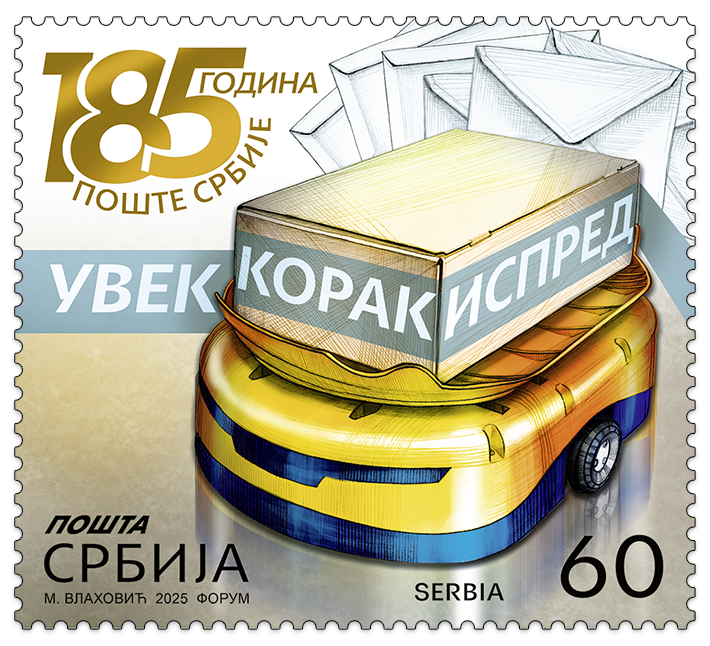
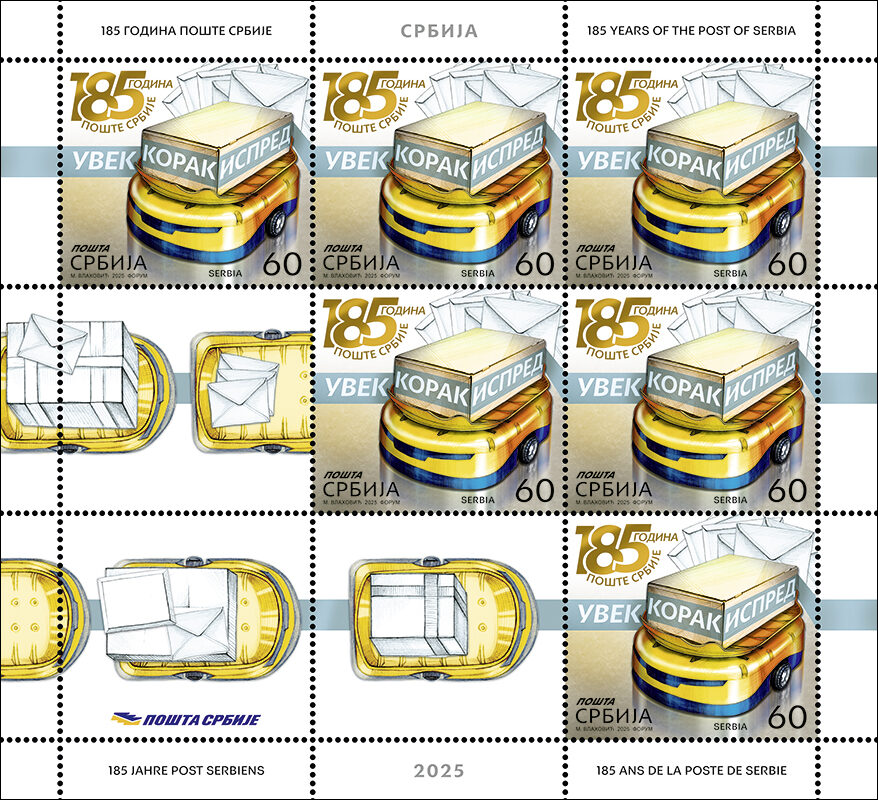
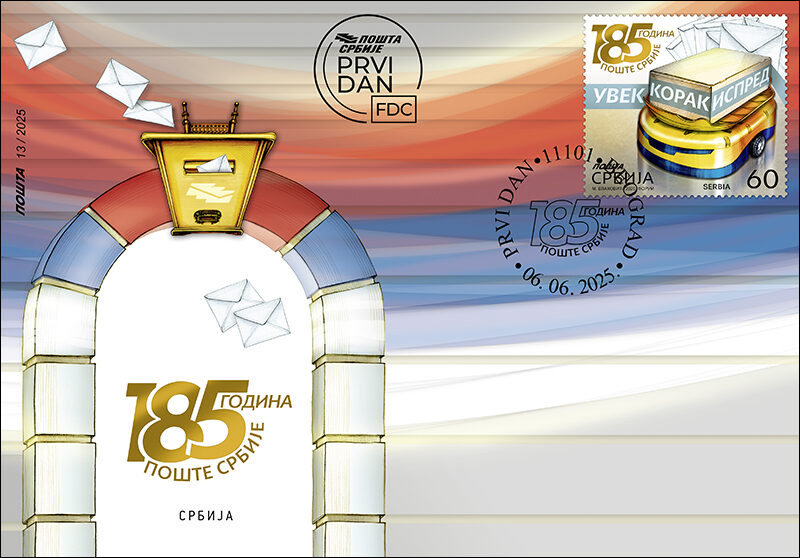
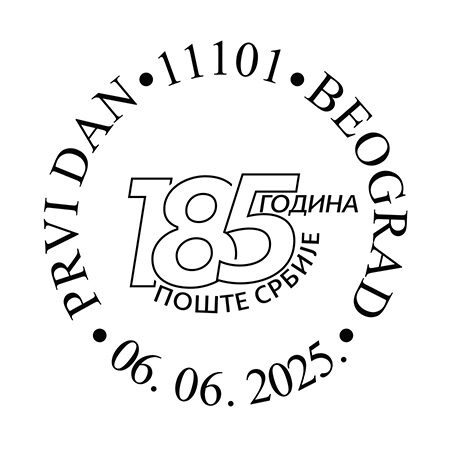
Established back in 1840, the Post of Serbia was one of the first corporate institutions in Serbia in the nineteenth century, a pioneer of the modernization and industrialization of Serbia, but also a strong factor in the political independence of the emerging state.
The traffic connection of cities, the opening of post offices, the modernization of postal traffic by introducing postage stamps, legal organization, and the education of postal personnel, made the Post one of the leaders of technological progress. Through numerous interstate activities and participation in the creation of the Universal Postal Union, the Post of Serbia became one of the first internationally recognized institutions of the young Serbian state.
Telegraph, telephone, automobile, railway, river and later air postal traffic, the opening of wireless stations and the broadcasting of the first radio program, brought Serbia into the ranks of technologically developed countries when it comes to postal traffic, significantly influencing the overall economic growth and development of the country in the first half of the 20th century.
New services, automation and modernization of postal traffic and intensive development of the postal information system in the second half of the 20th century, as well as the introduction of mobile telephony and the development of the geographic information system, have enabled the Post of Serbia to enter the 21st century as a company the strategic interest of which is sustainable development, economic and technological progress through the robotization of the postal industry and the implementation of green technologies.
Throughout its 185 years of existence, maintained and improved through the hard work and effort of numerous generations of employees, the Post of Serbia has always been a significant factor in the development of Serbia, providing, through its technological development, improvement of vocational education and through numerous socially engaged and humanitarian activities, the necessary social support for the overall prosperity of our society.
Professional cooperation: PTT Museum
Artistic realisation of the issue: MA Marija Vlahovic, academic graphic artist
Technical details
Date of issue: 06. 06. 2025.
Number of stamps in set: 1
Denomination:
1386: 60.00 RSD
Printrun: 25.000
FDC: 1
Sheet of: 6
Dimensions of stamp: 42 x 37,7 mm
Artistic realization: Marija Vlahović, Academic Graphic Artist
Subject: 185 years of the Post of Serbia
1386: Robotization of the postal industry
Perforations: 13 3/4
Printer: Forum Novi Sad
Protected animal species
75 years of the Palić Zoo
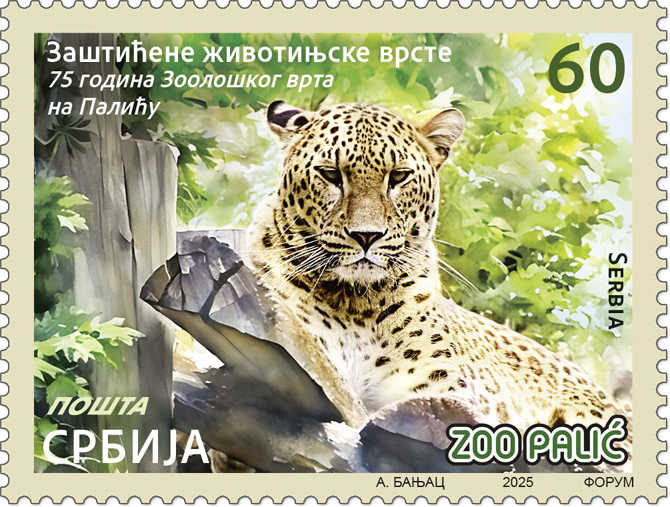
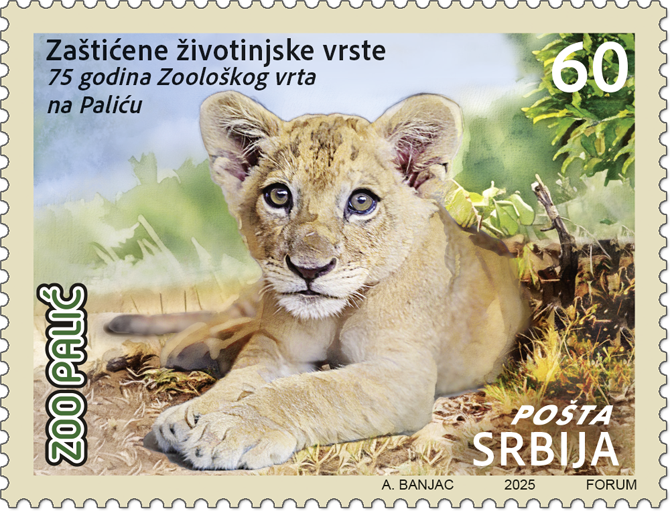
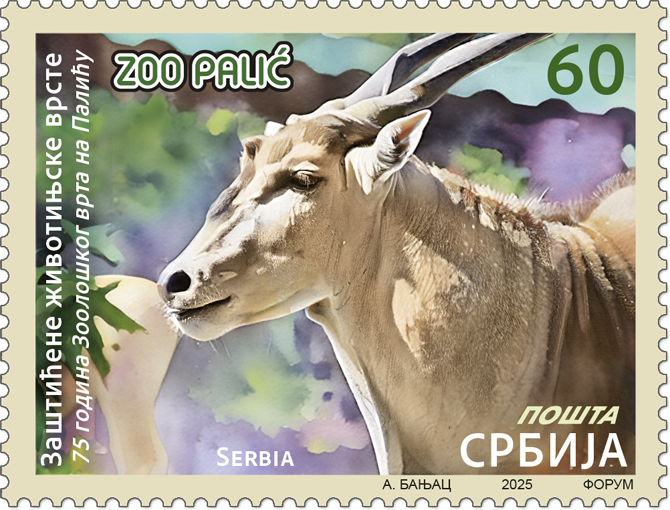
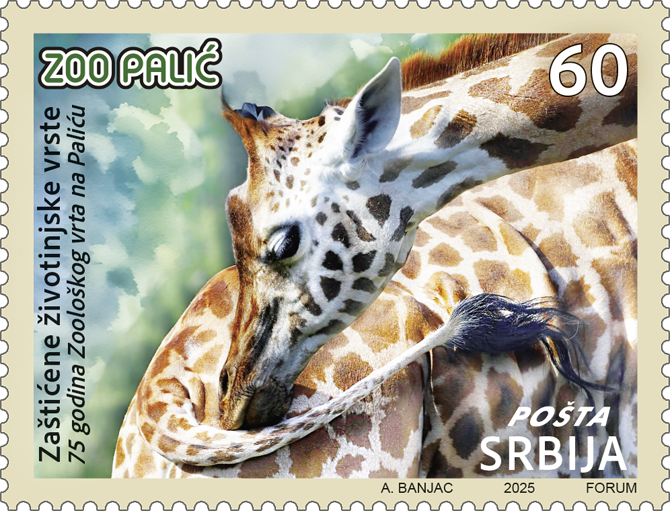
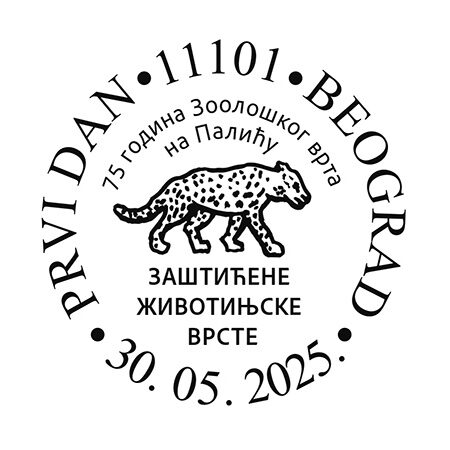


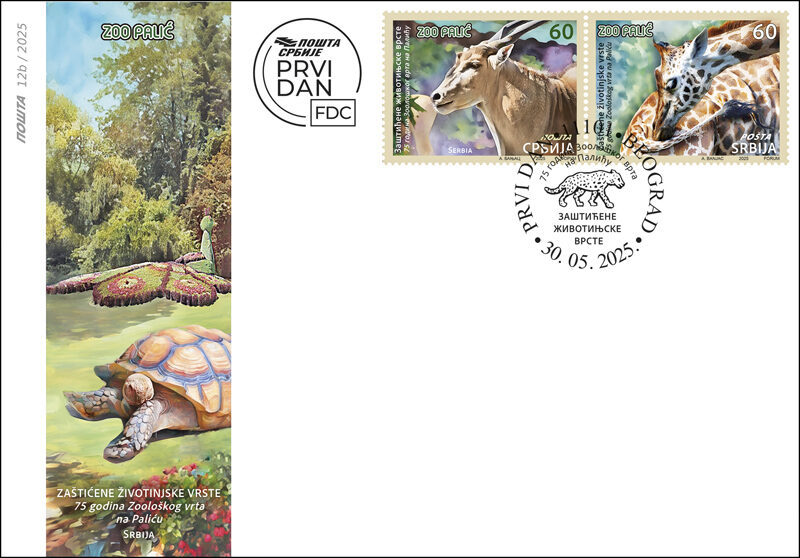
The Palić Zoo, founded as a cultural institution on May 31, 1950 by the city of Subotica, is located in a protected nature area. The first inhabitants of this zoo were a bear and a griffon vulture, and among the exotic animals, a monkey and a cockatoo parrot. Initially, the Palić Zoo occupied two hectares of space, and today it extends to 15 hectares, within which there are 70 aviaries, woven into the natural environment of the botanical garden. In this arranged oasis of nature, visitors can see and get to know autochthonous and exotic plant and animal species that they cannot see in their natural habitat.
The Palić Zoo is currently home to around 150 animal species, while the botanical garden has over 300 species of dendromaterial. There is a collection of many protected and strictly protected species in the Republic of Serbia, such as the griffon vulture, brown bear, grey wolf, common buzzard, great eagle-owl, white and black storks, white-tailed eagles, hedgehogs and moles. Among the plant species, visitors can see the Pančić spruce, yew, Bosnian and Macedonian pines (Pinus heldreichii and Pinus peuce), as well as ginkgo and giant sequoia.
With numerous activities in the fields of zoology, botany, protection of endangered species, but also education, culture and tourism, the Palić Zoo fulfils its mission – the preservation of wild animals and their natural habitats, in an environment that is pleasant and enjoyable for visitors as well. The educational programme for elementary school students of the city of Subotica is particularly noteworthy, as 18,000 children visit the Palić Zoo annually. The Palić Zoo is celebrating its great anniversary – 75 years of its establishment – as the largest zoo in the Republic of Serbia.
Professional cooperation: Jelena Toljagić, Museum Educator, Coordinator of Educational and Promotional Activities, Palić Zoo
Artistic realization: Anamari Banjac, Academic Painter
Technical details
Date of issue: 30. 05. 2025.
Number of stamps in set: 4
Denomination:
1382: 60.00 RSD
1383: 60.00 RSD
1384: 60.00 RSD
1385: 60.00 RSD
Printrun: 15.000
FDC: 2
Sheet of: 20
Dimensions of stamp: 42 x 31,9 mm
Artistic realization: Anamari Banjac
Subject: Protected animal species - 75 years of the Palić Zoo
1382: 75 years of the Palić Zoo - leopard
1383: 75 years of the Palić Zoo - lion cub
1384: 75 years of the Palić Zoo - antelope
1385: 75 years of the Palić Zoo - giraffe
Perforations: 13 3/4
Printer: Forum Novi Sad
STAMP DAY
125th anniversary of the birth of the doyen of Serbian philately, Siniša Ostojić
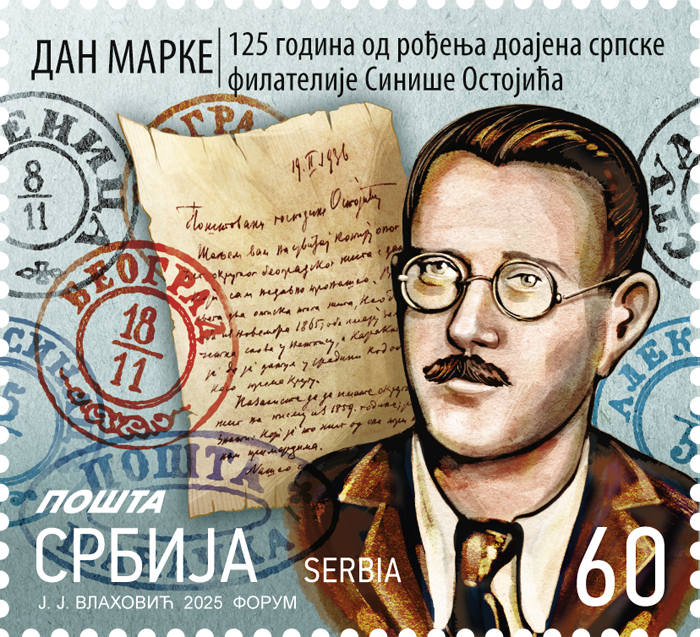
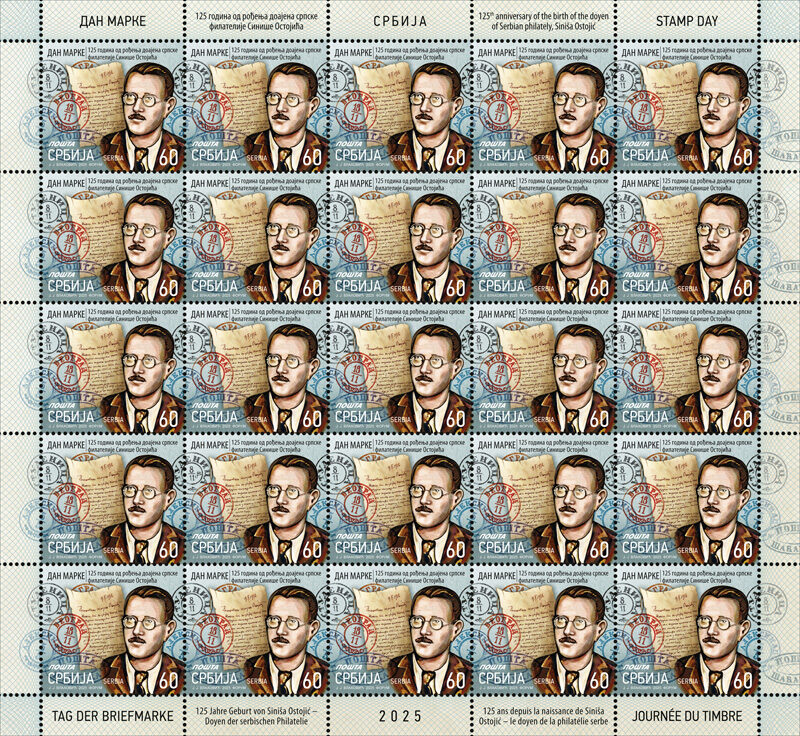
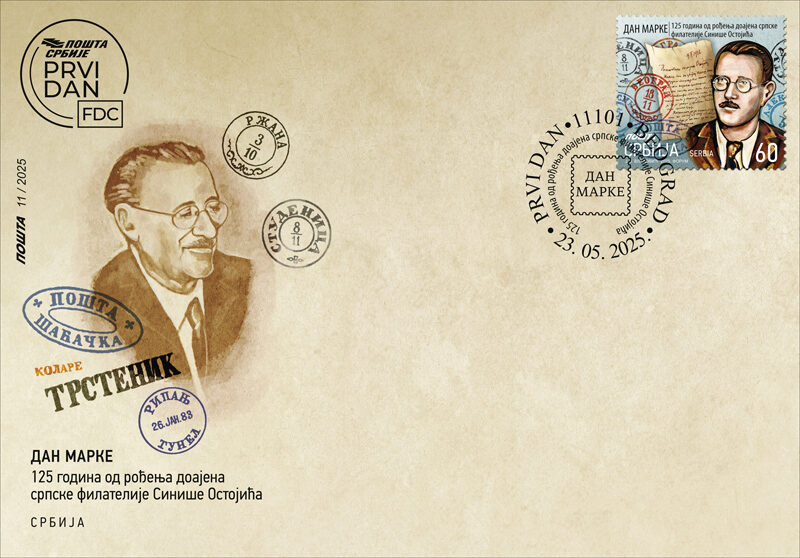
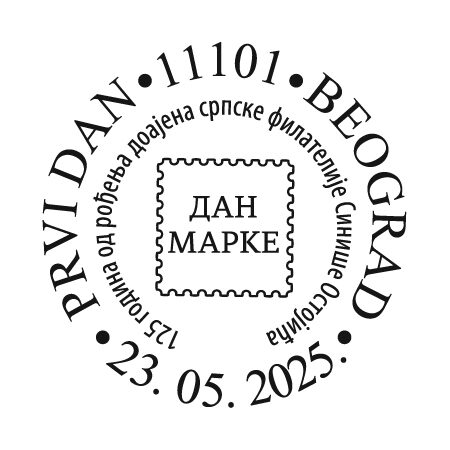
Siniša Ostojić (1900–1974), the doyen of Serbian philately, was born in Belgrade in 1900, where he completed his elementary and secondary education, and graduated from the Faculty of Law in Prague. He spent his working life in the administration of the Belgrade municipality of Stari Grad.
He belonged to the circle of the greatest connoisseurs of Serbian philately of his time, researching, analysing and discussing issues from Serbian postal history with Evžen Deroko. He built the status of an undisputed authority through active work that went beyond the ordinary collection of postage stamps and seals, and through their systematization, he laid the foundations for the scholarly study of the postal history of Serbia in the broadest possible sense.
His research included, above all, a serious reconstruction of the development of the Post of Serbia from the first seals in 1840 and the processing of the first Serbian postage stamps, with a special focus on newspaper stamps. The magazine FILATELISTA, in which these studies were published in sequels, had a valuable and loyal collaborator in Siniša Ostojić. Without his contribution, Serbian philately would not be anywhere near what it is today.
He also played an important role in organized philately as the president of the Evžen Deroko Philatelic Society, and was also a founder and long-time board member of the Union of Philatelists of Serbia and a board member of the Union of Philatelists of Yugoslavia. He was also active in exhibition philately, participating in national and international philatelic exhibitions.
With his comprehensive work and activities, he left a permanent mark on Serbian philately for generations of philatelists to come.
Motifs on the stamp: Siniša Ostojić; a letter sent by Evžen Deroko to Siniša Ostojić, in which they systematize the seals of Serbian post offices from 1840 to 1915; some of the rare seals from Ostojić's collection.
Motif on the envelope: Siniša Ostojić and some of the rare seals from his collection.
Professional cooperation: Vladimir Milić, President of the Union of Philatelists of Serbia
Artistic realization of the issue: MA Jakša Vlahović, academic graphic artist
Technical details
Date of issue: 23. 05. 2025.
Number of stamps in set: 1
Denomination:
1381: 60.00 RSD
Printrun: 25.000
FDC: 1
Sheet of: 25
Dimensions of stamp: 35 x 31,9 mm
Artistic realization: Jakša Vlahović
Subject: Stamp Day
1381: Siniša Ostojić; a letter sent by Evžen Deroko to Siniša Ostojić, in which they systematize the seals of Serbian post offices from 1840 to 1915; some of the rare seals from Ostojić's collection. Perforations: 13 3/4 Printer: Forum Novi Sad
Victory Day in World War II
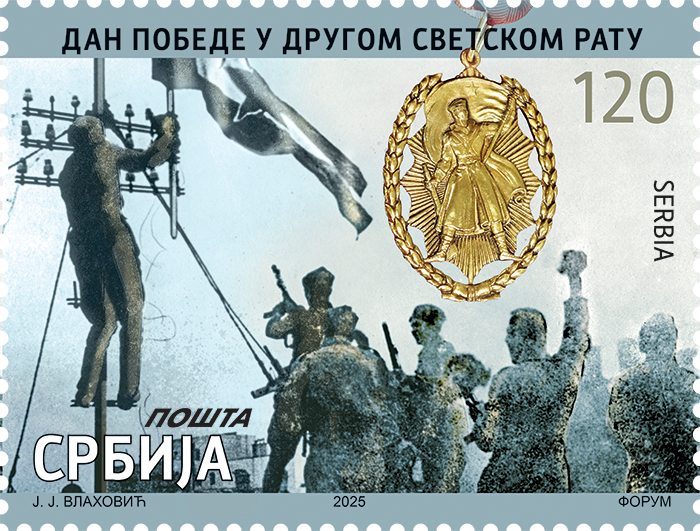
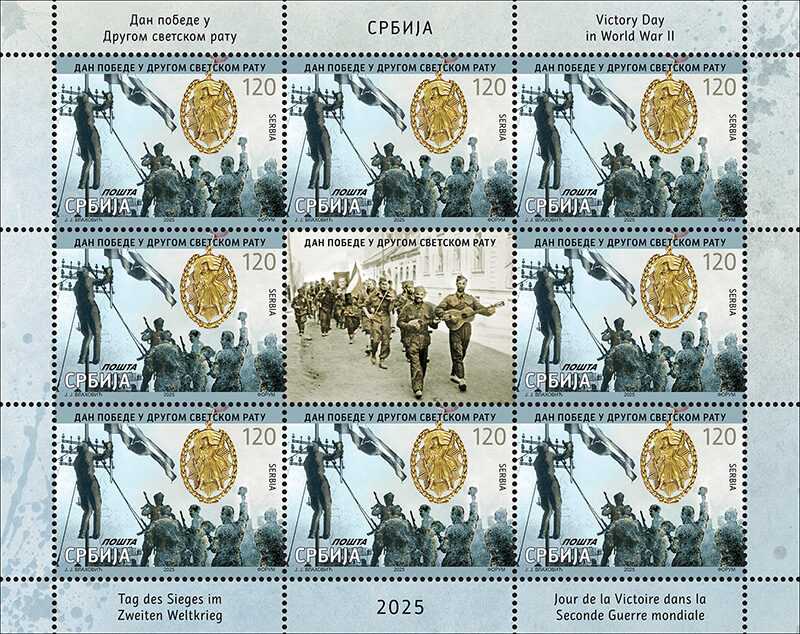

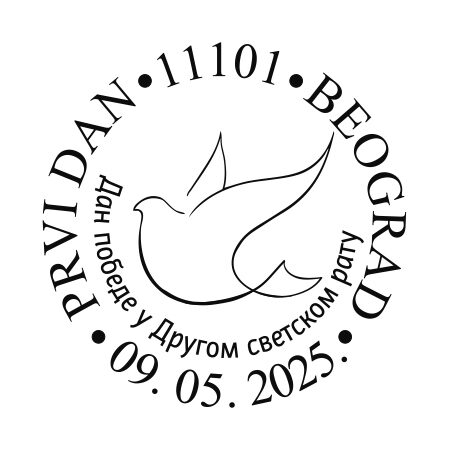
Victory Day is celebrated on May 9 and represents one of the most significant dates in the history of the 20th century – the end of World War II in Europe and the victory over fascism. This day marks the unconditional surrender of Nazi Germany, which ended six years of war suffering and destruction in Europe that led to the deaths of millions of people.
During World War II, Serbia was under occupation, which led to enormous civilian casualties, as well as armed resistance and struggle against the occupiers. Victory Day also marked a new chapter in our history – the creation of a new state, in which social justice and equality were the basic principles.
Victory Day is celebrated in many European countries as one of the most important holidays. Parades are organized in many cities, the most significant of which is the Victory Parade on Red Square in Moscow, which is held every year, reminding humanity of the courage and sacrifices of the many peoples in the fight against fascism.
Stamp motif: photo Partisans raising the flag at the Albania Palace, Belgrade, October 20, 1944 (Military Museum) and the Order of the People’s Hero, which was the highest decoration for bravery awarded in the SFRY and later in the FRY, in the period from 1943 to 2006. It was awarded to individuals who particularly stood out for their courage and heroism during the People’s Liberation War (NOR), but also to units, organizations and cities, as well as foreign citizens. On the vignette: The 6th Krajina Brigade enters its first garrison in liberated Užice, June 1945. On the envelope: Belgraders greet their liberators, fighters of the NOVJ (People’s Liberation Army of Yugoslavia) and the Red Army, Vuk Monument, October 20, 1944 (Military Museum).
Professional cooperation: Ministry of Defence – Human Resources Sector, Department for Tradition, Standard and Veterans and the Military Museum.
Artistic realization of the issue: MA Jakša Vlahović, academic graphic artist
Technical details
Date of issue: 09. 05. 2025.
Number of stamps in set: 1
Denomination:
1380: 120.00 RSD
Printrun: 15.000
FDC: 1
Sheet of: 8
Dimensions of stamp: 42 x 31,5 mm
Artistic realization: Jakša Vlahović
Subject: Victory Day in World War II
1380: Partisans raising the flag at the Albania Palace, Belgrade, October 20, 1944
Perforations: 13 3/4
Printer: Forum Novi Sad
EUROPA
National Archaeological Discoveries

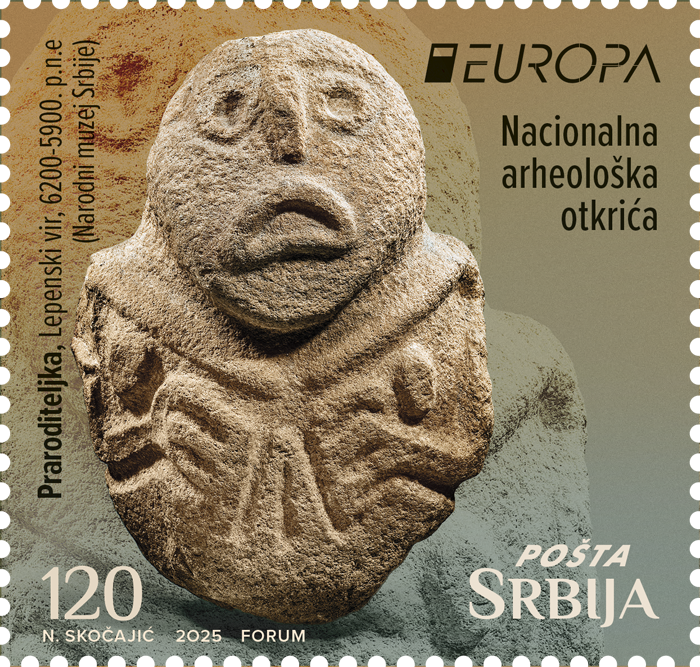
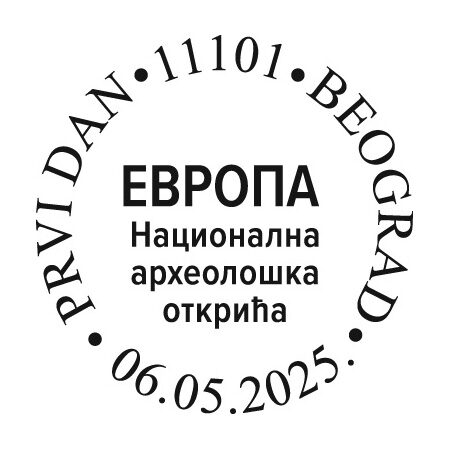
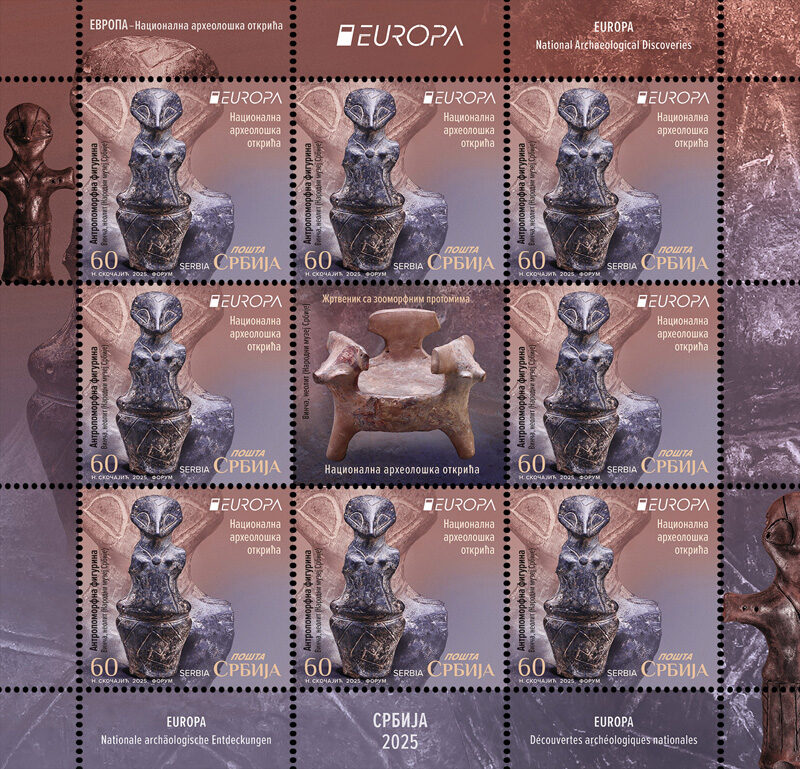
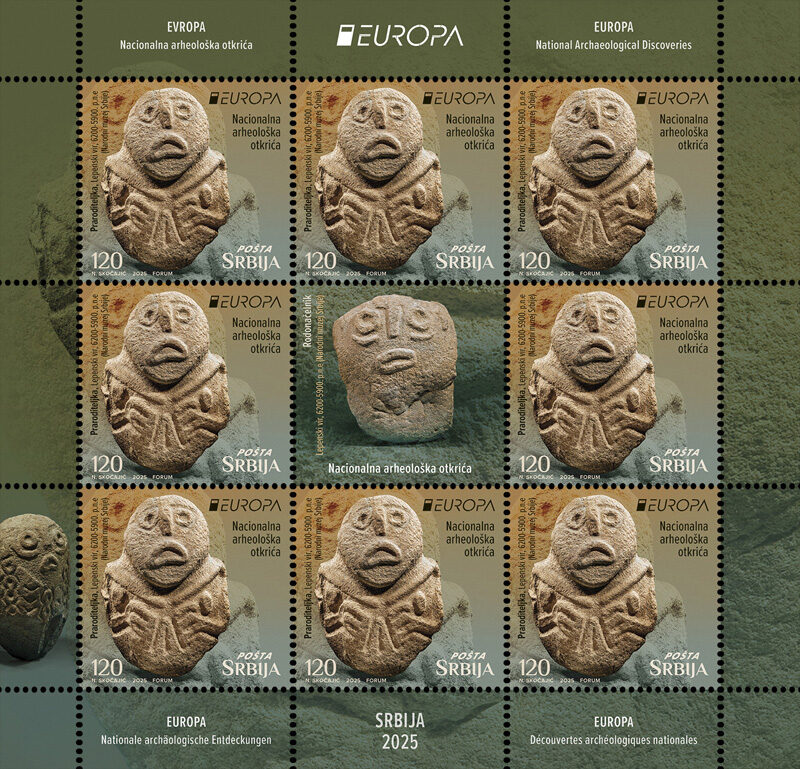
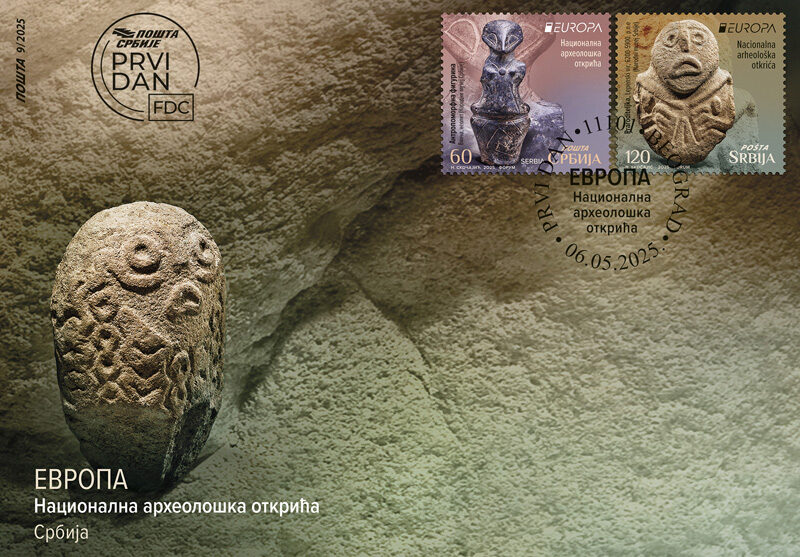
The most significant prehistoric archaeological sites in Serbia – Lepenski Vir and Vinča, represent important evidence of the life of the first human communities in the Balkans.
At the site of Belo Brdo in Vinča, near Belgrade, the first archaeological research was carried out in 1908, organized by the National Museum of Serbia, under the leadership of Professor Miloje Vasić. This is considered the first systematic archaeological research in Serbia and it has continued, with interruptions, to this day, under the leadership of various institutions. Evidence of human presence from prehistoric times to the modern era has been found on Belo Brdo, which formed an artificial hill about 10.5m high. The remains from the Late Neolithic period, which make up its largest segment, formed by the layering of settlements by generations of Late Neolithic inhabitants, belong to the period 5300–4600 BC. Based on the objects found (pottery, artefacts made of stone, bones and horns, anthropomorphic and zoomorphic figurines, prosopomorphic lids, altars, pieces of malachite and cinnabar, decorative objects, jewellery, etc.) as well as the remains of houses, the Vinča culture has been defined – the most significant phenomenon of the late Neolithic and Eneolithic, which developed throughout the territory of the central Balkans, and was named after this site.
Motifs from the Vinča site (Neolithic) on a sheet of 60 RSD denomination: on the stamp – Anthropomorphic figurine (15x6.5cm); on the vignette – Altar with zoomorphic protomes (8.5x11cm).
The Lepenski Vir site in the village of Boljetin, on the banks of the Danube, is one of the most significant and well-known early prehistoric sites in Serbia. The site was investigated between 1965 and 1970 under the leadership of Dragoslav Srejović. During the research of the Mesolithic layers dating back to 6200–5900 BC, the remains of planned settlements were found, with the remains of trapezoidal-shaped dwellings with floors made of limestone plaster, monumental stone sculptures and numerous graves indicating developed burial rituals.
Never before seen, monumental sculptures made of local sandstone, represent a unique artistic phenomenon in early European prehistory. The figural sculptures represent hybrid human-fish-like creatures, while the ornamental sculptures are decorated with wavy and meandering motifs reminiscent of the waters of the Danube. All this indicates that the inhabitants of Lepenski Vir practiced a belief system that was tied to the river.
Motifs from the Lepenski Vir site on a sheet of 120 RSD denomination, sculptures made of quartz sandstone (Mesolithic): on the stamp – Foremother (36x26x48cm, 38.5kg); on the vignette – Progenitor (40x25x53cm, 55kg); on the FDC – Water Fairy (27x19x39cm, 23.1kg).
Professional cooperation and material for motifs: National Museum of Serbia
Artistic realization of the issue: MA Nadežda Skočajić, Academic Graphic Artist
Technical details
Date of issue: 06. 05. 2025.
Number of stamps in set: 2
Denomination:
1378: 60.00 RSD
1379: 120.00 RSD
Printrun: 15.000
FDC: 1
Sheet of: 8
Dimensions of stamp: 35 x 33,4 mm
Artistic realization: Nadežda Skočajić
Subject: EUROPA – National Archaeological Discoveries
1378: Anthropomorphic figurine, motif from the Vinča site (Neolithic)
1379: Foremother, sculpture made of quartz sandstone (Mesolithic), motif from the Lepenski Vir site
Perforations: 13 3/4
Printer: Forum Novi Sad
SERBIA – RUSSIA
100 years since the first performance of Tchaikovsky’s ballet “Swan Lake” in Belgrade
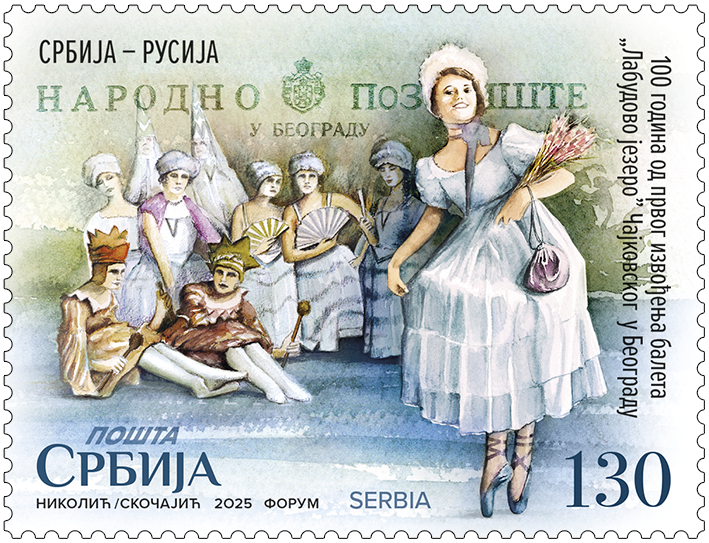
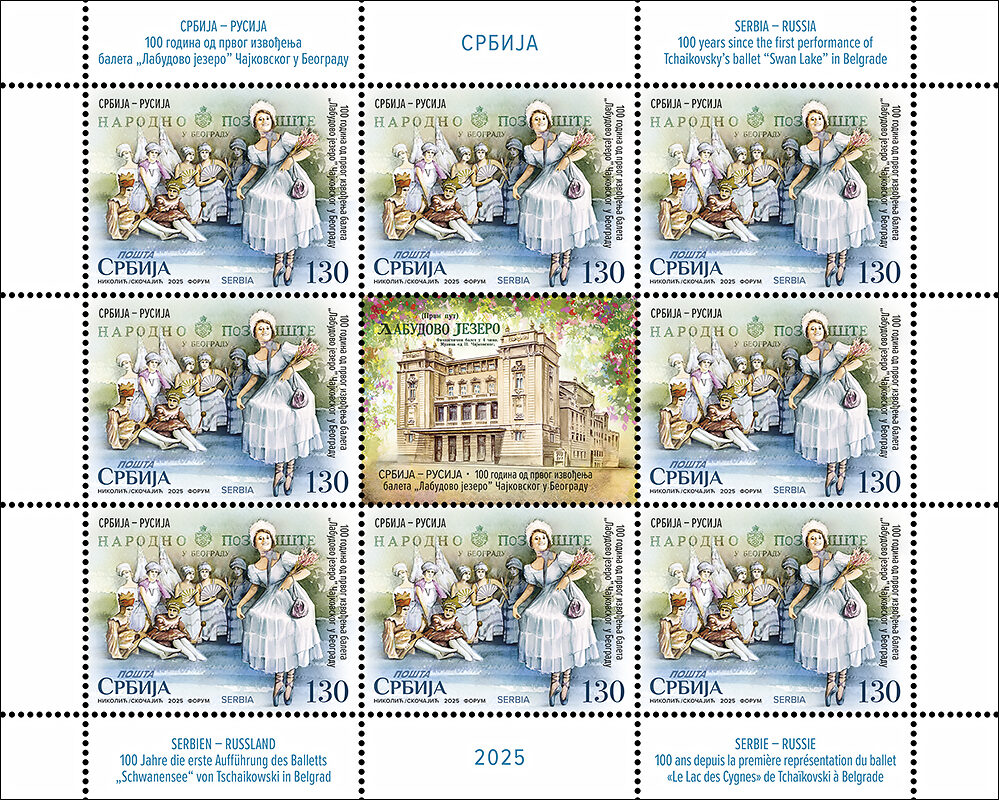
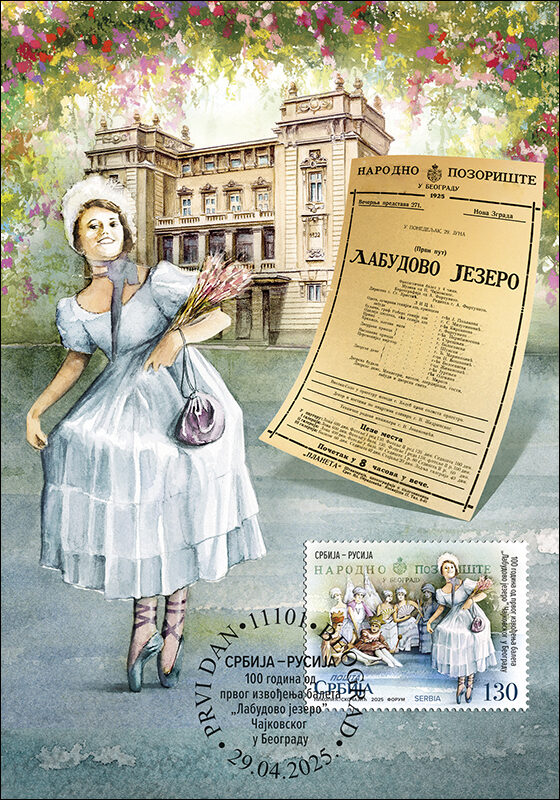
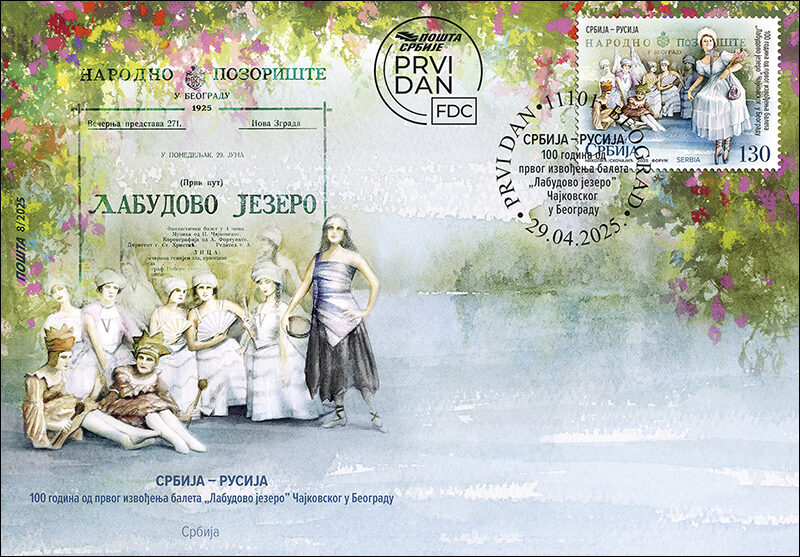
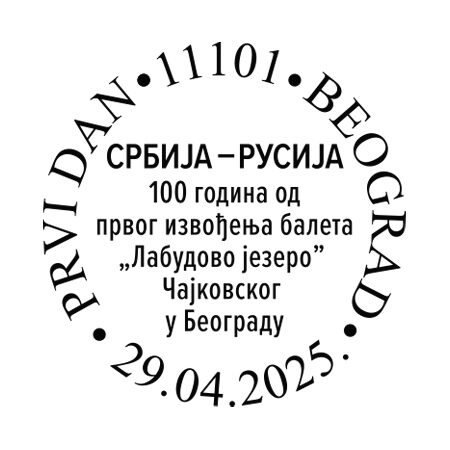
After World War I, Belgrade became the cultural centre of the newly formed Kingdom of Serbs, Croats, and Slovenes, and ballet, although a novelty for the Belgrade and Serbian audience, gradually became an important part of cultural life. The first professional ballet troupe in our country was established in 1920 at the National Theatre in Belgrade. Russian ballet artists who, in the first decade of their stay in Belgrade, formed the backbone of the National Theatre ballet significantly influenced the development of ballet. By bringing elements of the Russian ballet school, they gave local ballet artists the opportunity to learn from the most famous masters of the time. Ballet first began with dances in the opera, and already in 1923, Miloje Milojević's domestic ballet, the grotesque The Valet’s Broom, was performed at the ball in Kasina.
At the time of the first performance of the ballet Swan Lake by Pyotr Ilyich Tchaikovsky in Belgrade, the ballet ensemble of the National Theatre had two prima ballerinas, two principal male dancers, twenty-four female and seven male dancers. It was staged by Alexander Fortunato, as choreographer and director, composer Stevan Hristić conducted the orchestra, Vladimir Zedrinski was the set and costume painter, and it premiered on June 29, 1925. The role of Odette was entrusted to the Russian ballerina Elena Poliakova; Nina Kirsanova played the role of Odile; the role of the Prince was played by Alexander Fortunato, while the ballerina Nataša Bošković played the Court Lady. The ballet received favourable reviews in the press, which, reporting on the premiere, assessed it as a success, writing highly about the dancers and the ensemble. Nataša Bošković's performance was met with undivided praise from the professional public, who wrote of her performance that it was "filled with lightness, cheerfulness, and ecstatic enthusiasm."
With its first performance in Belgrade in 1925, the ballet Swan Lake practically marked the beginning of a more intense interest in classical ballet in Belgrade and the Balkans. With numerous subsequent performances on the stage of the National Theatre, up to the present day, with the participation of artists from the National Theatre, but also guests from other countries, this ballet has become one of the symbols of ballet art.
Professional cooperation: Slobodan Mandić, Archival Advisor, Historical Archives of Belgrade.
Artistic realization: Miroslav Nikolić and Nadežda Skočajić, Academic Graphic Artist.
Technical details
Date of issue: 29. 04. 2025.
Number of stamps in set: 1
Denomination:
1377: 130.00 RSD
Printrun: 15.000
FDC: 1
MC: 1
Sheet of: 8
Dimensions of stamp: 42 x 31,9 mm
Artistic realization: Miroslav Nikolić and Nadežda Skočajić
Subject: SERBIA – RUSSIA: 100 years since the first performance of Tchaikovsky’s ballet “Swan Lake” in Belgrade
1377: The very first performance of the ballet Swan Lake by Pyotr Ilyich Tchaikovsky in Belgrade.
Perforations: 13 3/4
Printer: Forum Novi Sad
Breakthrough of prisoners from the death camp in Jasenovac
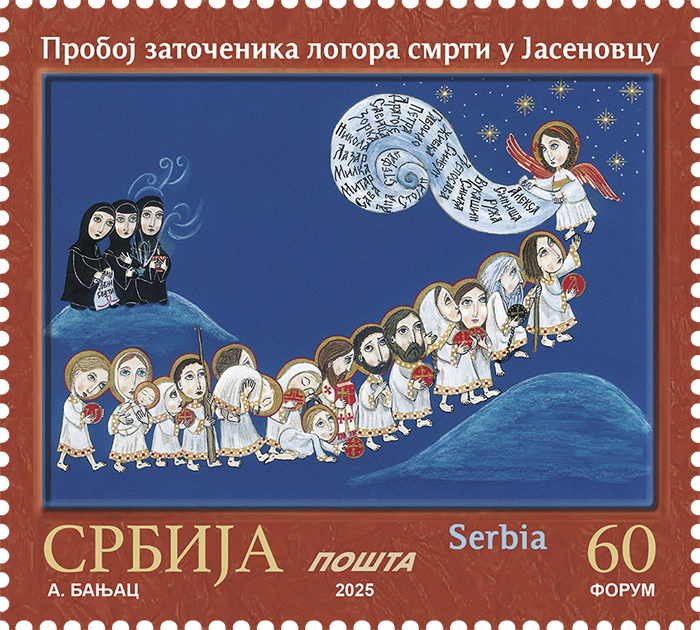

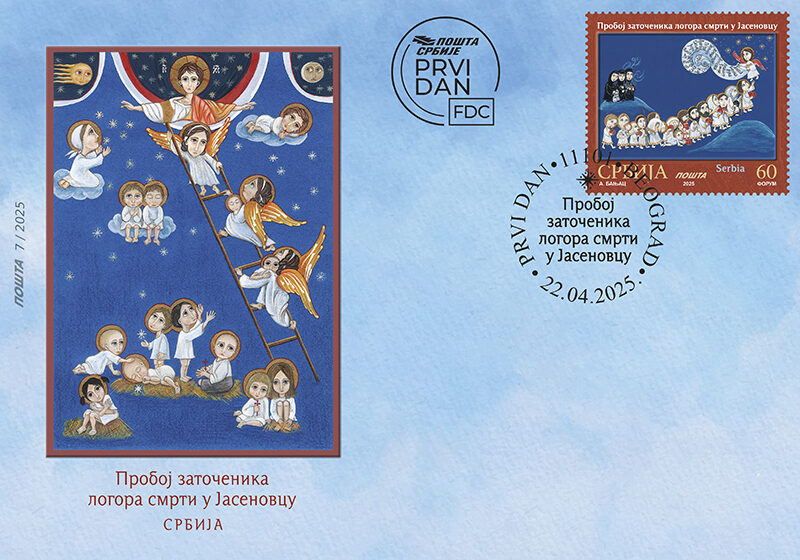
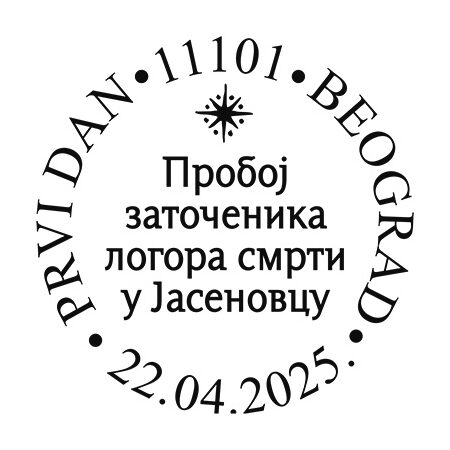
The system of concentration and death camps in Jasenovac represents the most shocking paradigm of Serbian suffering during World War II (1941-1945). The genocidal policy of the Independent State of Croatia directed against the Serbian, Jewish and Roma people manifested itself in its most tragic form at the most massive execution ground of the occupied Kingdom of Yugoslavia. During the 1337 days of the death camp’s existence, crimes were recorded that remain unfathomable to the human mind even to this day.
April 22, 1945 is the day when the last Jasenovac prisoners stormed to freedom. In the last days of the Jasenovac camp, a group of inmates was formed under the leadership of Ante Bakotić who, in secret, on the night between April 21 and 22, devised a breakout plan. On Sunday, April 22, 1945, at 10 am, at Bakotić’s signal, the inmates broke through the doors and windows of the barracks and surprised the camp guards. About six hundred desperate people rushed through the cleared space towards the southeastern gate, suffering significant losses from the guards who were firing at them from machine gun nests. In the chaotic circumstances Mile Ristić, one of the inmates, managed to seize a machine gun and return fire, thus providing protection for the participants in the breakout.
The survivors, having made their way through the southeast gate, headed for the forests where they found refuge and freedom.
Motifs on the stamp, vignette and envelope: Holy New Martyrs of Jasenovac, the work of the nun Marija, depicted with the consent of the His Grace Bishop Jovan of Pakrac and Slavonia.
Professional cooperation: Museum of Genocide Victims and the Diocese of Pakrac and Slavonia, Serbian Orthodox Church.
Graphic realization: MA Anamari Banjac, Academic Painter
Technical details
Date of issue: 22. 04. 2025.
Number of stamps in set: 1
Denomination:
1376: 60.00 RSD
Printrun: 25.000
FDC: 1
Sheet of: 8
Dimensions of stamp: 42 x 37,7 mm
Artistic realization: Anamari Banjac
Subject: Breakthrough of prisoners from the death camp in Jasenovac
1376: Holy New Martyrs of Jasenovac, the work of the nun Marija
Perforations: 13 ¾
Printer: Forum Novi Sad
180 years of the Serbian Reading Room “Laza Kostić”, Sombor
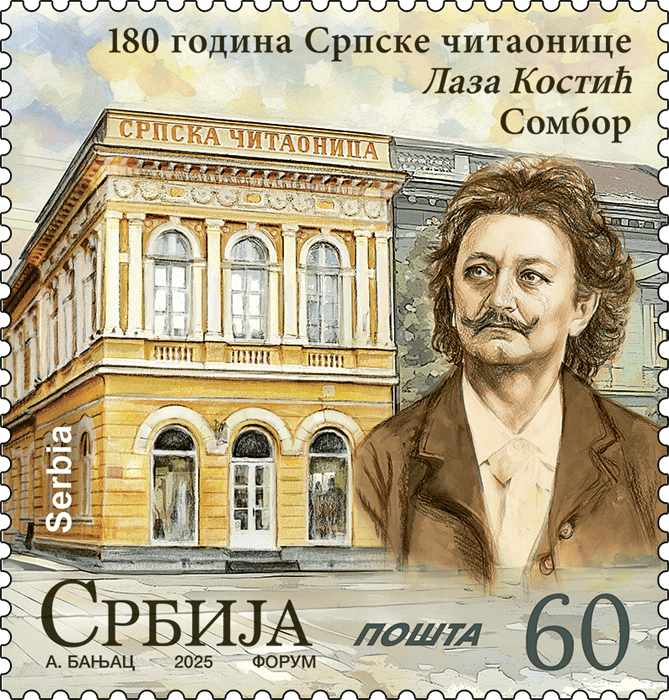
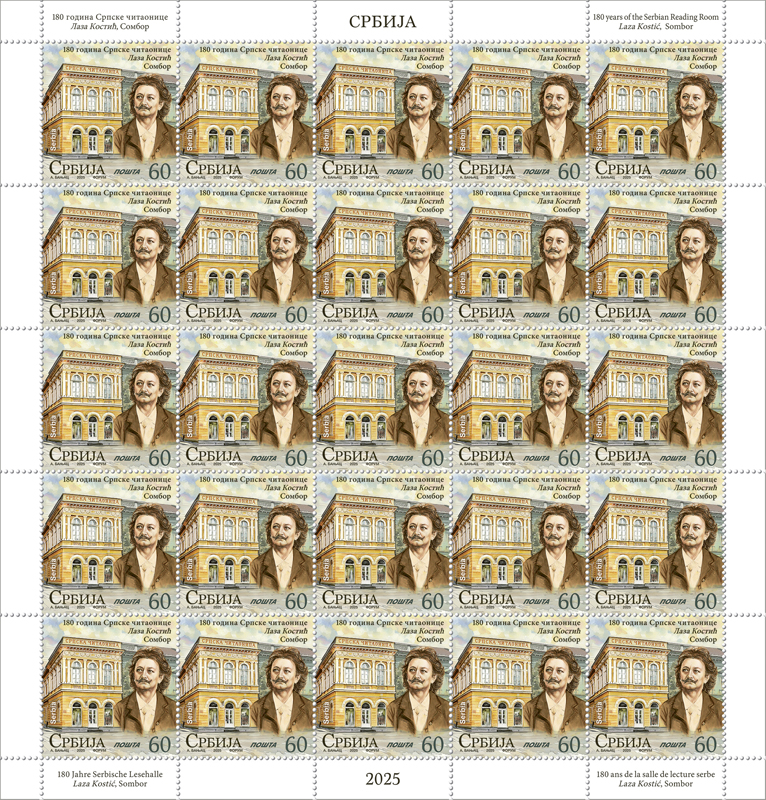
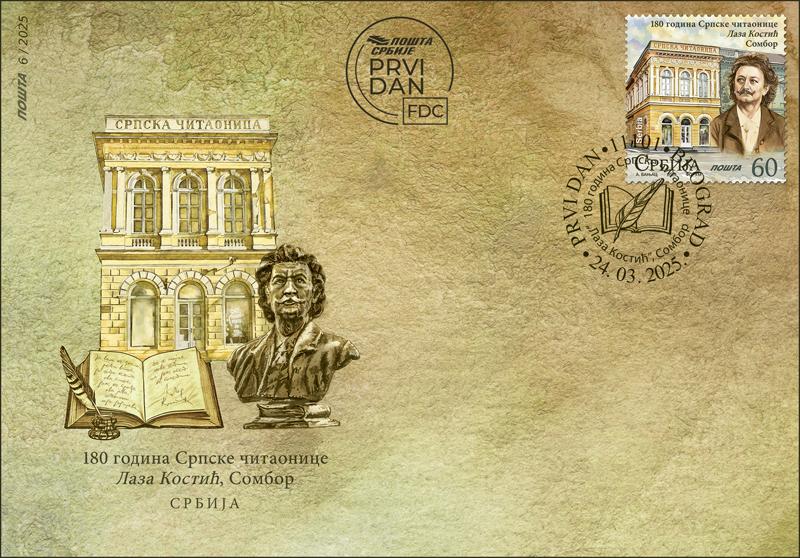
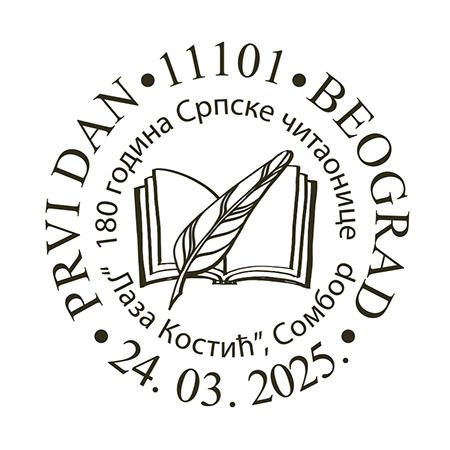
One of the oldest cultural institutions of the Serbian people that still exists today, the Serbian Reading Room “Laza Kostić” in Sombor, was founded on March 24, 1845. At the beginning, it had 72 founding members, and its first president was the Sombor parish priest Avram Maksimović. In the first decades of its existence, the Serbian Reading Room did not have its own building, but with the participation of the members of the Reading Room, voluntary contributions from Sombor Serbs and the help of the Orthodox Church Municipality in Sombor, a specific-purpose building was erected in 1882, today a building of exceptional cultural and historical significance for the city of Sombor and the Serbian people in general. In the period from 1901 to 1910, the president of the Serbian Reading Room was Laza Kostić, and after his death this institution bore his name. In 1908, the Constitution of the Sombor Serbian Reading Room was printed.
The premises of the Serbian Reading Room are adorned with 21 portraits of famous figures who, in different eras, contributed in various ways to the cultural, educational and spiritual development of the Serbian people. All of the portraits on display were painted and donated to the Reading Room by the painter Sava Stojkov, its honorary president.
After World War II, the Reading Room was stripped of the first part of its name in the new socialist state, so instead of the Serbian Reading Room, as it had been called for 112 years, it started to be called the “Laza Kostić” Reading Room as of 1957.
Today, the Reading Room in Sombor is once again called the Serbian Reading Room “Laza Kostić”, and its programmes, both 180 years ago and now, are closely connected to preserving the educational, cultural and spiritual identity of the Serbian people, nurturing traditions, customs, and the Serbian language and Cyrillic script.
Professional cooperation: Serbian Reading Room “Laza Kostić”, Sombor
Artistic realization of the issue: MA Anamari Banjac, academic painter
Technical details
Date of issue: 24. 03. 2025.
Number of stamps in set: 1
Denomination:
1375: 60.00 RSD
Printrun: 25.000
FDC: 1
Sheet of: 25
Dimensions of stamp: 33,4 x 35 mm
Artistic realization: Anamari Banjac
Subject: 180 years of the Serbian Reading Room “Laza Kostić”, Sombor
1375: Portrait of Laza Kostić and building of the Serbian Reading Room “Laza Kostić” in Sombor
Perforations: 13 3/4
Printer: Forum Novi Sad
EASTER
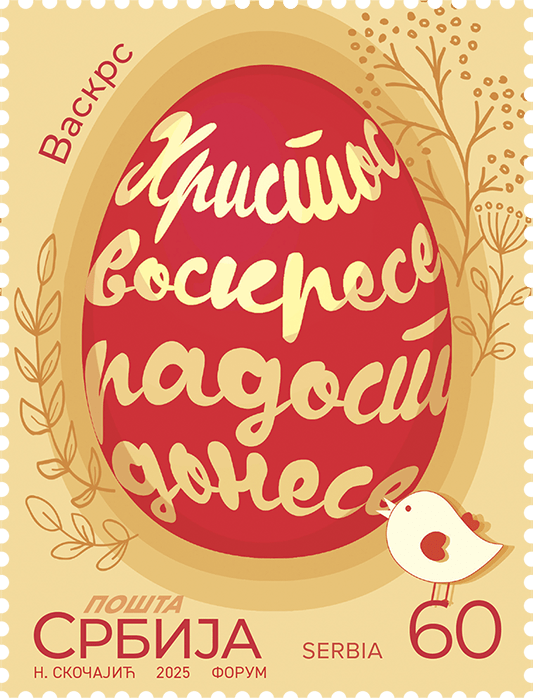
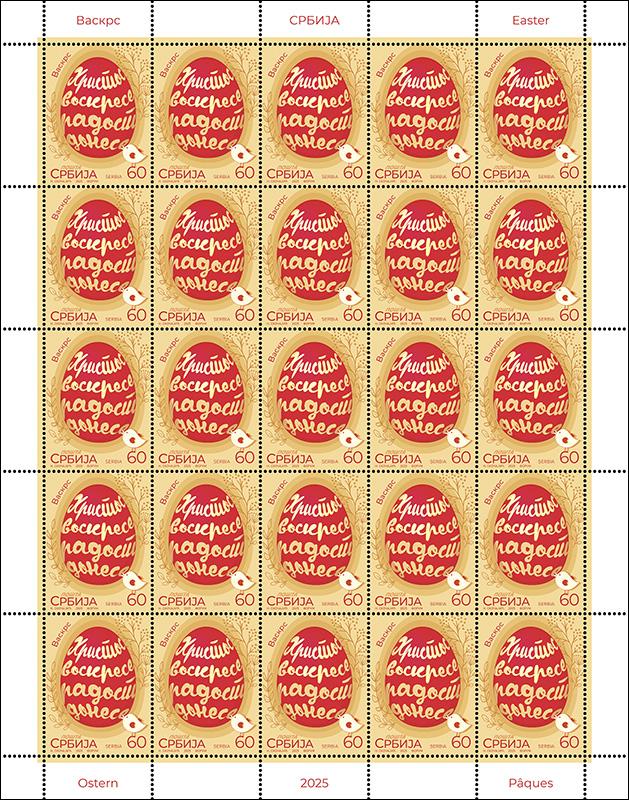
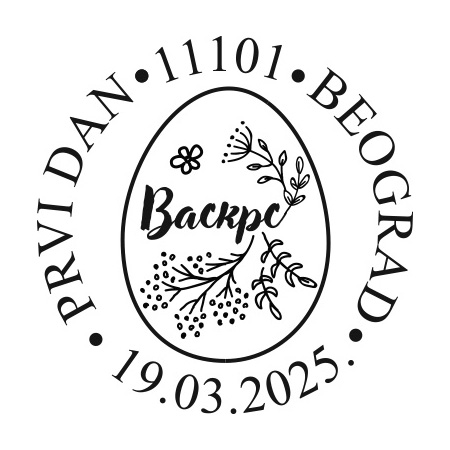
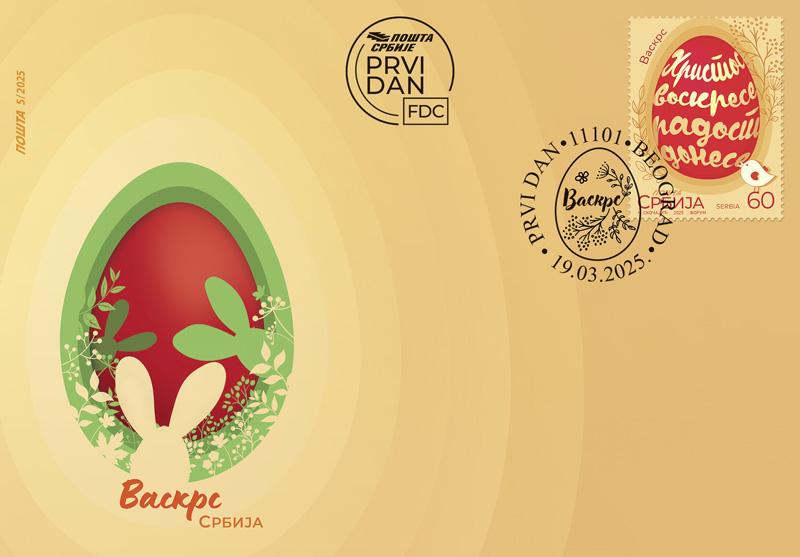
The most important and greatest Christian holiday – the day of eternal joy, the Resurrection of Christ, is celebrated in memory of the day when Christ, the Son of God, defeated death.
Easter is a moving holiday, it is always celebrated on a Sunday, and the date is calculated based on the date of the full moon that preceded Christ´s Resurrection in 30 BC and can fall between 4 April and 8 May according to the Gregorian calendar, or between 22 March and 25 April according to the old Julian calendar. The decision to celebrate the Resurrection of Christ was made at the first Ecumenical Council in Nicaea in 325. The Orthodox Church celebrates Easter according to the Julian calendar.
Easter is preceded by a seven-week fast, and the last week before Easter is called the Great Week. Many folk customs are associated with this week, the most famous of which is the painting of eggs, which are painted on Great Friday. The first egg is painted red, and in many parts of our country this egg is called the “housekeeper” and is kept all year round, to guard the home until the next Easter. Painting and decorating eggs, which are actually a symbol of resurrection, is a custom that children certainly love the most. The Day of Christ’s Resurrection is marked by solemn liturgy in churches, and believers greet each other with the words: “Christ is risen!”, “Truly, He is risen!”
Children especially enjoy the most joyful Christian holiday, because the celebration of Easter is also a day of children’s joy, fun and games. In the past, children would get up early on Easter morning, wash themselves with water in which eggs had been soaked overnight and rub their cheeks with the “housekeeper” so that, according to belief, they would be healthy and rosy. Children spend Easter playing, looking for Easter eggs, gifts, chocolates and sweets hidden around the yard and house and giving each other coloured Easter eggs. Joyful Easter customs and cheerful children’s games are accompanied by appropriate songs, of which the most famous today is the one sung to the verses of Bishop Nikolaj Velimirović – “Christ is risen, and brings the joy!”.
Artistic realization of the issue: MA Nadežda Skočajić, Academic Graphic Artist
Technical details
Date of issue: 19. 03. 2025.
Number of stamps in set: 1
Denomination:
1374: 60.00 RSD
Printrun: 25.000
FDC: 1
Sheet of: 25
Dimensions of stamp: 31,9 x 42 mm
Artistic realization: Nadežda Skočajić
Subject: Easter
1374: Easter symbols
Perforations: 13 3/4
Printer: Forum Novi Sad
MILITARY ACADEMY DAY
175 years since the establishment of military education in Serbia
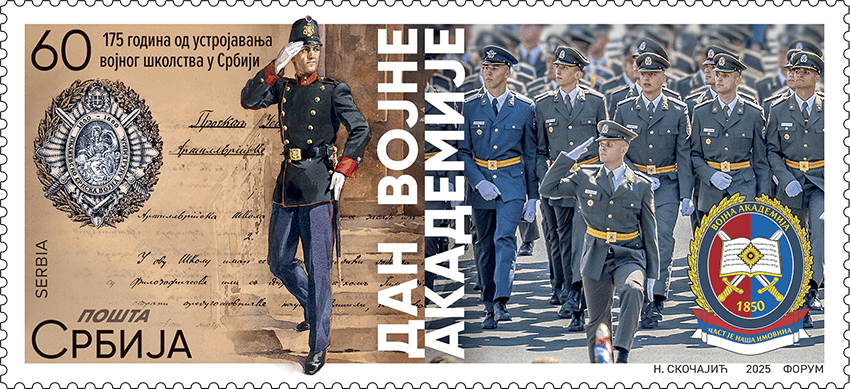
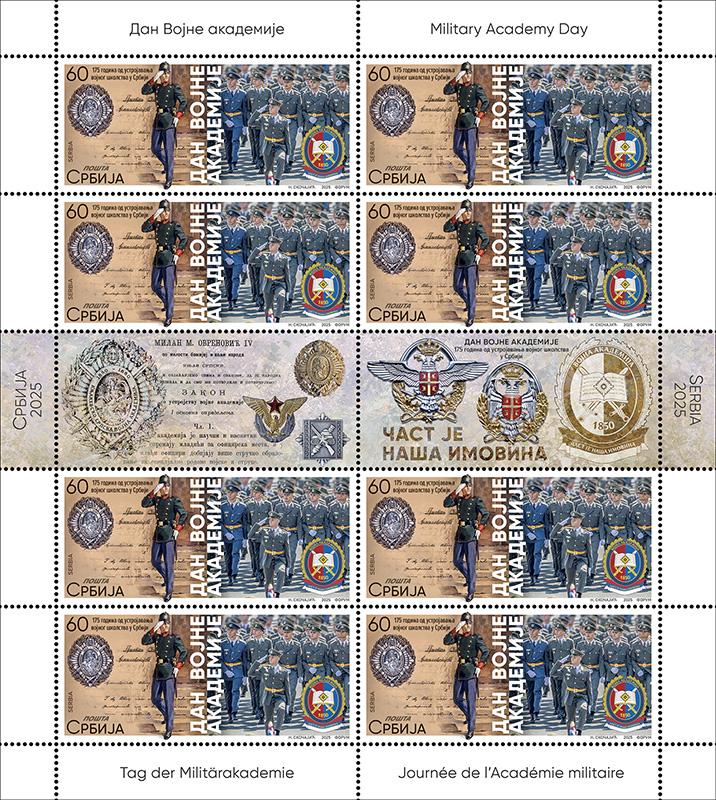
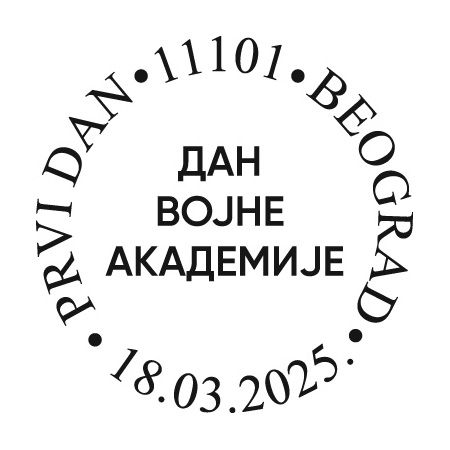
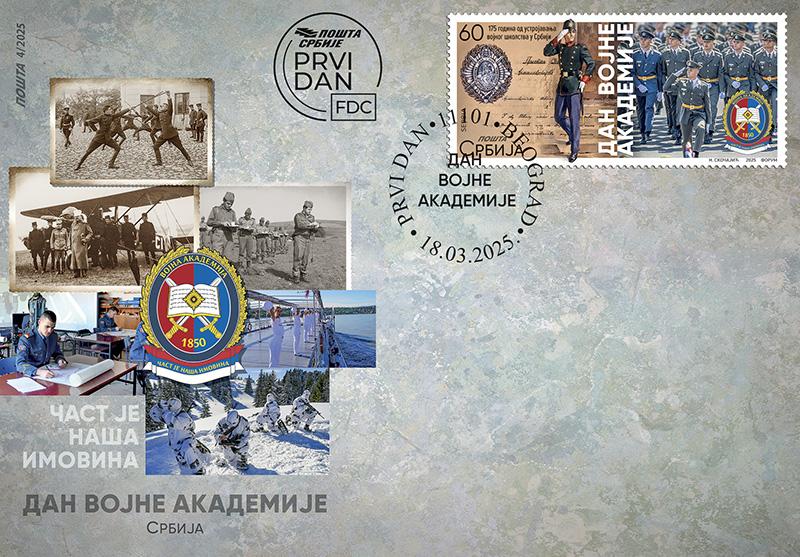
Military Academy Day is celebrated on March 18, commemorating the day when Prince Aleksandar Karađorđević, in 1850, signed the Act on the Establishment of the Artillery School – the first military higher education institution in Serbia, the traditions of which are today preserved by the Military Academy in Belgrade, a higher education and scientific research institution of the Ministry of Defence of the Republic of Serbia.
The Military Academy, which has been educating officer staff for the needs of the Serbian Armed Forces for 175 years, is part of the higher education system of the Republic of Serbia, within which it has accredited study programmes for undergraduate, master's and doctoral academic studies. Education at the Military Academy is a complex process that combines education, military training and upbringing of future officers.
In its long history, the Military Academy has produced a pleiad of top intellectuals and experts, experienced military strategists of unbreakable moral strength, unwavering in the service of their homeland. Many of them were also successful scientists and commanders, military writers and professors, such as Academician Jovan Mišković, General, Minister and Military Reformer; Academician Jovan Dragašević, General, Military Writer and Poet, Professor at the Military Academy and the Great School; Academician Živko Pavlović, General, Commander and Intellectual, a Giant of Serbian military thought.
In the year of anniversary, we also proudly remember all the officers who demonstrated their abilities in the Balkan and World Wars, led by Field Marshals Radomir Putnik, Stepa Stepanović, Živojin Mišić and Petar Bojović.
A significant part of the credit for the defence of the Federal Republic of Yugoslavia from NATO aggression in 1999 belongs to the Military Academy, which educated an excellent staff of officers, and the battles at Košare and Paštrik, full of examples of the extraordinary sacrifice of our officers and soldiers, undoubtedly prove this. Throughout its existence, the Military Academy has provided Serbia with officers trained, ready and capable for their high calling – the defence of the homeland.
Professional cooperation: University of Defence, Military Academy Belgrade
Artistic realization: Nadežda Skočajić, Academic Graphic Artist
Technical details
Date of issue: 18. 03. 2025.
Number of stamps in set: 1
Denomination:
1373: 60.00 RSD
Printrun: 25.000
FDC: 1
Sheet of: 8
Dimensions of stamp: 70 x 31,9 mm
Artistic realization: Nadežda Skočajić
Subject: Military Academy Day - 175 years since the establishment of military education in Serbia
1373: On the left: a detail of the watercolor “The cadet of the Military Academy” from 1861. Sign of the Military Academy (1850-1880). On the right: the ceremonial promotion of new officers of the Serbian Armed Forces, graduates of the Military Academy in Belgrade and the logo of the Military Academy, University of Defense.
Perforations: 13 3/4
Printer: Forum Novi Sad
EUROPEAN NATURE PROTECTION
150 years of rational beekeeping in Serbia
150 years since the discovery of the Serbian spruce
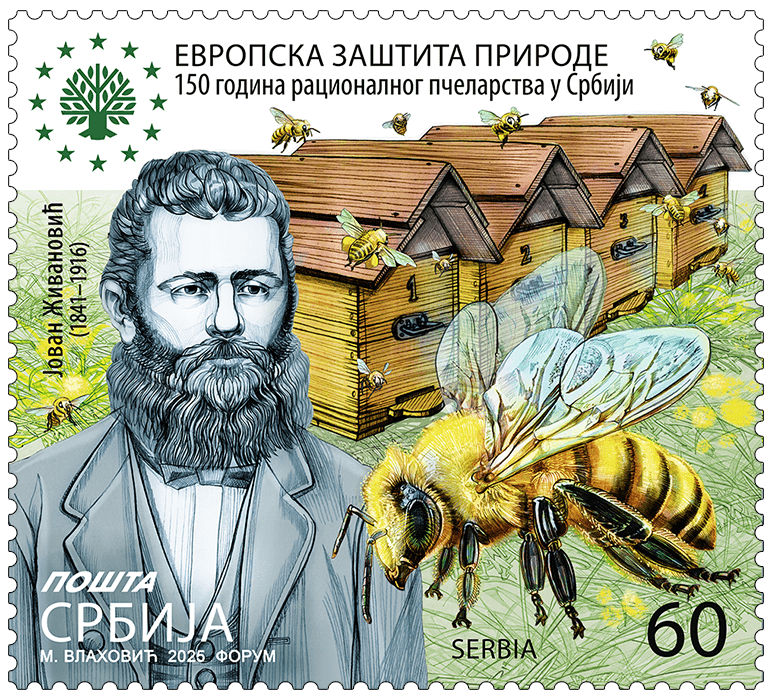
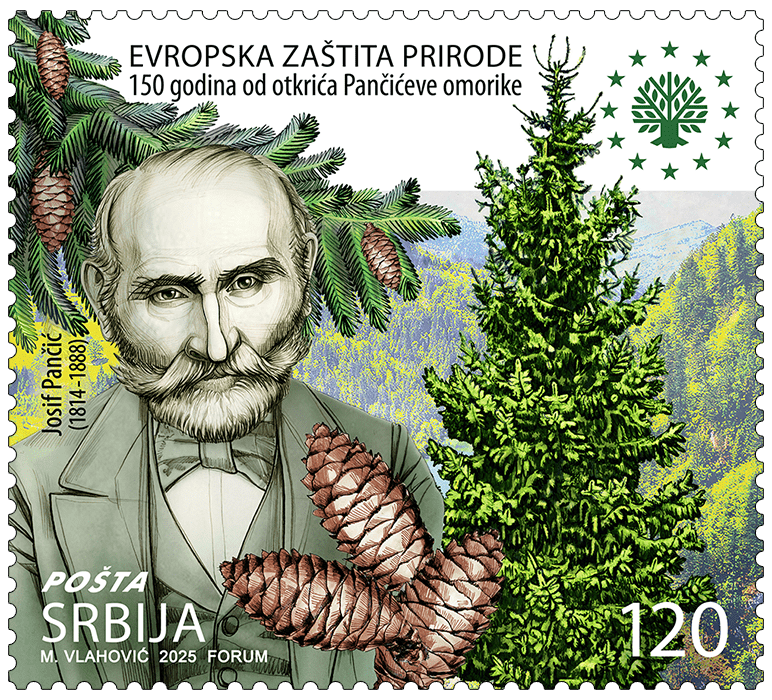
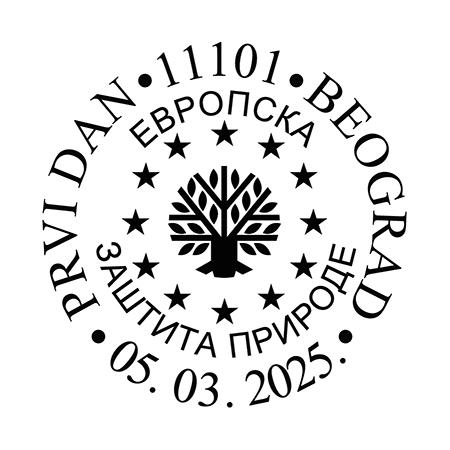
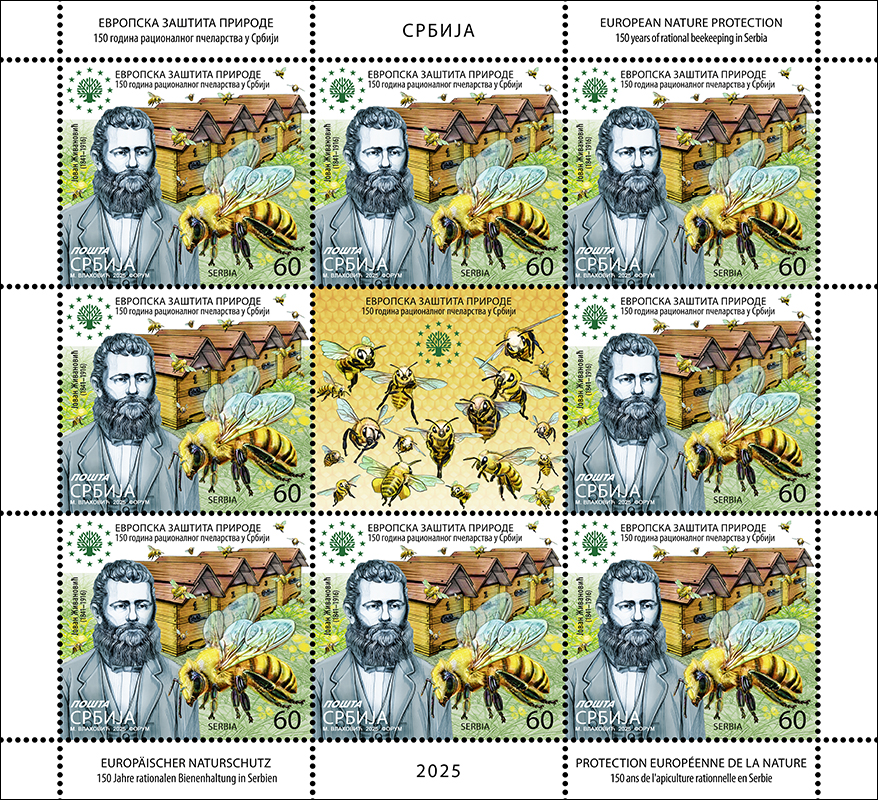
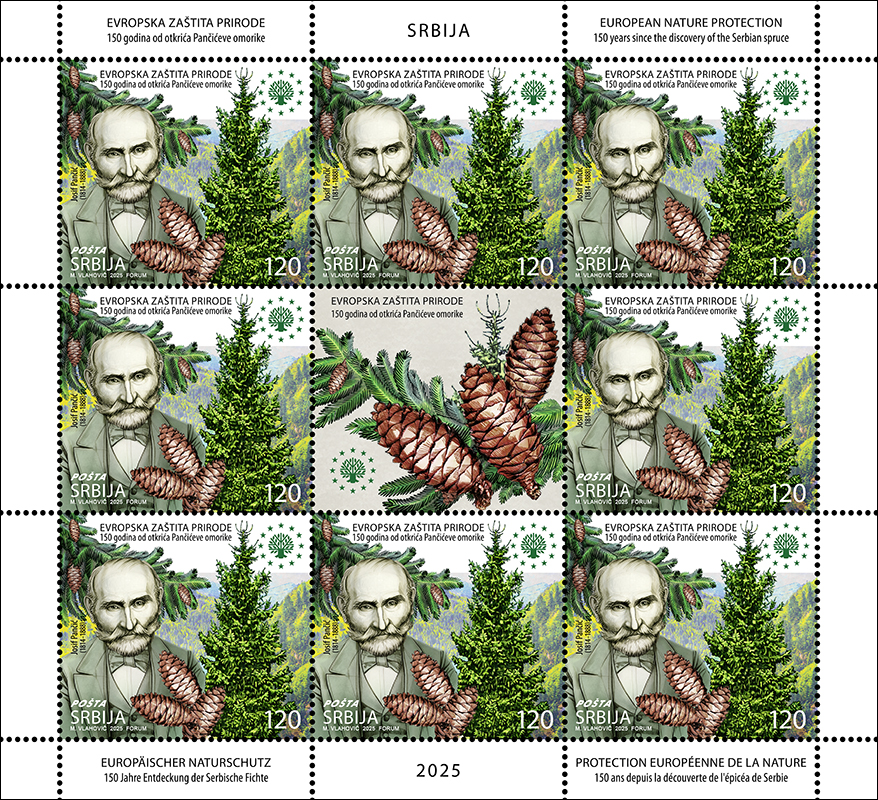
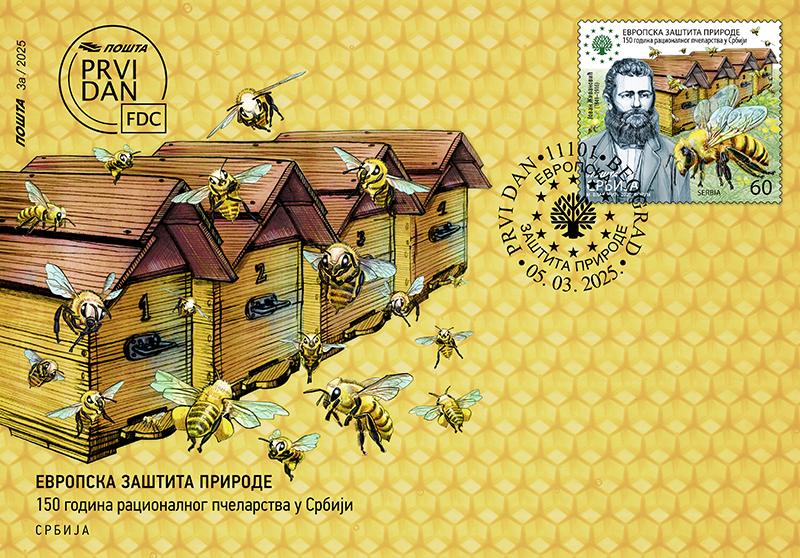
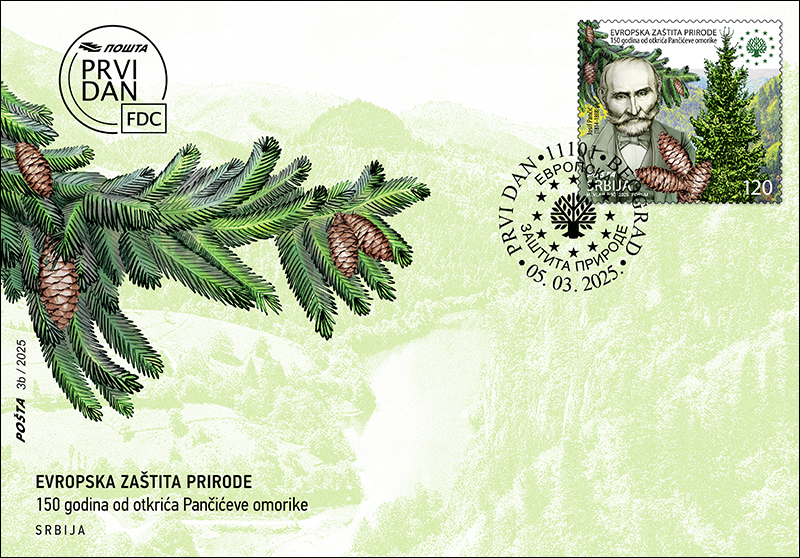
150 years of rational beekeeping in Serbia
Beekeeping is an activity of exceptional importance, not only for beekeepers and farmers, but also for the planet, because the bee is a key element in maintaining the balance of the ecosystem and preserving biodiversity and natural resources. The honey bee bred in Serbia is the so-called “domestic bee”, “western honey bee” or “Euro-African honey bee” (Apis mellifera L.).
Beekeeping has a long tradition in many cultures, and rational beekeeping is an approach to beekeeping based on increasing the efficiency of bee products production in accordance with bee health and the conservation of natural resources.
Professor Jovan Živanović (1841–1916) is considered to be the father of rational beekeeping in Serbia and the Balkans. He was born in Sremski Karlovci, where he completed elementary school and the Great Serbian Gymnasium, and after studying philology in Vienna, he was appointed as a professor of the Serbian language at the Karlovci Gymnasium.
For health reasons, he established an orchard near Karlovci, where, in 1875, he first encountered bees, introducing the first eight traditional wicker beehives. Instead of obtaining honey by suffocating bees, Professor Živanović, in search of new solutions, turned to innovation, so he contacted renowned beekeepers from Europe and the world and began to introduce advanced work technologies. He brought from Europe, but also constructed himself, the most modern equipment – the first beehive with movable frames – the so-called “American”, the Hruschka spinner for extracting honey, the first steam-powered wax melter and the first press for casting comb foundations in beehives.
Professor Jovan Živanović founded the second Department of Modern Beekeeping in Europe for students of the Karlovac Theological Seminary. He published a number of books and several magazines in the field of beekeeping, and in the vicinity of Karlovac he also arranged four apiaries with about 400 hives. With his work, he laid the foundations for the modernization of beekeeping in Serbia, making it more efficient, environmentally friendly and sustainable in the long term, thus leaving a permanent mark on the improvement of beekeeping practice, both from a technical and ecological perspective.
Professional cooperation: Danica Radović, Publicist, Beekeeping Museum Sremski Karlovci
Artistic realisation of the issue: MA Marija Vlahovic, academic graphic artist
150 years since the discovery of the Serbian spruce
Serbian spruce (Picea omorika) is a species of spruce, endemic to the Balkan Peninsula and a Tertiary relic. This means that this plant can only be found in a specific, small area and that it has managed to survive since ancient times (it is estimated that Serbian spruce has existed for about 65 million years). Because of these characteristics, it is known as a “living fossil”.
It was named after Serbian scientist Josif Pančić (a Serbian physician, botanist, and first president of the Serbian Royal Academy), who discovered it on Mount Tara in 1875, near the village of Zaovine. The scientific name of spruce comes from the local name for this coniferous species. Before the Ice Age, this species was widespread in Europe, and today it grows naturally only on the Balkan Peninsula, in the area of the middle stream of the Drina River and in the canyon of the Mileševka River, i.e. in western Serbia and eastern Bosnia.
The largest population in Serbia is located within the Tara National Park, which is why Serbian spruce is considered the queen of this mountain, and its beautiful, slender and elegant crown, which distinguishes it from all other conifers, has earned it the title of “queen of conifers”.
Serbian spruce has been on the Red List of Threatened Species of the International Union for Conservation of Nature since 1998. It was initially listed as vulnerable, and unfortunately since 2010, it has been declared an endangered species. All Serbian spruce sites have been designated as nature reserves and are cared for by the Institute for Nature Conservation of Serbia, and each individual Serbian spruce tree is under protection.
Expert collaboration: Institute for Nature Conservation of Serbia
Artistic realisation of the issue: MA Marija Vlahovic, academic graphic artist
Technical details
Date of issue: 05. 03. 2025.
Number of stamps in set: 2
Denomination:
1371: 60.00 RSD
1372: 120.00 RSD
Printrun: 15.000
FDC: 2
Sheet of: 8
Dimensions of stamp: 42 x 37,7 mm
Artistic realization: Marija Vlahović
Subject: European Nature Protection
1371: Jovan Živanović, the first beehive with movable frames – the so-called “American”, domestic bee (Apis mellifera L.).
1372: Josif Pančić, Serbian spruce (Picea omorika), the Tara National Park.
Perforations: 13 3/4
Printer: Forum Novi Sad
THE STATE-BUILDING PATH OF SERBIA
210 years since the Takovo Uprising
190 years since the Sretenje Constitution
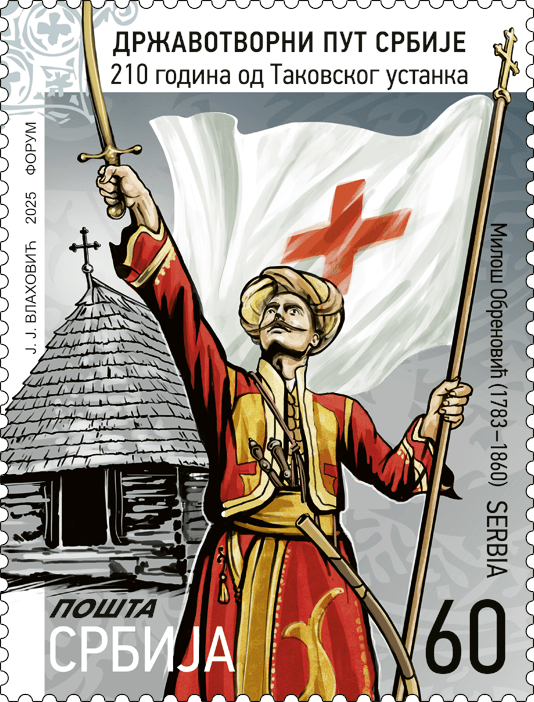
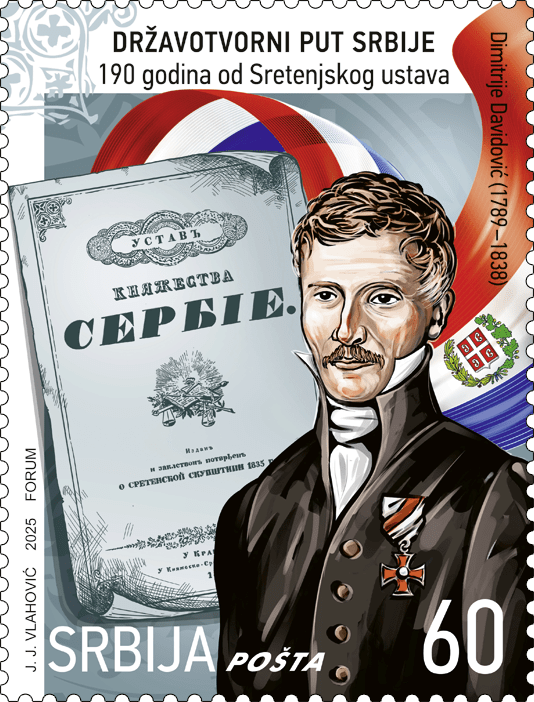
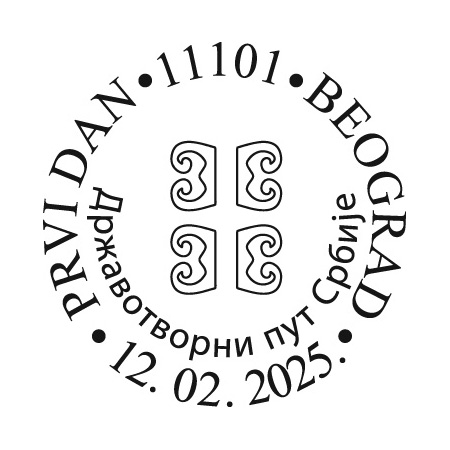
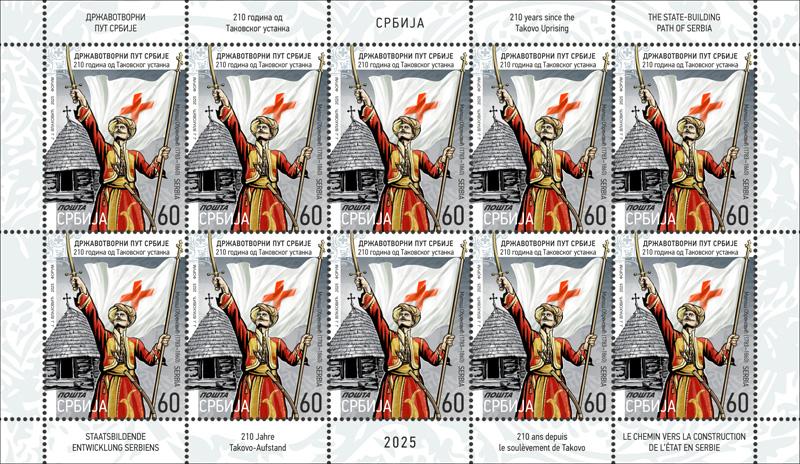
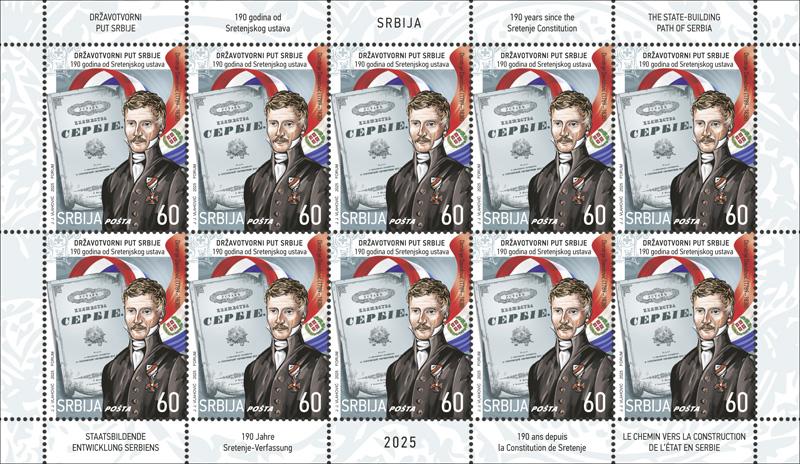
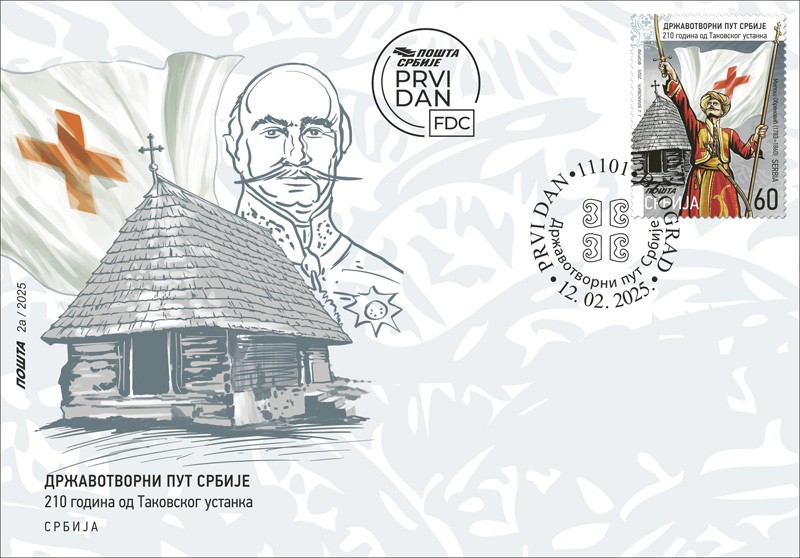
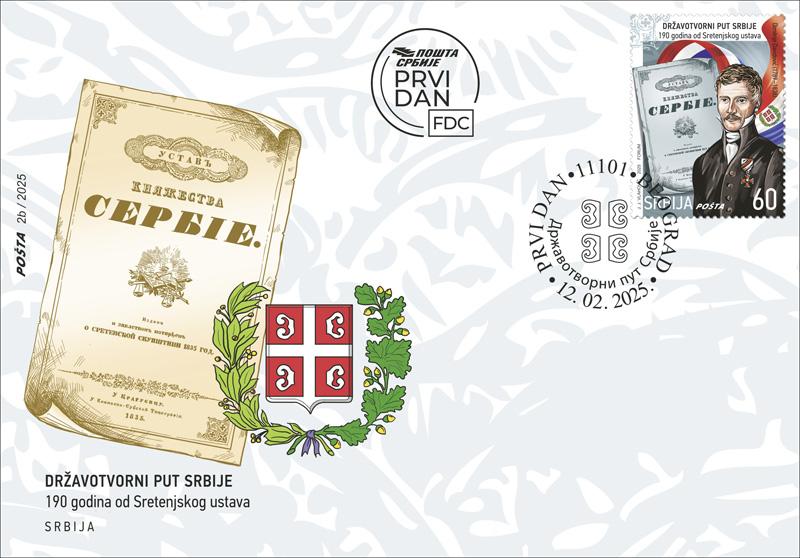
210 years since the Takovo Uprising
The Second Serbian Uprising is one of the most significant events in the process of creating the modern Serbian state in the 19th century. The uprising, the beginning of which was officially marked on the Palm Sunday, April 23, 1815 in Takovo, was the third and last in a series of armed movements within the Serbian Revolution (1804–1833). Its successful outcome created the foundations for negotiations with the Ottoman Empire, which were crowned a decade and a half later with the establishment of the autonomous Principality of Serbia.
The Takovo Uprising was prompted by the difficult living conditions of the Serbian population in the area of the Belgrade Pashalik in the years following the collapse of the First Serbian Uprising (1804–1813) and the failure of the Hadži Prodan’s Rebellion (1814). In response to the Ottoman violence, the national elders decided in the spring of 1815 to launch an uprising, led by the voivode and senior-chief Miloš Obrenović. After taking the ceremonial oath in front of the church log cabin in Takovo, the insurgents set off to battle. In the following weeks and months, a series of major battles followed, among which the battles of Čačak and Ljubić, the battles of Palež and Požarevac, and the Battle of Dublje stood out for their significance.
The rapid occupation of almost the entire territory of the Pashalik, excluding fortified cities, as well as the humane treatment of Turkish civilians and soldiers, enabled the Serbian leader Miloš to reach an oral agreement with the Turkish military commander Marashli Ali Pasha at the end of July 1815, which guaranteed the Serbs self-government in the Belgrade Pashalik. This agreement served as the basis for a long-standing diplomatic struggle for autonomy, which ended with the Sultan’s issuance of three hatt-i sharifs, in 1829, 1830, and 1833, by which Serbia acquired the status of a vassal principality of the Ottoman Empire.
190 years since the Sretenje Constitution
The first constitution of the Principality of Serbia was ceremonially proclaimed at the Great National Assembly in Kragujevac on Sretenje (the Presentation of Our Lord in the Temple) – 15 February, 1835. Its adoption was the epilogue of long-term efforts to limit the personal power of Prince Miloš Obrenović and establish the foundations of a legal state in Serbia. The success of the so-called Mileta’s Rebellion, at the turn of 1834 and 1835, forced Prince Miloš to accelerate the process of adopting the constitution, the author of which was selected to be the Prince’s secretary, Dimitrije Davidović.
Davidović’s draft constitution in principle envisaged the division of power into legislative, executive and judicial branches. According to the letter of the constitution, legislative and executive power was divided between the Prince and the institution of the State Council, while judicial power was entrusted to independent courts, which had yet to be established. The constitution was also remembered for codifying general national rights and freedoms, such as equality before the law and the inviolability of person and property. A special civilizational step forward was represented by the constitutional articles that prohibited slavery in Serbia and abolished the last relics of feudalism.
Inspired by Belgian and French models, the first Serbian constitution seemed too liberal to its contemporaries, and it soon encountered resistance from the Great Powers. Due to the liberal principles it proclaimed, it was displeasing to the so-called old order powers, Austria and Russia, while Ottoman representatives saw it as an act of violating the Sultan’s sovereignty. As a result, this “French seedling in the Turkish forest”, as the travel writer Cyprien Robert called it, was abolished 55 days after its adoption. Three years later, it was succeeded by a much more conservative, so-called Turkish constitution, adopted with the consent of the Turkish Sultan and under the patronage of the Russian Emperor.
Стручна сарадња: Борис Марковић, кустос историчар Историјског музеја Србије
Artistic realization of the issue: MA Jakša Vlahović, academic graphic artist
Technical details
Date of issue: 12. 02. 2025.
Number of stamps in set: 2
Denomination:
1369: 60.00 RSD
1370: 60.00 RSD
Printrun: 15.000
FDC: 2
Sheet of: 10
Dimensions of stamp: 31,9 x 42 mm
Artistic realization: Jakša Vlahović
Subject: The state-building path of Serbia
1369: Miloš Obrenović with flag of Takovo uprising, the wooden church in Takovo dedicated to Saint George, 1795.
1370: Dimitrije Davidović, front page of the Sretenje Constitution, Sretenje flag
Perforations: 13 3/4
Printer: Forum Novi Sad
CHINESE TRADITION
Lunar Horoscope – Year of the Snake
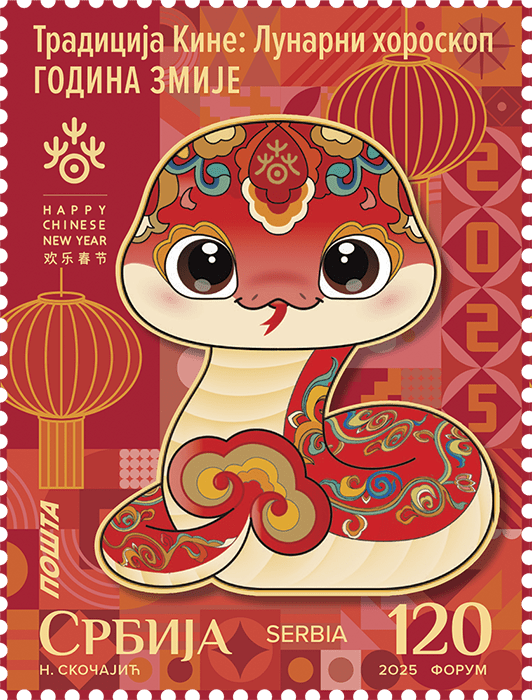
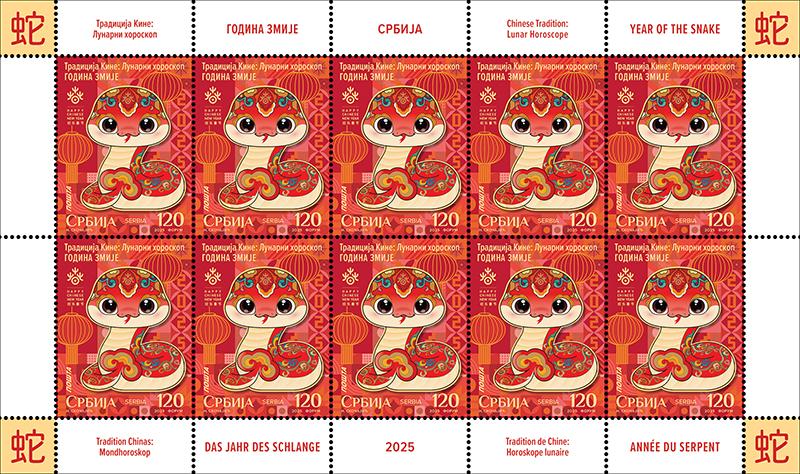
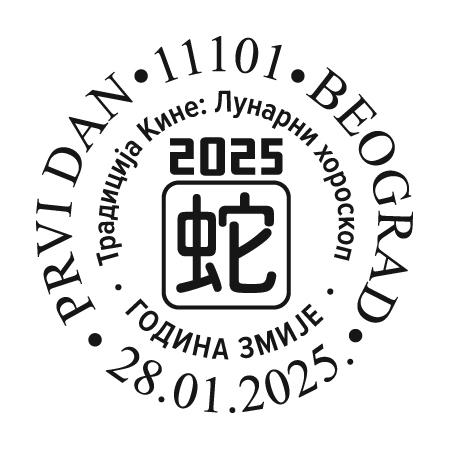
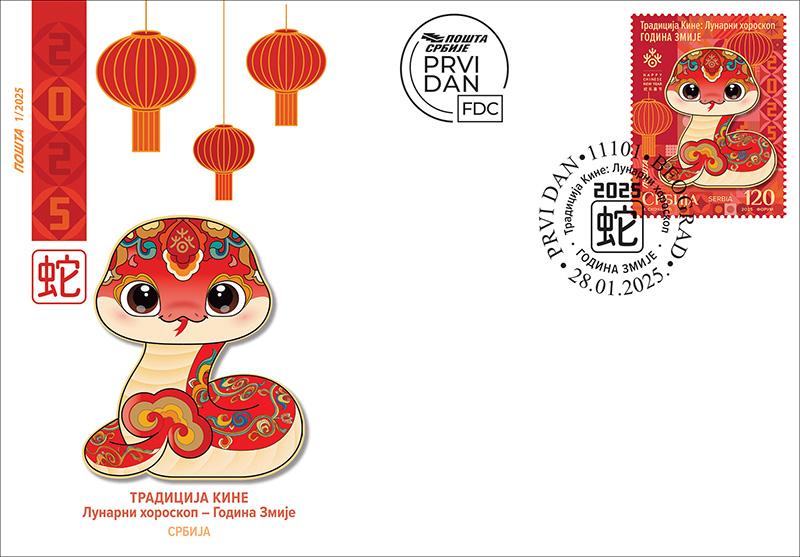
Chinese culture, thousands of years old, has given the world and humanity a precious cultural heritage and spiritual wealth. The Chinese horoscope is one of the oldest known horoscopes, including the mouse, ox, tiger, rabbit, dragon, snake, horse, goat, monkey, rooster, dog and pig. They correspond to twelve astrological branches, with a twelve-year cycle. In addition to the Chinese horoscope, the elements are also very important: metal, wood, water, fire and earth. The personality traits of a person are often closely associated with the characteristics of the Chinese horoscope linked to their birth year.
The year 2025 will be the year of the Wood Snake. The Snake is known for its enigmatic and introspective nature, analytical mind, and ability to deal with complex situations, and heralds a year full of opportunities for financial growth and new romances.
The Chinese Lunar year of the Wood Snake begins on January 29, 2025, marking the beginning of the fifteen-day Spring Festival celebrated by Chinese people around the world.
The material for the realization of the commemorative postage stamp was provided by the Ministry of Culture and Tourism of the People's Republic of China. Professional cooperation: Chinese Cultural Center in Belgrade. Graphic realization: Nadežda Skočajić, Academic Graphic Artist
Technical details .
Date of issue: 28. 01. 2025..
Number of stamps in set: 1.
Denomination:.
1363: 120.00 RSD.
Printrun: 25.000.
FDC: 1.
Sheet of: 10.
Dimensions of stamp: 31,9 x 42 mm.
Artistic realization: Nadežda Skočajić.
Subject: Chinese Tradition: Lunar Horoscope – Year of the Snake.
1362: Snake, Chinese zodiac sign for 2025
Perforations: 13 3/4.
Printer: Forum Novi Sad